Australian
and international
exploratory
performance and
media arts
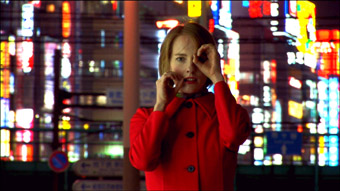
Shona Erskine, Will Time Tell? by Sue Healey
Sue Healey’s dance film opens with the question Will Time Tell? as its title superimposed on fuzzy horizontal streaks of a world flashing by. Fading into soft focussed closeup is a fair skinned woman (Shona Erskine) with brilliant red lips looking straight down the lens. Complicity with the camera is established.
She closes her eyes. Snippets of what might be memory abruptly interpose; of Erskine dancing with abandon in a scarlet coat on a massive outdoor wooden deck as if caught on coarse surveillance film by a camera on high, followed by a shot of ornamental carp languidly swimming, each scale etched in crisp focus. The dancer, still as a sign beside her, then stands feet planted on an urban Japanese rail platform as a train blurs in acceleration close behind. Its wind lifts her coat. The hurtling of the carriage flattens, becoming a restless field on the same plane as her stillness. Story-time is woven into being in the space between repeated multiple threads of visual and audio imagery. This film is a movement story of one woman’s travel experience. The stuff of time, its non-narrative materiality, is palpable in the juxtapositions of tempo mostly, but not exclusively, in edited human actions, choreographed and incidental.
The instantaneous momentum of the opening is arrested in a sharp focussed mid-shot. Erskine wearing a bright coloured 70s styled mini dress performs, with fingers like those of an orchestra conductor, a filigree of gestures carving sharp lines in the air. One stands out—her look back at us through ‘binoculars’ shaped by her hands in front of her eyes. This motif accrues weight as it pops up developed periodically by the five Japanese dancers Sue Healey worked with on her Asialink fellowship. It playfully evokes the continual observation of visitors to new places that travel prompts.
Is the narrative I read constructed by the film’s altering of human movement speeds and the rhythm of the edits, or are the grain, pace and colours, like the palette of a designer, meant for sensual appreciation? A Japanese dancer wearing a hoodie and the red-coated Erskine perform a smooth, delicate duet of immaculate unison in a Tokyo laneway. The choreography creates a shared time zone that bonds them, as pedestrians stride past unconcerned. This is time for reverie in a busy city street. This contrast between the pace and focus of the task-oriented pedestrians and meditative dancers is an entrancing compositional device in Will Time Tell? It returns later when the five Japanese dancers and Erskine fan symmetrically across a gravel avenue in front of a massive tori shrine gate, performing a gestural choreography with composure. Underpinned by a traditional sounding plucked instrumental and choral singing, tourists walk by, sometimes reversed in the edit.
Elsewhere, abrupt switches in music underscore stark edits. For example, koto-like strings cut to something like Japanese klezmah as our protagonist joins a man in a cafe by gently laying her head on white triangular-folded napkins set on a tabletop. As they sit up, the camera glides up and over from behind. It steadies on the relaxed dance of their hands, echoing each other’s shapes and grips in the warm dimness. There is a soupcon of voyeurism in the moment of touch. We see this male dancer next as one amongst five others, fishing in unison off a wooden boardwalk surrounding a pool in the middle of the city. The groups’ collective action is digitally interrupted, sped up and slowed. When images of the carp return, the camera lingers on the flowing rhythm of the fish.
Another jump cut takes us to a grainy Super 8 group portrait, the redcoated dancer included. They smile to camera as their eyelids close with imperceptible slowness. Is this a holiday movie grab from a Nihon vacation manipulated in the woman’s memory to embody a collective public meditation? Her intimate and gentle connections with people are tinged with the distance that travel compels.
Will Time Tell? vividly embodies the difference between time ‘for’ and time ‘to act.’ Periods for contemplation jostle with times to meet and be with others.
The film concludes with two contrasting vignettes. Reminiscent of a 19th century paper-cut miniature, Erskine’s wind blown silhouette dances on the crest of a paved hill against the smokey pastels of clouds just after sunset. In one long shot and in one dance she draws together fragments of movements glimpsed earlier. An aeroplane, rendered tiny in this wide shot, traverses the sky. The oompah of an organ grinder ushers in the end—a man places Erskine’s dress, red coat and shoes on a tailor’s mannequin for sale on a Tokyo street.
–
Will Time Tell?, a film by Sue Healey in collaboration with performers Shona Erskine, Ryuichi Fujimura, Makiko Izu, Mina Kawai, Yuka Kobayashi, Norikazu Maeda, director of photography Mark Pugh, composer Ben Walsh, editor Peter Fletcher; 2006
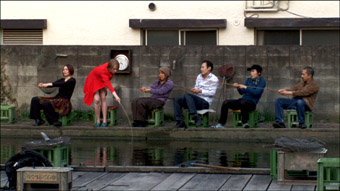
Will Time Tell?, Sue Healey
In her dance film, Will Time Tell?, Sue Healey follows a woman’s journey as she explores an alien city in which she is an obvious misfit. Time is manipulated and transformed around this lone figure, through jump cuts, slow motion and reversals, as she discovers new faces and places in a world that is unfamiliar. She wears a bright, blood-red coat: the deep, velvety hue is reflected on her lips. Peering into the lens, her hands delicately placed around her eyes, inquisitively looking through these hand-made binoculars, she views a foreign landscape.
in this 12 minute experimental film Healey investigates notions of time—how time can change our perception of place and how place can alter our sense of time. Time is discombobulated and morphed within a constant flux of images. The film opens with colourful sweeps of light, moving past at hyper-speed. Horizontal streaks of light flicker over the film’s focal subject, dancer Shona Erskine, her pale face lingering before the film cuts to an image of a speeding train—its details then becoming lost, blurring in and out of the frame.
The train, both friend and foe to the weary traveller, is an image repeated throughout the film. In one episode, I brace myself as I am taken on a joy-ride, the camera in the front of the train confronting its viewers with a fast forward wide shot. Like IMAX or virtual reality cinema, the screen seems to engulf even the peripherals of my vision and pull me into its world. I am out of my comfort zone: a music box plays as the audience is sped through the city in a flurry. Relief, the focus changes, back to observing. The red-sheathed figure, distinct in an environment of colourful fragments, intersects with others on a trajectory through time and space. Erskine forms brief relationships, which are all too quickly broken. Prolonged connections are rare for the lone explorer.
Though isolated, the woman shares a brief intimacy. In a tiny, seemingly claustrophobic restaurant, a man sits by her leaning on a small, rectangular table pressed against a window. They are soaring, sitting on the edge—observing, resting and folding napkins in nervous excitement. From a high-angle, over-the-shoulder shot we witness this awkward yet cosy interchange. The camera angle cuts to a view from directly behind, Erskine turning to us with a coy cheekiness as hands intertwine in an elegant dance with this stranger. They fold, overlap and tenderly touch, for a moment withdrawn from a frenzied, tumultuous world.
In another atypical moment of tranquility, in a little paradise in the hub of the city where the noise of the metropolis is stifled, carp bubble and splash in a man-made pond. The camera follows Erskine and others in a slow motion pan as they sweep their fishing rods across the water, in sync with perfect parallel spaces between. The sound slows, changing from an effervescent vaudeville-like tone to a light, calming one. The shift in dynamic makes Erskine and audience drowsy. We empathise with her—restless, jet-lagged and impatient—as she builds a makeshift bed out of three milk crates and fidgets to make herself comfortable.
Erskine awakes to navigate her way once more through this obscure, elaborate urban maze. She dances among others, though this time she is not the central focus. She is situated right of frame in a wide shot of a serene park in vivid contrast to the mechanics of the city. The dancers, in ordinary street clothes, move through a series of simple gestures, which when performed in unison create a dramatic choreographic structure. Erskine’s sweet, subtle gestures juxtaposed with her expansive, wild movements, take her body on an adventure that leads her onto a hill top at sunset. Her silhouetted figure, positioned centre-frame in a wide angle, un-edited shot, dances her last dance, a silent goodbye.
The shot changes: the dancer’s clothes remain but she has vanished. A shop mannequin is dressed in what once was Erskine’s, her experiences and stories now seemingly lost. Sue Healey’s Will Time Tell? has followed a woman and seen her sucked into a cultural vortex where she finds herself immersed in yet simultaneously cut off from a bizarre utopia.
–
Will Time Tell?, a film by Sue Healey in collaboration with performers Shona Erskine, Ryuichi Fujimura, Makiko Izu, Mina Kawai, Yuka Kobayashi, Norikazu Maeda, director of photography Mark Pugh, composer Ben Walsh, editor Peter Fletcher; 2006
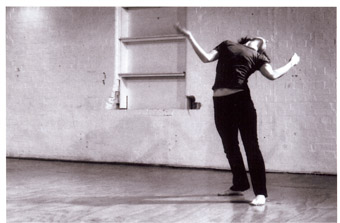
Nalina Wait
photo Andrew Whoolley
Nalina Wait
Nalina Wait is positioned in a set of perfect right angles, every hinge. Elegantly clad in soft, feminine green, her dress is modest yet exposing. Her limbs are milky soft, barely illuminated beneath a blanket of darkness. A lamp to her left leans over her. Its shade is inquisitively tilted, on the brink of toppling. The dancer’s fingers move to the lamp—it comes to life. An oscillating sound score emanates from the dark, croaking and vibrating like a mechanical insect.
The dancer’s body begins a gradual metamorphosis. The light floods, transforming Wait’s skin from a shade of pearl to warm amber. She moves through a chain reaction of twists, coils and circles which begins at her crown and end just beyond her toes. In a blend of tension and subtle calm the dancer’s tortured body is ironed into the floor. For an instant she seems to slip into an unconscious state before peeling herself from the surface. Has a slumber engulfed this helpless body or is Wait the subject of her very own lucid dream?
Suddenly on her feet, Wait moves rapidly downstage, her gaze skimming my head. Her body freezes with a numbing stare. Sporadic outbursts of flicks and flinches escape her as the ceiling lights clunk, grind and flicker on. Wait constantly arrives at a neutral stance, yet simultaneously fails to ever reach a climax in her moments of physical eruption. She is pulled through space by an external force; her limbs jolt and ripple as if wrenched from her torso in intermittent bursts. Possessed by her own nightmare, she is stolen.
In a post-performance discussion Nalina Wait says that she was influenced by the notion of “arriving and never arriving.” This is reflected through her choice of motif and in the dynamic of the work. Her body constantly struggles between stillness and spasmodic physicalisations. Much like Wait’s improvisations I’ve seen previously, the sense of presence and the movement quality of this performance are entrancing. Her dynamic shifts of weight create a mood of edginess and surprise. Much of this movement quality reflects the industrial, raw and eclectic noise of the guitar-based sound score—something new for Wait, who usually dances in silence.
Moving though a dance between her physical self, an invisible being and the floor, Wait slices the air with energetic tosses and breaks it with radical stops. What is being portrayed? Wait says that “embracing more of the psychological rather than anatomical elements” was of particular interest to her. She demonstrates this through her focus and a commitment that allows for momentum behind the movement. The choreographic detail appears to emerge more from sensation than aesthetic concerns.
Against the minimal setting of an empty room and a lamp, Wait’s movements are larger than life. Her deep lunges and abrupt foot work interweave in spirals of motion. It’s as if she’s dancing a duet with the lone lamp, detached but communicating inaudibly with it. She holds a secret she will never reveal to us. This shy object baffles me. Is it simply a lamp or is it a transportation device to take the dancer from one realm of existence into the next?
Wait’s breathing overrides the fading music, but her body resists, dancing on in silence. She gasps for air but eventually surrenders, returning to sit by the lamp. She stares, ghostly.

Nalina Wait
photo Andrew Whoolley
Nalina Wait
In a large, half-lit space, Nalina Wait sits by a standard lamp with a white, pleated shade. Her torso is straight, almost rigid, leaning backwards, slightly. Her left hand searches for the light switch. The lamp exudes a warm, golden glow, the shade tilted at the same angle as the dancer’s torso. Slowly, she turns her head upwards, allowing it to be bathed in light. She continues the circular motion initiated with the head, letting it travel through her body in a downward spiral towards her feet. These seem to have a life of their own, gingerly stepping away from the rest of Wait’s body, which soon follows, languidly moving across the floor into standing. Against a subtle electronic soundtrack, Wait is now in the dark, backlit by the lamp. She has utmost control over her body. And yet there seems to be a mysterious force at play that is larger than herself.
Suddenly, Wait forcefully strides forwards, stopping close by her audience as if to confront them. At the same time, a battery of overhead arc lights noisily clang to life and a loud guitar-driven soundtrack invades the space. The shift in intensity is enormous. The space is now completely transformed, both visually and sonically. Wait also appears changed. She looks straight ahead, into the distance. Her body jerks into action. Her legs are still planted solidly on the ground but her arms, head and torso are flung violently in different directions, exploding away from the body’s centre. The bout only lasts a few seconds and stops as abruptly as it started. The dancer returns to staring into the distance. Her expression is stoic, defiant even. It’s as if she is willing her body to be still, but to no avail: it erupts into another burst of out-of-control, short, sharp movement. More outbursts follow, never lasting much longer than the first and always succeeded by a moment of stillness. These function as both moments of respite and preparation for the next body explosion.
From time to time the soundtrack cuts out, only to resume its sonic assault soon after. The pattern of alternating movement bursts and intermittent stillnesses continues, relentlessly. Over time, the movement explosions seem to lose some of their sharpness, Wait’s body softens slightly. Her legs are not rooted in the ground as solidly as before, the knees are sagging, allowing for deep lunges and, at one stage, a roll on the floor. Is this exhaustion taking its toll or has the dancer succumbed to the violent movement attacks, resisting them less? Gradually, she moves backwards, eventually reaching the lamp and sitting next to it—exactly the position in which she began. She turns off the lamp; immediately the arc lights go out. Darkness again.

Martin del Amo, Anamorphic Archive, video still
Sam James
Martin del Amo, Anamorphic Archive, video still
Dancer Martin Del Amo steps partially into frame. His right palm draws out his arm to full length, pulling his body into the black space. He is a small figure inhabiting the background, dressed in white trousers, long sleeved shirt and braces. He is a white figure moving left from the edge of the frame towards the centre, arms at length away from his body. He repeats a movement of arm to the sides: right, left, left then right, palms facing the camera. His legs move on a lateral plane: apart then together, in equidistance. It is an act of precise positioning. Function with form: a body knowing where it is going, where it has been. And yet, on this screen, a dancer seemingly displaced.
Anamorphic comprises eleven short dance films produced by dance filmmaker and video artist Samuel James. Martin Del Amo’s work features amongst the work of other Sydney performers. James the documenter of these originally live works, has disturbingly treated and distilled the essence of these performers dispossessed of their performance locale. With Del Amo there are several drafts of a man stepping into and dissolving on screen, a man in all his measure. The doubling of his background image occurs early in the film, a second figure emerging out of step with its identical counterpart. A second del Amo is foregrounded, moving on the same plane. The facial expression suggests a being entrapped by a system of straightened arms spoking out from the torso, legs opening and head turning rapidly, relentlessly. Del Amo appears to seek depth in these separate tracks of flattened perspective and movement. We glimpse in his face a desire for respite, for change. A new arm movement traces a path into his body interrupting the sideways back and forth trajectory. The image deepens in dimension. A split screen halves the foregrounded dancer. The vertical line as axis placed over his midline invokes a third less defined del Amo who issues forth from the internal spaces of the front man. The trebled image induces an image of a tireless trio.
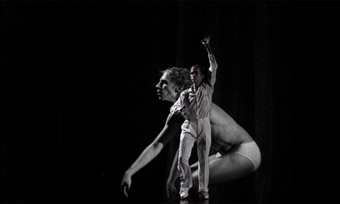
Martin del Amo, Anamorphic Archive, video still
Sam James
Martin del Amo, Anamorphic Archive, video still
Despite the repetition of movement, the pulses of these reproductions are neither regulated, nor stable. Del Amo’s head shakes intermittently as a result of James’ digital manipulation. It is a mark of subtle transgression. There is an overall sense that James’ post production assists Del Amo in his emancipatory action against the weight, direction and intensity of the situation. All these extra del Amos are supplied by James as versions varying in resolution, perspective, scale and colour. They arrive and leave the space with different intentions. Which one will be left to bear the consequences of this invisible assault? Under Attack, the original live work by Del Amo provides a fourth mostly naked del Amo: his sweating kernel emphasising the laboured process. The black and white image gives depth to the flattened perspective. He teeters on self-defined edges, his swinging torso unconstrained, no longer bound to any vertical axis. The other del Amos take their exits one by one. There is a sense of relief in this presence, like an authentic gut reaction to a problem which lies undefined. The dancer’s movement takes its shape from the rib cage which hovers over a well anchored body. He stands still with the visual hum of breath and looks out at an angle. There is resignation and a glint of defiance. He walks out of frame.
Sound Artist Gail Priest furthers the accumulation of this unfolding of a man under stress, a man aiming to get it right, with a sound suggesting repetitious, mundane purpose. A constant ache echoes within a machine’s industrial joints. As the inner del Amo extrudes, a violent tapping on a violin, highly strung, grows in fractals like a rash ad nauseam, invoking psychological tension. Both Priest and James in their applications of repetition show the devolution of a man within the promise of an unshakeable structure: he knows where he is going, what has been, but the present is unsettling.
Del Amo is like a little Russian babushka doll. At first the film’s form suggests ‘a similar object within a similar object’, but Sam James’ masterful manipulation of bodies in the dimensions of a filmic space makes complex the notion of peeling away outer layers. The inner emerges resolute through imbalances of scale, black and white costume in colour against black and white film, a split screen and superimposition. While the original live performance may remain a mystery to the film’s viewer, del Amo’s experience is distilled by his documenter, reconstituted and placed in new configurations: scattered little babushkas.

Shona Erskine, Will Time Tell? by Sue Healey
A woman in a red coat stands still on a street corner as traffic passes in front of her. We see her again as trains pass behind her; neon lights flash. She dances a jig along a travelator, moving the wrong way. She is seen in the grain of slow motion super8 film, alone with shoes off, leaping, turning and running. Sue Healey’s dance film, Will Time Tell? offers a view of passing time through the speeded up and slowed down journey of this woman in red against the background of Tokyo. Yet, in the director-choreographer’s approach to the theme of time, it is movement, in all its many forms, that is most strongly focused on.
The film opens with shots of the woman, dancer Shona Erskine, seated on a train, the flicker of colours from a window reflection trailing across her face. These shots are interspersed with Erskine performing a precise gestural sequence. With her hands forming alternately into binocular and camera shapes and neatly rearranging them across her face, Erskine shapes her vision or mimes the gestures of tourists, whose view is so often framed photographically.
Another scene has Erskine looking directly at the camera, laughing and approaching it with familiarity. These opening scenes are filmed on Super 8, evocative of the amateur footage of holidays past. This look and Erskine’s short shift dress, all paisley-like swirls, could place her in the 60s. She is positioned against the Japanese background with her pale skin and bright red lips as an outsider, but the choice of costume seems to locate her as slightly out of time too.
The high definition scenes, however, locate the film firmly in the present, and also introduce the play with speeds within the frame. We see Erskine, still but for the jerking movement of her arms, at a train station, while trains and people appear and disappear in fast motion around her. She could be conducting traffic or simply being moved by all this bustling energy. Later, there is a slowed down tai chi like movement sequence performed by a group of Japanese dancers, with pedestrians passing by in real time. In most of the scenes, Erskine is seen slow against the backdrop of fast or real time motion of the outside world. Again, she is the traveller/outsider.
In a post screening discussion of Will Time Tell, Sue Healey noted that although the film began as an experiment in shooting in external light out of the studio, it is, like much of her recent work, preoccupied with notions of time. For a dance film (a hybrid of forms in which playing with time seems unavoidable) this concept seems a complex undertaking. However, Healey takes a compositional approach, each scene having a specific reference to time through speed, rhythm and directionality, as well as references to clichés such as ‘time stood still’ or ‘marking time.’ There is the literal journey of the traveller, of trains coming and going, but also a journey in the cinematic narrative sense, with Erskine as central character in a foreign city.
What emerges is a film that is not unlike a travelogue, dealing in the currency of memory or nostalgia that we are used to seeing on the screen. In particular, I am reminded of those tourism advertisements for Melbourne where a lone woman reminisces on her visit, as we see shots of her wandering streets, meeting with friends, eating, laughing and drinking. But Will Time Tell is much more than this. There is the framing quality of Ben Walsh’s Japanese sampling soundtrack, the sheer radiance of Erskine’s cinema screen presence, and most of all Healey’s interest in choreography.
There is something about travelling in a foreign country and not understanding the language which makes movement and gesture apparent. Sue Healey’s film captures this sense of travel, through the large-scale organized movement of trains and crowds to the particular details of friends meeting. In one scene Erskine is pinned against a fence, awkwardly close to a group who perform an intricate choreography composed of the gestures of shaking hands, greeting and laughing. Erskine’s physically cumbersome presence highlights the sense of outsider through the particularity of movement in what would otherwise be a familiar scene.
The aspect I most enjoy in Will Time Tell? is seeing the fine precision of movement in Healey’s dance vocabulary set against the wider, incidental movements of Tokyo, the city and its inhabitants. This recontextualising of the dance within this cinematic background allows a broader, more nuanced reading of Healey’s choreographic terrain.
–
Will Time Tell?, a film by Sue Healey in collaboration with performers Shona Erskine, Ryuichi Fujimura, Makiko Izu, Mina Kawai, Yuka Kobayashi, Norikazu Maeda, director of photography Mark Pugh, composer Ben Walsh, editor Peter Fletcher; 2006
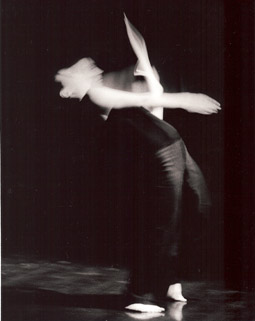
Nalina Wait
photo Heidrun Löhr
Nalina Wait
Nalina Wait’s audible breath in the throes of a final paroxysm is powerful. As the discordant, nervy loudness of a frenetic guitar is silenced by the presence of this laboured breath, a palpable intimacy is felt between the dancer, her audience and the finding of a dance. Wait hardly traverses the massive elongated space of the Drill Hall, but her breath thwarts this notion of visible distance, reminding us of the physical effort in negotiating the topography of an inner landscape. Through means deliberate and considered, Wait’s short work attempts to disclose hidden elements of her self, to herself, in the unpredictability of performance.
In the beginning she sits perpendicular to the floor, delicately composed with legs stretched outwards and torso slightly tilting. Her angle complements that of a standing lamp, its concertina shade slanting on the same vector. The soft rotation of her head leads the torso to hinge from the hips, lightly anchored by her lower body. Wait’s orientation shifts, deepening this hypnotically paced movement. Her feather like extension is paradoxically grounded by the astute instinctiveness of a body that knows its structure.
Night sounds are evoked by a metronomic ticking. The concentrated circle of light from the lamp that balances the contrast between darkness and Wait’s creamy skin is extinguished as the overhead house lights turn on. Their reeling flicker eventually illuminates the room. The recording of an electric guitar played atonally is intermittently switched on and off instigating fitful dance movement and sudden twitches from Wait, punctuating her stillness as she stands in close proximity to her audience.
Moments where Wait is ‘overcome’, by an internal emotional force or an almost Tourette-like disorder, accumulatively intensify. Her first phrase, however, emerges as though her body is undergoing an external attack: the left elbow bends, drawn out of the body; the head strains away, tipping her entirely off centre though still rooted by legs moving in varying configurations of open second. She re-gathers by moving her feet into parallel, her tilted torso negotiating the horizontal, swung out by arms, brought in by a contraction at the centre with a single knee rising into sculpted flexion. Occasional peace in the delirium is also arrived at through bobbing down: upper body meeting lower body, or weaving arms toward her midline to escape peripheral forces.
Towards the end of the guitar track Wait begins to retreat upstage, the self-gathering lessens, the body unravels, yet still teetering on the threshold. She has arrived, for the moment. Her coda is the breath score, a final image: her original position next to the lamp. As the overhead lights and lamp are switched off we are left to feel that there was never to be any resolution, just respite from the sporadic concertina folding and unfolding of internal states. Her ending merely suspends the inquiry.
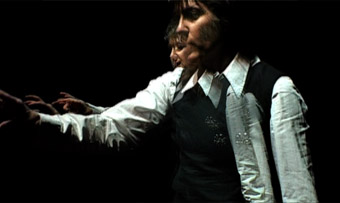
Rose Dennis, Anamorphic Archive, video still
Sam James
Rose Dennis, Anamorphic Archive, video still
In his remarkable new dance film project, Anamorphic Archive, dance filmmaker and video artist Sam James digitally manipulates documentary footage of live dance performances to create filmic reinterpretations of the original works. One of the most striking examples in this impressive collection, comprising eleven short films, is James’ treatment of footage documenting Rosie Dennis’ 2005 work Access All Areas.
Dennis, clad in the uniform of an office worker—white blouse, blue vest, blue skirt, brown shoes—strides through a large space framed on one side by a black brick wall. The footage, including the audio track, is slowed down, Dennis’ footsteps on the dark floorboards echoing ominously as she walks forwards as well as back. There is something eerie about this opening sequence. Slowing down the footage gives the performer a menacing presence. Is this is the calm before the storm?
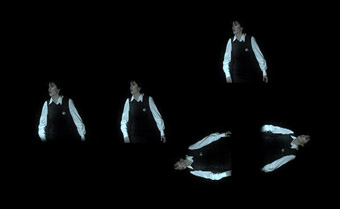
Rose Dennis, Anamorphic Archive, video still
Sam James
Rose Dennis, Anamorphic Archive, video still
It sure is! The next section could not be more different as far as pace is concerned. It accelerates Dennis to top speed, both physically and vocally. It’s as if a previously dormant volcano has unexpectedly erupted. She frantically shakes her head, the right arm stretched out in front of her, also shaking. Sharp intakes of breath give her voice a percussive quality. She continuously repeats the phrase “I don’t want to touch what the majority touches.” The speed at which she moves and speaks is dizzying. All of a sudden, her image multiplies. There are now three versions of her, each one layered on top of the other, several frames out of sync. By splitting the performer’s image into three and having them each reverberate against the other, James powerfully emphasizes the manic, obsessive-compulsive quality of a Rosie Dennis performance.
Usually, the main objective of the archival documenting of live performance is to preserve the works, making them accessible to viewers long after the actual performance. With Anamorphic Archive, James subtly subverts this notion. His work begins where other archivists stop. He uses the documentary footage as source material for his own artistic endeavours. Taking the liberty to change the framing and timing of the documented live performance, James reinvents the original, creating a new, autonomous work in the process.
It is James’ great achievement that, even though he manipulates the documentary footage entirely according to his own artistic vision, he manages to capture the essence of the original works. This brings up the question: can Anamorphic Archive only be appreciated by those who have seen the live performances on which the films are based? The answer is inconclusive. The results of James’ digital treatment are so accomplished and sophisticated that the films certainly can be enjoyed as independent works in their own right. On the other hand, there is definitively an added joy in being able to see to what extent and effect James has altered the original performance.
The live version of Rosie Dennis’ Access All Areas, for example, is a model of conceptual rigour, choreographic economy and performance skill. At first glance, it is difficult to imagine how such a finely tuned work can possibly gain through digital manipulation. And yet, by creating images that exemplify the inner turmoil of Dennis’ troubled office worker, James succeeds in adding a dimension that cannot be achieved in live performance. One section in the film is particularly memorable in this respect: five images of Dennis are positioned in different places on the screen, all in sync. Dennis moves at the same breakneck speed as in the earlier section described above, but the sound has now been removed. With her gunfire vocals silenced, her franticness appears strangely softened. The images are then rotated at different angles, appearing to float freely against the black backdrop of the screen. It’s as if Dennis has lost her footing, drifting in space, alone, lost to herself and her viewers. Her head is still shaking, circled by one of her hands, desperately searching. Suddenly, the images of Dennis multiply again. Serialized in eight rows of 12 small images each, now there are almost a hundred incarnations of Dennis.
The title of Sam James’ dance film project refers to the phenomenon of anamorphosis, describing both a distorted image that appears normal when viewed from a particular point or with a special device and the process by which such images are produced. Creating new films by digitally distorting their documentary source material, James offers audiences a new perspective from which to view the original works. As is the case with his take on Rosie Dennis’ work, James does not abuse his role as the all powerful manipulator. He tries to stay true to the intentions of the dance makers. It is his interest to illuminate rather than to obscure. The sensitivity with which James approaches the manipulation process prevents his reinterpretations from competing with the originals. The films are distorted reflections of the live works, neither one more real than the other.

Nalina Wait
photo Heidrun Löhr
Nalina Wait
A body, all twitches and flung out limbs, creates crackling shapes against a black curtain; a body jolted into action by some unseen force, the motion constant, driven. Another body, still with eyes fixed on the wall behind us, is drained of potential movement, rooted to the floor. In the central section of this five-minute performance, Nalina Wait jump-cuts between these two bodies. There is no sense of arriving, but of having already arrived at one state or another. There are no transitions, no preparations, none of the in-between steps common to formal dance. It’s all or nothing. I see two Waits, overlayed: the still and the moving.
Wait’s performance begins with her sitting on the floor, her legs outstretched and torso angled back, next to a standard lamp. She flicks it on, and begins a slow rotation of her head. The sound score evokes insects in summer heat. Wait slowly winds herself to face away from the lamp, rolls to the ground, keeping her limbs long and straight, and pulls herself back to sitting, lead by her fingertips. She sustains this taut straightness, a drag of limbs against the ground, to standing.
The soundscape cuts out and a rough, loud guitar squall takes over. The overhead arc lights individually grunt their presence, cueing Wait to break her movement. She walks directly to the audience, and stands in confronting proximity. Her gaze is out, directly over our heads. A shockwave of movement erupts, head back, elbows flung out, fingertips charged, then halts into stillness. Wait splices between these two states, on and off. The movement builds, taking over; the stillnesses contract. Wait is in and out of sync with the sound. The movement takes her backwards towards the lamp. She stops and sits. The lamp and lights flick off.
I declare my interest. I have worked with Nalina Wait over intensive periods in the last year on her new work, Dual, and have watched her dance, responded to her dance and tried her dance on. I feel familiar with the rhythm, impetus and arc of her dancing body. Yet, on first watching in this turned round position of reviewer, I feel stumped. I’m not watching the dancing body. I’m looking for grand narratives, meaning. I’m mixing up personal information with what is actually happening. The lamp evokes a domestic setting. Who is her intensely fixed stare focussed on? At whom is the twitch, jerk, coil and recoil of her movement directed?
Wait repeats her performance. I am glad of a second viewing. This time I watch the body, its tone. There is an elasticity in all her movement. In the opening passage, the skin is stretched taut, resisting an impetus or fire. I am taken by the small release of this tautness as the music changes and Wait walks forward. The centre section is also fired by this elasticity. Her limbs are flung out from her body but are always retracted, arcing back in, seeming to provide an internal engine for more movement. There is tension, not only between stillness and action, but also in the movement itself. Apart from the small moment of change in the music, it is never quite released.
This tension suggests the kind of psychological state in which Wait, post-show, declares a new interest. Her dancing body seems to evoke possibilities of emotion, while never settling on any stable reading. But the overt duality of frenetic movement and dulled stillness suggests more subtle resonances of interior/exterior and conscious/subconscious. What I find most compelling about Nalina Wait’s performance is her ability to jump directly between these states.
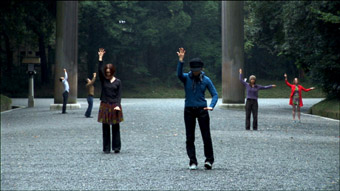
Will Time Tell?, by Sue Healey
Will Time Tell? is a delicately crafted, episodic dance film directed by choreographer Sue Healey. It is the tale of a traveller who remains the tourist, never fully sinking into the landscape into which she journeys. A hand held Super8 camera takes grainy holiday shots, cutting across the clarity of digital technology used elsewhere, reminding me I am watching a film, keeping me distanced from the seductions of narrative. Clear manipulations of time, so do-able in mediated art, create a contiguous but choppy story that meanders, developing from the speeds at which people move. In this world meaning is time. Disturbingly, a mist of colonialism lingers around the woman, archetypal in her blonde whiteness, her vivid costuming, her anonymity and her alienation as she swishes through urban Japan. Remaining apart, she seems voyeur to her own action. Will there be a re-assuring embrace? Is she an apparition?
Sue Healey casts dancer Shona Erskine as the stranger in Tokyo. Her startling red costume is unsettling in its domination of the tonal palette, its searing colour mitigating against subtlety and complexity. It screams at me in every scene. But this costuming choice does transform Erskine into a superimposition, keeping her slightly unreal; separated from people, place and shared time. A train rushes behind her, blurred into abstraction: she is steadfast and still against this speed and the world behind her is made pallid against her loud and stolid tones. She is alone.
Disjunction, as the propelling narrative tension, is expressed as a manifestation of time in this wordless 12 minute film. The red coated woman is warped into slow time somewhere beyond stillness while Japanese locals are propelled into hyper speed, rushing in streams around and past her, throwing her into a solitary bubble, but also swallowing her in hubbub. Paradoxically, she at once stands out and is negated.
On a travelator Erskine dances quick and perky amidst the marked restraint and orderliness of dark suited workers, going about the business of a regular day in this regulated city. She is ahead of the game as she glides gaily across this landscape of plodding time. Now it is she who is oblivious, resisting the tempos of her environment: not just a victim to disjunction, but an active participant.
Healey manipulates filmic temporality to reiterate the essential constructed-ness of lived time. Perambulatory time, measured and object oriented, creates people who pass by, not seeing. Time spent in waiting becomes awkwardly lengthened and uncomfortable as the red coated woman stands on a corner that becomes a spatial and temporal intersection; she appears indecisive, almost fearful. Happy time is jumpy and so sadly brief. Time alone is maddeningly slow or restlessly yearning and time with friends dissolves into time alone again.
But there are moments when she enters this world. Short sequences of unison dancing that embody a Japanese delicacy and reveal the idiosyncratic detail of Healey’s choreographic skill. Erskine and a Japanese dancer come together in slow lateral sweeps of hands with gesturing fingers, making time stand still in a streetscape where movement is meant to get you somewhere. These simple and delicate gestures of dancers out of context are a lacuna in the fabric of regular time and space. Gentle unison binds these women as the traveller shares language with a local. But still the coat screams.
The dance of the hands is the point of most complete immersion. At last the coat is removed in a suggestion of cosiness and ease. This is the ‘sex scene.’ In a busy café, hands meet, slightly shaky, and mingle flesh, digits dancing. A lingering high view reveals differing skin tones: between man and woman, Caucasian and Asian, between palm and back of hand. The muted light of the restaurant softens the slow touching. I see the hands as the lovers do, from above and they become mine, my body drawn into the film just as the traveller is drawn temporarily into the warmth of intimacy. It is peaceful in its congruence, a relief in its contentment, so pleasurable in its sexuality, voyeuristic and intrusive in its proximity.
But this conjunction disappears quickly, her lover soon becoming just one in the crowd. A shop front mannequin is being dressed in her coat, ready for sale. Has she gone? Was she ever there?
–
Will Time Tell?, a film by Sue Healey in collaboration with performers Shona Erskine, Ryuichi Fujimura, Makiko Izu, Mina Kawai, Yuka Kobayashi, Norikazu Maeda, director of photography Mark Pugh, composer Ben Walsh, editor Peter Fletcher; 2006

Nalina Wait
photo Heidrun Löhr
Nalina Wait
Sounds like the whirring of electro cicadas in the night become audible. The performance begins. On the floor, taut, tilting on her tail like the point of a compass sits a young woman beside a standard lamp. My head rolls in response.
Impulses hit dancer Nalina Wait without warning, minute and then all encompassing. Sudden stillness strikes this body. A subtle trio unfolds between the sounds—the snap of lamp switch or the staccato of thrash guitar soundtrack—unseen features of this room and this dancer’s body. Bit by bit we are made aware of the room as the brief dance progresses; lamp and location gather significance as time passes.
We are in a professional dance studio on a warm Saturday afternoon. The event is a boutique showing for an invited, appraising audience. Simultaneously the aura of night-time, of a domestic space thickens. We are all in both places at once.
Wait heads downstage and abruptly stops, facing us. In unanticipated crescendo, the ceiling-full of arc lights, whose presence had gone unnoticed, splutter to brightness. Their sonic glitches invade her body without warning, radiating through her joints. Nervous energy hurtles through spine, shoulders and hips, propelling her limbs. Stillness interjects, textured with tiny ripples through her neck, lifting her chin. These are an aftershock of frenetic but precise gestures of legs, arms, chest and head.
She waits in suspension, feet grounding her composure. Her stillnesses echo sudden silences in the thrash guitar track, but not in sync. Soft yielding alternates with bracing, strident action. The rasp of inhalation and visible pumping of her pulse become prominent in the silences. Her gaze returns gently to a place far beyond us, but her eyes don’t fix on anything. Her focus seems to emanate from her skin reaching around her instead of ahead. Eruptions from places within, like buttons pressed, trigger reverberations of short-term audio memory. The soundtrack ends. Wait’s limbs continue to ferociously carve space about her.
The intermittent battle settles. She is back seated beside the lamp. Not-quite calm returns with the darkness.
Nalina Wait, without a shred of didactic intent, has gently inducted the audience into the work’s vocabulary, sharing how her body was surprised, shocked in the ravelling and unravelling. There were hints of emotional reaction to matters close and far away alongside items of the everyday—home interiors and clothing. These could suggest a narrative. However, the relationship between a hovering backstory and Wait’s intense labile engagement with the materiality of the actual setting was ambiguous. In this gap, there was space for our bodies to be caught up in the visceral flow or to elicit memories and sensations of other rooms.

Nalina Wait
photo Andrew Whoolley
Nalina Wait
Nalina Wait sits firmly upright: a sharply and simply perpendicular body. This position calls on and displays the power of a working dancer’s abdominal musculature and structural alignment. This centralised strength will be her engine room, her ballast and her home throughout this furious work that dances the nightmare.
This untitled, five minute dance piece uses light as a harbinger of madness. A darkened and peaceful pre-set dissipates as a solitary light, a humorously tilted standard lamp, generates the electricity of movement. The dancer is sleepily complicit as she turns on the light and becomes the heroine in a David Lynch-ian descent.
Wait’s head tilts slowly to the side, revealing the neck in a luscious moment that will be too quickly lost. This tilt takes her away from symmetry and begins the journey from surety to distraction. Rotation takes her torso to the ground, but, unable to rest, her arm involuntarily reaches away and pulls her up, up, up to her feet. Like her pelvis, Wait’s feet are knowing and solid, bound to the earth in gravitational suction, lifted in the arch and ever-ready for movement in a buoyancy only efficient strength can provide. These glorious feet will hold my attention as they spread and contract on a floor the dancer trusts. Her feet know when to speak and when to stay silent.
A blast of light floods the room with manic brilliance and instant heat: in a moment peace and logic are lost. The dancer charges at the audience only to suddenly halt. Movement will now become a frenetically flinging and flailing motif repeatedly modified, allowed and controlled by Wait’s deep sense of centre. Punctuating the wild hurling of limbs are moments of soft but measured collapse to floor and standing stillnesses where Wait stares out to an imagined place over our heads. Her eyes glaze meditatively, the dreamer arrested by the need for respite, however slight.
But repose is smashed apart by quick turns on feet sucked together to provide a solid base for her tilted spins. Wait doesn’t rise up in the ballerina’s releve: she hovers across and around the landscape, simultaneously light and gravitational, madly efficient. Little jumps twitch her up and back and around. Lunges pulse back and forth. Arms are held up and out to dry, dislocated from a dropping torso or stretched back, disappearing from her own arc of vision, unnaturally investigating the dark terrain behind. Grounded legs support madly carving lines of action creating a field of forces, exhausting and compelling to watch.
Wait is a dancer who understands the gradations, possibilities and fleshy realities of intensity and how to play with them. The variant forces of frenzy and stillness pull her around the stage and stop her in her tracks. Herein lies the dramatic tension that Wait speaks of in a post-performance discussion as a vital choreographic stimulant and structure. There are the conflicts of “arriving and never arriving”, the confluence of “surprise” and repetition, the solidity of structure and the spice of improvisation, the push of agency and the pull of unleashed psychology.
She is both affecting and affected as she dances and is danced by the torrential guitar that tears through air and bodies. A score that began as a metronomic chirp has become the slamming chords of violent nightmare, a dream that would sit any sweat soaked sleeper bolt upright. This is music a dancer must stand up to, it is huge and demanding, with screeching irregularities, that, like the dancing, writhe and rest. And Nalina Wait does stand up: apparent in the heaving breath that is testament to her effort and a lingering trace of psychic turmoil.
At last there is return to the possibility of gentle sleep, to the symmetry of perpendicularity, to a more lasting stillness and to sweet darkness.
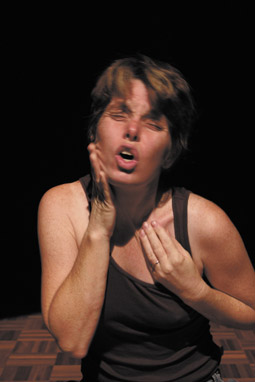
Vanessa Tomlinson, All Vinko: The Theatre of Music
photo Sharka Bossakova
Vanessa Tomlinson, All Vinko: The Theatre of Music
FOR AUSTRALIAN CONCERT GOERS VINKO GLOBOKAR (FRENCH-BORN SLOVENIAN, 1934) BELONGS TO A ‘LOST GENERATION’ OF EXPERIMENTAL COMPOSERS PRODUCING WORKS FOR THE CONCERT HALL FROM THE 1960S ONWARD. HIS WORK HAS HAD ALMOST NO EXPOSURE HERE OUTSIDE OF REFERENCES IN ACADEMIC TEXTS. CLOCKED OUT (INCLUDING VANESSA TOMLINSON WHO WORKED WITH GLOBOKAR IN VIENNA) GIVES US A CATCH-UP CONCERT DEVOTED TO FIVE OF GLOBOKAR’S WORKS, SPANNING 1969 TO 1997.
The concert starts with Discours VIII for wind quintet (1984), scales rising at different rates to create a complex overlay of notes that sync up every so often, turn into drones, then start rising again. The performers move about, leave one standing alone in the central spotlight, return, stand with their backs to the audience, exchange conversational snippets of sound and gesture. The sound is beautifully balanced. The effect of the movement is formal, measured, music as re-enacted dance.
Next is Corporel for Body Percussion (1985). Tomlinson sits alone on the stage, hands over her face, forcing sound out of her mouth and through her fingers. She rubs her face, taps her head, taps a clavicle, leans back and slaps her hands down on the floor. She moves her hands across her body from top to bottom, scratches her hair in a systematic exploration of the spatial geometry of the head. The effect is discomforting, as though Tomlinson is visiting an unfamiliar body and checking the surface for defects. The personal is suppressed, the performer reduced to a vehicle for the expression of rules and the ordering of symbols.
Kvadrat for four percussionists (1989) follows. The performers sit facing outwards on chairs arranged in a square. Each chair has its own set of commonplace objects nearby. Water drips from hands, paper gets scrunched and shaken, carrots clap together, ropes get whipped, feet move, micro gestures make no sound, and at a cue—maybe a music box or an alarm clock sounds—the performers change places. It’s like a party where everyone gets to adopt positions, say their piece, but never actually speak to each other—although there is a final all-in-together singing of the universal OM. There seems to be a claim for percussion as a way of finding the meaning of the world by sounding its objects, or perhaps the claim is that the sounding gesture magically brings meaning to the objects it strikes. Again there is the indication that the performance of music has some function over and above the making of sound.
Another solo piece for Tomlinson, Pensée ecartalée for percussion solo (1997). Voice sounds and the hum of whirlies, coughing, moving from one bit of equipment to another, getting annoyed and hitting things in frustration. Like early tape music, this work of Globokar’s is very serial, one sound after another, with little or no overlapping between. But the gaps between the sounds aren’t long enough for the sounds to become things-in-themselves, not short enough for them to gestalt together into a rhythmic progression. On the up-side it reminds me of John Cage’s Water Walk (http://blog.wfmu.org/freeform/2007/04/john_cage_on_a_.html). However, the humour and musicality of Cage’s performance is missing. Comes across as a bit aimless in the end. The composer again seems to be using the performer to enact a behavioural sequence rather than seeking to engage them with the possibilities of performance.
The final, and oldest, work—Discours II for trombone quintet (1969)—is the strongest. To begin, we watch the performers getting ready to begin—making sounds with the mutes, banging the trombone bell, shuffling about with the gear. This gradually works into lots of breathy sounds and the usual fabulous farty resonance of the trombone—Globokar has been a virtuoso trombonist and it shows in this piece. There’s humming, laughs and chuckles, lots of vocalisations made through the instrument to transform the voice and situate the performer within the sound making. A soloist plays on all the time and the others pop in and out trying to get some sort of conversation going. Sparse and silent becomes waiting and preparation. The performers begin to grumble, pick up their mutes and one by one walk off, leaving the last soloist gabbling away like a TV left on by mistake in another room.
Clocked Out, All Vinko: The Theatre of Music; Queensland Conservatorium of Music, April 4, http://www.clockedout.org
RealTime issue #85 June-July 2008 pg. 49
© Greg Hooper; for permission to reproduce apply to realtime@realtimearts.net
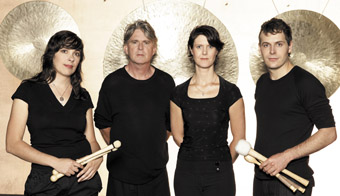
Synergy, Bree van Reyk, Michael Askill, Alison Pratt, Timothy Constable
IANNIS XENAKIS IS REPORTED TO HAVE SAID THAT “TO ESCAPE FROM THE TRIVIAL CYCLE OF RELATIONSHIPS IN MUSIC, THE MUSICIAN, THE ARTIST, MUST BE ABSOLUTELY INDEPENDENT, WHICH MEANS ABSOLUTELY ALONE.” ONE SENSE OF THIS WAS EVIDENT IN THE SHEER DRAMA OF TIMOTHY CONSTABLE’S PERFORMANCE OF THE COMPOSER’S PSAPPHA (1975), A SOLO WHICH, WHILE EXPRESSING NOTHING LITERAL, SUGGESTED MUCH.
CarriageWorks’ Bay 20 is a perfect venue for such percussive theatricality. It’s an acoustically and spatially ideal venue for contemporary instrumental music, offering clarity, limited reverberation and opportunities for maximum expressiveness, realised here in the clear geometry of instrument placement and Neil Simpson’s pools of limpid light and casting of giant performer shadows.
The first half of the concert comprised two mesmerising works by Steve Reich. Six Marimbas [1996] was given great aural depth of field by placing the marimbas in a wedge widening out to the audience in twos. The rear two appear to provide the underlying machinery for the work, while the forward four at different times drop in out of the soundscape, sometimes quietly as Reich’s phasing is magically realised, sometimes dramatically with a loud, precise bell-like entrance. Amazing sounds are generated as if the six marimbas are one instrument, their overtones suggestive first of a deep organ and later of distant carolling bells. Here is work that takes you up with its insistent, contagious complexity.
Drumming [1971] Part 1 for eight tuned bongos is, as Reich intended, never imitative of African music, although inspired by it. There are certainly moments that seem to incidentally evoke that sophisticated percussion tradition; built around a bell pattern, the phasing generating layers of merging sound, create a high collective shimmering rattling and, out of the blue, strange half melodies. Again the staging is potent: a line of bongos at right angle to the audience with three percussionists on each side, the whole in a narrow line of bright light in an othewise darkened space, heightening the sense of musical and physical concentration.
The second part of the concert featured three works from Xenakis: Psappha [1975] and Claviers (Keyboards) and Peaux (Skins), both from Pleiades (1978). After the determined pulsing of Reich, we enter a world of radical changes in tempi and mood, familar to us from romantic and especially modernist idioms, but with their own very special character in the works of Xenakis
In Psappha, Timothy Constable stands amidst his instruments: two large drums, one of them huge on his left, a glockenspiel centre, small metal or wood blocks to his right, and overhead a small set of chimes. With this musical machine Constable performs a wordless dramatic monologue replete with moments of reflection, of passion and suspended actions—hanging over the big drum before belting it mightily and swinging about to tap out its sharp opposite, or breaking into a supple glockenspiel melody, almost oriental in feel, quite counter to larger antagonisms. There’s a compulsiveness and violence about the recurrent strikings that some have suggested reflects the composers experiences of World War II where he fought with the Greek resistance. Psappha is nothing so literal but its existential drama is here amplified by Constable being aptly cast as two huge overlapping shadows on the stony CarriageWorks’ wall. The drama concludes without lingering, with the loud and lone ringing of the small chimes. An ambiguous ending.
If Psappha is drama, Claviers is dance. Conducted by Daryl Pratt it features three vibraphones and two marimbas combining to create a bell-like asynchrony against rippling marimbas, all the instruments high, liquid and sparkling, then dipping into a constantly repeated scaling up until reaching a plateaux again of bell resonances rich in harmonics. There’s a little vibe solo and a return to the collective scaling, all the peformers leaning deeply to their right and darting left in a cohesive dance. Theres a pause and then a fast bright, almost minimalist beat interpolated with gonging overtones leading to a final transcendent humming harmonic, all the players, finally still, holding sticks aloft. Magical.
For Peaux, six players and eight timpani, with smaller instruments tucked in between, are placed in a wide gentle arc and variously played with sticks, as well as hands and pedalling feet. There are moments of complexity and then sudden, propulsive unison riffs. A storm of pummelling is followed by a deep unanimous drum-rolling, broken from and then returned to until the whole is tapped down to silence. Again the work is wonderful to watch, with Constable and guest player Eugene Ughetti ‘dancing’ on the outer ends of the arc to the demands of the scoring. There’s a heightened sense of teamwork all round, the players keeping an eye on each other, signalling, conducting, dextrously moving as one.
This was an impressive concert in every respect, musically complex, dramatically powerful and spatially well conceived, the extended ensemble (guests Eugene Ughetti, Jeremy Barnett) playing with confidence and a sense of exhilaration. The new Synergy (Michael Askill, Timothy Constable, Bree van Reyk, Alison Pratt) looks set to enjoy a great future. Not least, this concert was for many a revelatory introduction to Xenakis as a composer for percussion.
There’ll me more about Synergy in a feature interview in RealTime 86. See also page 51 in this edition.
Synergy Percussion, Xenakis & Reich, CarriageWorks, April23-26.
RealTime issue #85 June-July 2008 pg. 48
© Keith Gallasch; for permission to reproduce apply to realtime@realtimearts.net
GROWING UP IN SYDNEY’S SOUTH WESTERN SUBURBS I FELT LIKE CONTEMPORARY CULTURE WAS SOMETHING THAT WAS HAPPENING ELSEWHERE: SOMETHING THAT I WOULD ONLY FIND IF I ESCAPED THE ENNUI OF FIBRO AND BRICK VENEER, HOTTED UP CARS AND UNWALKABLE DISTANCES, TO DWELL IN THE RUNDOWN FEDERATION CHIC, COFFEE SHOP INFESTED, WORLD-AT-YOUR FINGERTIPS INNERCITY. HOWEVER AS WE HAVE ALREADY SEEN IN THE PAGES OF REALTIME, SOUTH WEST AND WESTERN SYDNEY ARE CURRENTLY UNDERGOING A RENAISSANCE WHICH EXTENDS TO THE AREA OF NEW MUSIC.
Directed by Matthew Hindson, 2008 marked the second iteration of the Aurora festival (the inaugural event occurring in 2006), and this year it benefited greatly from a new critical mass of arts venues in the West with programs presented at the Campbelltown and Blacktown Arts Centres, Joan Sutherland Performing Arts Centre (Penrith), Parramatta Riverside and the Parramatta campus of the University of Western Sydney. However the Aurora festival is significant not only because of its geographical placement but also due to its endeavour to present new music by living composers, with a healthy number of those being Australian.
Crash, Bang, Swoon
Crash, Bang Swoon by Bernadette Balkus (piano) and Claire Edwardes (percussion) featured the works of six composers, two of whom were so alive as to be present, offering introductions to their pieces. The concert commenced vibrantly with Alex Pozniak’s The Tower of Erosion. Inspired by a rocky cliff face on Sydney’s northern beaches, the piece comprises ‘cells’ of music that build up and disintegrate. The interplay of piano and percussion is fluid, with parallel rhythms breaking up into sharp jazzy syncopations; cymbals and snare rising and crashing like waves, working against the structure, literally and metaphorically. Pozniak spoke of drawing inspiration from noise artists such as Japan’s Merzbow and this contemporary influence came across in his attention to texture, making the work evocative without becoming illustrative.
New Zealand composer John Psathas’ Fragment (2001) is indeed that: short, delicate and sweet. Adapted from a piano duet the piece begins with gentle chords as the vibraphone carries the melodic line, and then the roles are swapped. When asked about the unusual coupling of piano and percussion in one of the made-for-radio introductions (several Aurora concerts were broadcast on ABC Classic FM), Claire Edwardes said that she was particularly attracted to the configuration as it allowed the musicians to be equal partners. Fragment certainly illustrated the lyrical possibilities of this coupling.
Edwardes presented solo pieces for marimba by Japanese composer Keiko Abe. Memories from the Seashore (1986) capitalised on the woody qualities of the instrument—the hollow clatter and deep warm undertones—playing a sweet, almost sentimental motif of rising and falling phrases. The second piece, Vase (1986), was sharper, more intellect than emotion, using harder mallets in an ambivalent ode to a Japanese urn.
US composer Kevin Puts’ Alternating Current (1997) was Balkus’ choice for a solo. Instead of fighting against the weight of the classical piano repertoire, Puts works within the style of three greats—Bach, Beethoven and Prokofiev—but introduces the element of alternating meters and modes. The work is almost pastiche, yet offers far more intrigue—what we think we know and understand is permeated by strange pulses and contemporary melodic phrases that slip around in the work, insistent but hard to catch. It’s also a piece requiring virtuosic skill which Balkus did not fail to deliver.
Cyrus Meurant was also present (along with Pozniak) to introduce the world premier of his piece Ritournelle (2008), interrogating the various musical meanings of that term from a refrain, a song, to an instrumental repeat. The piece played with roles of leading and accompaniment between piano and tuned percussion, with surprising shifts, and dynamic changes from wistful to rousingly robust.
The consummate skills of Edwardes and Balkus were confirmed by the final work, Harrison Birtwistle’s The Axe Manual (2000). This is a difficult to play, some would say difficult to listen to work, spiky and agitated with the percussion and piano joining together through pulses. Edwardes works her way systematically around the range of her instruments from the driving woodblock section to the strident drums, and everything in between, supported and provoked by Balkus’ piano. It was an appropriate conclusion to a smartly curated concert of challenging and beguiling works from two inspiring performers.
Car Orchestra
A truly accessible event in Aurora was the outdoor spectacle of the Car Orchestra, presenting Michael Atherton’s Utility HoRn GrOoVe, a piece for funk band, rap MC’s, a mag wheel gamelan and five fetishised Ford Utilities. Bringing together a range of participants from UWS Macarthur Drum Academy, the Fisher’s Ghost Youth Orchestra and the NSW Ute Club, the event enthusiastically explored the integration of car horns and indeed car ballet into a kind of funky, hip hop, musical melange held together by Atherton as the dancing conductor. A family oriented event, the Car Orchestra certainly broadened the audience demographic for this new music festival.
I couldn’t stay for more of Aurora at Campbelltown Art Centre as I had to hit the highway and flee back into the innercity to catch What is Music? This has been a big month for festivals. Perhaps by the next Aurora, the innercity monopoly on the cultural pulse of the new music and sound art will be well and truly broken. Already in 2008 the NOW now festival relocated itself to Wentworth Falls—maybe the cultural map, (along with many of our assumptions) is finally set to be redrawn.
Aurora, Crash Bang Swoon, Bernadette Balkus, Claire Edwares; Car Orchestra, Utility HoRn GrOoVe, musical director Michael Atherton; Campbelltown Arts Centre, April 12
RealTime issue #85 June-July 2008 pg. 47
© Gail Priest; for permission to reproduce apply to realtime@realtimearts.net
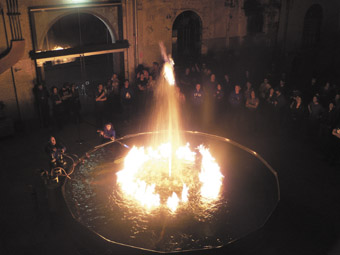
Miles and Zai van Dorssen’s Feuerwasser, What is Music?
photo Harry van Dorssen
Miles and Zai van Dorssen’s Feuerwasser, What is Music?
AFTER THE METAL INFLECTED DRONEFEST OF 2005 WE HAVEN’T HEARD MUCH FROM WHAT IS MUSIC? PRESENTING A FESTIVAL ALMOST EVERY YEAR SINCE 1994, PERHAPS IT WAS TIME FOR THE DIRECTORS ROBBIE AVENAIM AND OREN AMBARCHI TO TAKE A BREAK AND LET THE TINNITUS SUBSIDE. IN 2008, UNDER THE LEADERSHIP OF AVENAIM ALONE, THE FESTIVAL HAS COME BACK AT A STRATEGICALLY SMALLER SCALE YET STILL MAINTAINING A PRESENCE IN MELBOURNE, BRISBANE AND SYDNEY.
I didn’t catch the onslaught of Maxximal Patterorist (Anthony Pateras and Max Kohane), who opened the nine-acts-on-one-night extravaganza at CarriageWorks, as I was tooling down the highway from the funky Ford Utilities (see Aurora review). However I asked one of my esteemed colleagues what it was like and he responded, “scrabbling avant piano hammering welded to grind-core percussion, peppered with quieter, but no less intense, passages of textural exploration.” Sorry I missed it.
I entered the packed venue to see Dale Gorfinkel pottering around like Dr Dean from the Curiosity Show, with a small child on stage holding a tennis ball container over a vibrating contraption that amplified the nasal drone. Gorfinkel’s hacked vibraphone was besieged by plastic cups holding spasm-ing ping pong balls and other clattering bits and pieces. He quietly walked the space, making adjustments, switching elements on and off to create intriguing layers of textural drone. Both Gorfinkel and Avenaim have been seriously exploring this machinic approach to sound-making (in the tradition of Ernie Althoff), and it is engaging both sonically and in its unpretentious task-based performativity. Avenaim’s set up involves an augmented drumkit, from which machinic vibration and microphone feedback elicit deep rich tones. A large part of his piece involved trying to get a recalcitrant motorised drum stick to behave, illustrating the multiple possibilities of chance rhythms and textures. There is something very appealing in the honesty and vulnerability of Avenaim and Gorfinkel’s processes: we see the elements, we see how they come alive, how they come together, and then how they fall apart again.
It was particularly pleasing to hear Marco Fusinato play as prior to this I had only known of his series of ‘blank’ vinyl LPs on which he scratches and carves creating visual artworks. When played these objects make a music of surface noise, clicks, jumps and skips (0_synaesthesia edition, syn 013-16). For this set Fusinato produced bursts of harsh guitar and effects-generated static in which manipulation of volume and timing were paramount. A loud burst—just long enough so that you begin to block your ears—then it stops…followed by a quieter burst, which somehow makes you feel the loss…interspersed with definitive silences. It was a deeply satisfying work showing a compositionally controlled and structured approach to noise.
No event seems complete these days without the laserlight show of Robin Fox, and although I’ve seen and heard it several times, it just keeps getting better. In this version he uses two lasers pointed at the audience, the raked seating enhancing the three-dimensionality as the lasers catch the smoke, carving up the space into shifting sheets and sheering planes. Sonically the work is also getting more intricate, with cross rhythms emanating from the brutal tones that slip in and out of overexcited arrhythmia and pumping beat.
Fox’s spectacle was a hard act to follow for the contemplative piano duo of Cor Fuhler and Chris Abrahams. Fuhler concentrated on piano preparations and ‘electronifications’ while Abrahams worked with the ‘raw’ sound of the grand piano. Initially I felt that I didn’t have the ears left for this piece and the amplification of Abrahams’ piano seemed distancing and unnecessary. However as the work progressed, the sounds of both players mingling in the same mediated space became increasingly rich. The duo’s intense summoning of just the right sonic event and gesture out of the aether, and their tangible sense of playing ‘together’ created a sustained, meditative experience that rewarded the patience it demanded.
Former What is Music? director Oren Ambarchi was the seventh act. His set of luscious, loud, occasionally harsh drones produced by four guitars building into a painfully beautiful squall seemed, by this stage, overly long, though nonetheless momentous. Unfortunately it called upon whatever concentration many of us had left and visiting Italian artist Valerio Tricoli had a challenge to keep the crowd focused. Calling for night (lights out), his set occurred in the glow of a television screen that was tapping into his audio feed. Tricoli has a dark, ambient, almost gothic flavour in his work, with cavernous echoes and shifting vocal fragments. I wish I could say more… but as the programming proves, more is not always the best approach.
The final event sent us out to the vast foyer of CarriageWorks where Miles and Zai van Dorssen had constructed Feuerwasser, consisting of a large swimming pool full of water which, with the encouragement of a blowtorch begins to sport a ring of flames—a fire fountain. By altering the amount of gas and water pressure the artists ‘play’ their construction, making the jets of water and flame rise ever higher into the air. Incorporating the sound of hissing and sharp, cracking explosions as vital molecules within fire and water clash, the piece is awesome, defying our understanding of the elements as a flame dances on top of a ten metre high jet of water.
What is Music? 2008 was a mature and serious beast. (An additional Sydney performance at another venue presented some of the terror rock elements for which the festival is also renowned). Although the event may have sustained attention better with fewer acts, the choice of who to lose from the impressive line-up would have been a hard call. It will be interesting to see whether What is Music? continues to grow old gracefully.
What is Music?, CarriageWorks, Sydney, April 12.
RealTime issue #85 June-July 2008 pg. 46
© Gail Priest; for permission to reproduce apply to realtime@realtimearts.net
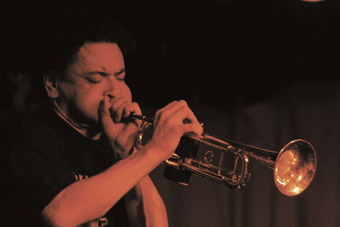
Christian Pruvost, MIBEM
photo Andrew McDougall
Christian Pruvost, MIBEM
THE MELBOURNE INTERNATIONAL BIENNALE OF EXPLORATORY MUSIC IS A SIGNIFICANT ACHIEVEMENT IN CONTEMPORARY MUSIC PROGRAMMING, BRINGING TOGETHER AN EXTENSIVE RANGE OF COMPOSERS AND PERFORMERS WITHIN THE OVERALL REQUIREMENT THAT THE MUSIC SHOULD BE EXPLORATORY. COMPRISING 35 PERFORMANCES IN SEVEN CONCERTS OVER FIVE DAYS, AND INCLUDING PERFORMERS FROM ALL OVER AUSTRALIA, EUROPE, THE US AND NEW ZEALAND, MIBEM IS ABOUT A PARTICULAR ATTITUDE TO MUSIC, ABOUT PUSHING BOUNDARIES.
Co-artistic directors Robin Fox and Anthony Pateras invited participation from musicians and composers they had seen or with whom they had worked, particularly in Europe. Fox stated that MIBEM is not intended to be specific to any genre, and the program was almost encyclopaedically diverse, a collection of samples from each composer/ performer’s oeuvre.
I attended two concerts. Saturday evening commenced with Brisbane’s Clocked Out Duo: Vanessa Tomlinson, percussion, and Erik Griswold, prepared piano. Their performance used a variant of a technique seen in their earlier compositions, where drumsticks are attached to long ropes fastened at the other end to a fixed object. As Tomlinson performs, the movement of the ropes simulates the movement of a sine wave and, in this work, the moving ropes strike an array of plates, bowls and other objects on the floor, creating tapping and ringing sounds. Accompanied by Griswold’s piano, the result is an absorbing and satisfying composition—a detailed orchestration of percussive and resonant sounds, using musical and non-musical objects, within an overall musical structure, but which has aleatoric and improvisatory aspects as well as a visual quality.
The second work, by a trumpet quartet of Peter Knight, Tristram Williams, Scott Tinkler, all from Melbourne, and renowned Lille-based trumpeter Christian Pruvost, was all the more evocative for being performed in an eerie darkness—in acknowledgement of Earth Hour, the auditorium was illuminated only by the Exit lights. One trumpet was miked and prepared, looking as though a rubber tube was attached to the mouthpiece, which the performer would bend and pluck and blow through, creating some extraordinary sounds. This group improvisation emphasised technique and, as the performers moved about the space, their breathy sounds coalesced into a strikingly intense and unpredictable whole. Chris Abrahams’ enchanting solo piano performance followed, a work that explored dynamics, tonality/chromaticism and sonority, and was perhaps more cerebral and introspective in flavour than is typical of his ensemble, the Necks.
Berlin sound artist Kirsten Reese’s contribution was a short piece in which she sat at a table gently touching a variety of very closely miked glasses, bowls and other everyday objects. These sounds were processed via a laptop using morphing and delay to layer the sound. The work makes the most of a brilliant PA that can convey every nuance of even the lightest fingering of an object, creating a haunting intimacy that negates the physical distance between listener and performer and makes music out of the ordinary. The final work for the evening was a performance by Amsterdam-based composer Cor Fuhler, who has pushed the prepared piano to new levels, using electro-mechanical devices that sit on the piano strings and create endlessly sustainable resonances and harmonics. Both pianist and mixer, Fuhler stands at the piano, sometimes playing the keys, sometimes touching the strings directly and simultaneously manipulating the devices inside it. The result is a unique sonic language that Fuhler arranges into a delightfully melismatic composition.
Sunday afternoon saw three highly contrasting performances—the Reindeer and Parchment ensemble’s theatre, Jim Denley’s heavily mediated saxophone and an entrancing rendition of Morton Feldman’s Triadic Memories by Adelaide pianist Stephen Whittington. Reindeer and Parchment’s stunning work was a short play in which the main protagonist appears to be ill and is to go to hospital. Her inner agony and her conflict with her partner are portrayed using pre-recorded sound and an array of typical sound-art devices: objects with contact mikes are rattled and scraped and the resulting sounds are processed—by a performer dressed as a surgeon, at a laptop—establishing a series of wry metaphors for the human condition. In parts, sound substitutes for dialogue and the work is a fascinating exploration of how sound art and theatre can be melded to produce a unique synthesis with great potential for further development.
Denley’s solo sax & laptop improvisation conveyed a feeling of deep introspection, as if he was ruminating over the idea of sound as breath, inhalation and exhalation. Moments of sound would emerge and then be abruptly cut off, like confused thoughts trying to emerge into conscious awareness. But as the soliloquy progressed, the sounds developed into more extended musical figures, finding voice, power and release.
But the focal point of MIBEM was Morton Feldman’s epic solo piano work Triadic Memories. Now 27 years old, the work is hardly new, and lacks the technological innovations of much of the MIBEM program. But it places immense demands on the performer, who must use a very different playing technique to realise the minutely detailed score. As a mature work of Feldman’s, it represents the culmination of his own compositional exploration, and is so highly resolved and so musical that technical considerations are subsumed. In just these two concerts, we saw many approaches to the piano and to piano writing: Abrahams’ studied improvisation, Feldman’s extraordinarily refined and subtle composition, and Fuhler’s and Clocked Out’s approaches to preparation, testing the limits of the instrument. As Whittington commented privately, there are many ways to play a piano.
The printed program rarely cited the titles of works performed and, apart from Whittington’s excellent essay on Feldman, lacked contextualising literature, so that MIBEM sometimes had the feel of a workshop. But this biennale is a significant and very welcome achievement. The event wonderfully showcased the possibilities of experimental music and sound art, revealing multiple trajectories and new aesthetics and poetics, encouraging artistic innovation and development and energising audiences. While some musical directions are well established, others are at a developmental stage. But the variety of approaches and often the quality of the works and the performances were breathtaking, variously addressing instrumentation and musical form, modern and postmodern musical traditions, the boundary between sound and music, the nature of performance, the idea of improvisation, the types and uses of notation, the use of recording and synthesising, and the potential of the ubiquitous laptop.
Melbourne International Biennale of Exploratory Music, performers Cor Fuhler, Kirsten Reese, Chris Abrahams, Christian Pruvost/Peter Knight/Tristram Williams/Scott Tinkler, Clocked Out Duo, March 29; Reindeer & Parchment, Stephen Whittington, Jim Denley, March 30; ABC Iwaki Auditorium; MIBEM, various venues March 28 – 2 April 2; www.mibem.net
RealTime issue #85 June-July 2008 pg. 45
© Chris Reid; for permission to reproduce apply to realtime@realtimearts.net
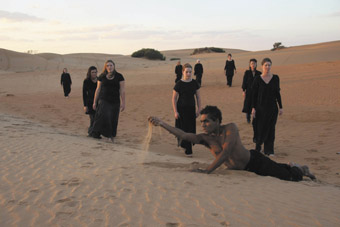
The Seal Wife
photo Joe Pasquale
The Seal Wife
IN MY UTOPIA FOR SENSITIVE SOULS, FIONA BLAIR WOULD BE RECEIVING MULTIPLE AWARDS FOR HER VISION, HER COURAGE AND HER BRAVERY FOR DARING TO SHOW US A NEW WAY OF SEEING. THE THEATRE COMPANY, THE OLD VAN, WHICH WAS FOUNDED IN 1998 AND FOR WHICH BLAIR IS ARTISTIC DIRECTOR, IS AN INDEPENDENT, PROFESSIONAL GROUP BASED IN RURAL VICTORIA WHICH AIMS TO CREATE WORK THAT IS CLOSELY RELATED TO THE ENVIRONMENT IN WHICH IT IS PERFORMED AND NOTABLE FOR INVOLVING LOCAL CHILDREN AND ADULTS IN ITS PRODUCTIONS.
Mildura has already been host to some magical moments created by the Old Van. In 2003 we witnessed A Midsummer Night’s Dreaming, Mildura 1956, performed at the Riverside Golf Club. The following year it was The Life and Deaths of Don Koyote, Man of the Mallee at the Botanical Gardens and in 2005 Romeo and Juliet was performed in a large dusty packing shed in Merbein.
“Performing acts of cultural appropriation” is something to be proud of here. Blair manages to bring an immediacy and appropriateness to the work she chooses. She genuinely connects to the community and the location she selects (or which selects her: Blair’s attraction to Mildura may have something to do with her early childhood in Robinvale), always respectful of the Indigenous past and inspired by the great Western canon.
The Old Van’s most recent production was The Seal Wife: A Ceremony of Ghosts, performed at the Perry Sandhills (six kilometres out of Wentworth) for two nights in early May. It is based on the legend of the selkie, and under Blair’s direction, we learn of this story in the opening sequences from a narrator sitting with children of the area around a campfire. Audience members encircle the ‘stage’ which is a gentle valley of sand extending into the dune area. Huddled there in the dropping temperature of the desert we feel transported to an imaginary township, surrounded by what was once an inland sea. An eerie atmosphere is created by the blue-grey smoke of the fire rising into the starlit black sky.
In Scottish folklore the selkie transforms into a human after shedding its skin. If the skin is stolen or disappears the creature can never return to its original form. It can live in the human world, marry and have children, but it will always yearn for the sea.
Leroy Parsons, assistant director and Indigenous media officer with the company, plays the role of the selkie. He first appears on the ridge of a distant, illuminated sand-dune, seemingly limbless and with convincing sea-animal movements.
After his transformation into human form the audience is distracted by a distant moaning and the slow, rhythmic apparition of the ghost women of the town, all clad in black, making their way towards the central scene. It’s mesmerising and beautiful on many levels. The guttural sounds of unresolved grief are enough to make us pensive and absorbed.
We witness and understand that the women steal the skin in order to do a trade with the selkie, requesting a night with the drowned seamen of the town. He agrees, on the condition that he gets the skin back and a bride in return.
Soon the traditionally dressed bride and groom are before us. A surreal scene follows where the town’s women ritualistically adorn the bride with a waist piece that unfolds into vasts lengths of white tulle and fabric. This gently choreographed sequence, performed with care and attention, is enigmatic yet powerful in conjuring up ideas of pirate ships, sails, fish nets, harbour posts, storms and waves. We are reminded yet again of the dangers of the beguiling sea and its dreadful ability to steal away loved ones.
Sad thoughts are diminished in a moment with the arrival of the men, resurrected and reunited with the women for a night of joyous singing, dancing and love-making. But before we are really aware of it, the mood has shifted again and we are in the midst of heartbreaking separation, the splitting of lives and people into their singular ghostly worlds. Female voices eulogise their dead husbands. A male voice quotes TS Eliot, characterising the sea: “It tosses up your losses, the torn seine,/ the shattered lobsterpot, the broken oar/ And the gear of foreign dead men” (from Four Quartets, The Dry Salvages).
The Seal Wife was a moving, meditative theatre experience enhanced by its attention to music, lighting and text. The Old Van does well to continue its commitment to brave theatrical works in regional communities, refreshing stories from our Western cultural tradition while paying homage to our Indigenous past. The work is not ‘polished’, and the better for it, as its rawness delivers soul that’s sometimes hard to find in the plethora of cultural options available to us.
Old Van Theatre Company, The Seal Wife, A Ceremony of Ghosts, director, writer Fiona Blair, performers Lou Bennett, LeRoy Parsons, Joyce Greed, Chloe Mackie and community members, lighting designer Rob Irwin, music directors Tracy Bourne, Bagryana Popov, fire sculpture Darryl Cordell, Perry Sandhills, May 1-3
RealTime issue #85 June-July 2008 pg. 44
© Donata Carrazza; for permission to reproduce apply to realtime@realtimearts.net
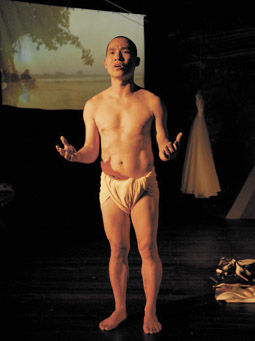
Binh Duy Ta ,Yellow is not yellow
photo Heidrun Löhr
Binh Duy Ta ,Yellow is not yellow
IN DECEMBER 2007, PERFORMER AND DIRECTOR BINH DUY TA AND VIDEO ARTIST PETER OLDHAM TRAVELLED TO VIETNAM TO UNDERTAKE RESEARCH AND DEVELOPMENT FOR CITYMOON’S LATEST WORK, YELLOW IS NOT YELLOW, A WORK-IN-PROGRESS SHOWING OF WHICH WAS PRESENTED AT THE COMPANY’S BANKSTOWN HOME IN LATE MARCH. TA DESCRIBES THE EARLY DAYS OF THE TRIP, DRIVING THROUGH THE STREETS OF HANOI, WITH OLDHAM FILMING AND HANGING ON FOR DEAR LIFE: “HE WAS VERY BRAVE. BEFORE WE LEFT, I TOLD HIM THAT WE WOULD FILM AROUND THE CITY ON A MOTORBIKE, AND HE DIDN’T BELIEVE ME. BUT HE COPED WITH THAT VERY WELL.”
The title Yellow is not yellow is drawn from Ta’s investigations of Buddhist philosophy, in particular the notion that something might not be what it appears or claims to be. For Ta, this evokes the migrant experience, slipping constantly between identities and languages. With this linguistic and embodied state of shifting, one loses that which one was, without ever becoming that which one wished to become. This is a deeply personal theme for Ta. Despite having lived in Australia since 1991, he feels that he has never quite become ‘Australian’, but is not exactly ‘Vietnamese’ anymore either. One of the aims of the Hanoi visit was to stage an encounter with states of not-here and not-there and this proved to be a rich thread informing the work’s development.
Questions of identity and culture have been very much at the heart of Citymoon’s practice over the last decade. The company began in 1995 as a collaboration between Binh Duy Ta and the late director and performer Bruce Keller. The two had previously worked together on Jigsaw Theatre Company’s Treehouse (1991) in Canberra, a work that later toured throughout East Java. “You have to go to Sydney”, Keller told Ta when they completed the project. Ta took this advice, and work with renowned performance group Entr’acte Theatre followed.
On tour with Entr’acte through Indonesia, Ta encountered the work of the poet, director and writer WS Rendra and his Bengkel Theater, and was struck by their powerful integration of martial arts and performance: “My training background was as a pantomime artist, a classical mime. Entr’acte is not classical mime, but modern or corporeal mime. At the same time, I trained in martial arts. I trained as my own interest, rather than thinking that one day I can apply this to performance. Since [seeing Bengkel Theater] I thought maybe I’ve got something that I can develop, and combine the mime to the movement to the kung fu into something that could be my own style.”
This stylistic fusion was clearly of interest to Keller as well and the pair founded Citymoon. Each saw the potential to develop a distinctive hybrid movement vocabulary, a physical performance practice that might be able to build a cultural bridge between embodied Vietnamese and Australian identities. With an intercultural agenda that was both personal and aesthetic, Citymoon took as its mission to make performance from “contemporary themes with a Vietnamese sensibility.” Their first work, Conversations with Charlie, premiered at Belvoir Street Theatre’s now defunct Asian Theatre Festival in 1996, and subsequent works included The Three-Cornered Room (1999), Hip Hop Horse (2000), The Monkey Mother (2000), and Soft Silk, Rough Linen (2001).
Keller and Ta’s work with Citymoon has had the recurrent theme of identities in states of flux and transformation, encountering, embracing and usually overcoming cultural difference. Alongside their work with professional artists, Citymoon also began to develop a range of projects involving young people. The youth aspect to the company was not originally part of the plan but made increasing sense as Citymoon’s practice developed. Ta remembers an interview with the youth arts magazine Lowdown in the early years of the company, which, upon publication, left the strong impression that Citymoon intended to have a focus on developing performance with young people. Upon reflection, he and Keller decided that this sounded like a very good idea.
Personal contacts with Bankstown Youth Theatre and the presence of large numbers of young Vietnamese people in the area saw the company relocate to Bankstown and, over the next few years, Citymoon created Dat Nuoc: Earth/Water (1999), Beat Box Vox Pop (2001), Eleven Parts of Feeling (2004) and three co-productions with Powerhouse Youth Theatre, Journeys West (1999), Finding the Buffalo (2001) and Heartland (2002). While each of these projects had a strong core group of young Vietnamese-Australian artists, true to the company’s vision of performance as a place of cultural exchange and transformation, later projects included increasing numbers of non-Vietnamese young artists. For Ta, this move made the work “more reflective of the society we live in now, rather than just Vietnamese.”
The strength of Citymoon’s performance practice was the strong cross-cultural collaboration between Keller and Ta, representatives of two cultures. For Ta, this aspect of Citymoon’s work has continued despite Keller’s death in 2003: “The ideas and philosophy are still there. I know that this sounds clichéd, but the work of Citymoon is the bridge between Vietnamese culture and Australian culture and artists.”
Yellow is not yellow continues this process of performative bridge-building. Citymoon’s first performance work in three years, Yellow… explores strangeness, loss and dislocation through a unique blend of music, physical performance, video and poetic text, and features a strong line-up of collaborators: Peter Oldham’s video work, musical compositions by Sawung Jabo, Ngoc-Tuan Hoang and Sarah de Jong, design by Pierre Thibaudeau, and lighting by Neil Simpson. Slipping in and out of languages, identities and cultures, getting carried away by strangely beautiful intercultural harmonies, Ta and his collaborators have created a vibrant new work for Citymoon.
Citymoon Theatre, Yellow is not yellow, work-in-progress, Hackett House, Bankstown, March 29
RealTime issue #85 June-July 2008 pg. 43
© David Williams; for permission to reproduce apply to realtime@realtimearts.net
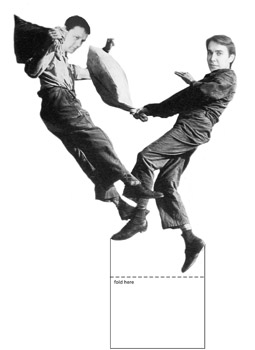
Jeff Wall and Jeff Koons, Paper Theatre Puppet, Andreas Kahre, The Linear Animal
WHAT DOES IT MEAN THAT THE CENTRE OF THE LINEAR ANIMAL IS AN EMPTY AND SILENT CIRCLE? THE UNLIT SHAPE, ABOUT EIGHT FEET ACROSS, IS CREATED BY A RING OF CLASSIC BLACK MUSIC STANDS WHOSE PLATFORMS OVERLAP. THE STANDS SUPPORT A TRACK FOR A TOY TRAIN. THE TRAIN CARS IN TURN HOLD BLACK AND WHITE PAPER CUT-OUTS OF A HANDFUL OF CHARACTERS DRAWN IN 19TH CENTURY PAPER THEATRE STYLE.
Silence and emptiness are most noticeable when surrounded by their opposites. The stage at the Western Front is not large. The Linear Animal matches that intimacy and the set is simple at the centre, full at the edges. The playing area is bordered with clusters of instruments—a viola, an aquaphone, small bells, two laptops that burble with dozens of sound files and microphones. Noise is a frequent visitor, but is never distorted or too loud.
Visually, the blank centre is cocooned by bodies and by live video animation. The four adults who use the instruments and the two teenaged “train wranglers” are dressed casually. The train needs their regular attention: the cutouts tilt under the weight of the tiny spotlights clipped to them and the cars catch on track edges. The performers move around or sit as needed and chat between scenes. The house lights are only partly dimmed because there are several points where audience members have to read aloud, or else the script discontinues itself.
The script is visible and the performers read, play music and live-process video—there is no acting. The mood is thoughtful, nostalgic, a little detached. Detachment comes through the narrator, who exists only acoustically, a digital voice with all elisions squared off. The voice lists unusual inside spaces like “the space inside appliances…the space inside vegetables.” This is all leading to talk about what happens to memory as it meanders inside human interiors. Or inside a space circumscribed by a toy train that can move only along one line.
Analytical and genderless, the narrator recounts disjointed memories of early years in Bavaria, attempting to restructure childhood and a lost but still brilliantly sunny love. Love here is between a male and female, but is also love of home—if home is something more than a condition of location or nationalism, the other identities the narrative voice dissects.
Stage left, Andreas Kahre, the (Bavarian born) writer and one of two main readers, regularly interrupts the digital narrator and reads the story of the two lovers himself. As he describes Amilie and Bodo dancing and drinking, experimental animator Aleksandra Dulic creates a live-processed video show stage right with paper cut-outs identical to those travelling helplessly, and endlessly, on the toy train.
Kenneth Newby (composer and software guru) kicks in some live-processed sound, the train’s clicking recognizable. Stefan Smulovitz (known for his live film scores) moans the bow across his viola. The narrator argues with itself about what renowned Vancouver photographer Jeff Wall might think about home.
David Garfinkle, the second reader, looks up. Here’s one of several moments we were warned about: he needs one male and one female to read, “or we just can’t go on.” After a brief pause, the beautiful couple in the front row disentangle themselves from the metal legs of the chairs and they read. Carefully. Thoughtfully. A present-tense conversation between two live bodies we can see for ourselves, rather than word-conjured images; yet two bodies who were not in Bavaria decades ago.
So is Linear Animal a high tech puppet show? Is it an experiment to contrast embodied, present time against a technologically recalled past? Even when Kahre appears to improvise several times about the blend between his Bavarian childhood and this one, the tale is salted with present tense comments. The audience experiences an embellished “now” more energetically than a perforated past.
Andreas Kahre, an interdisciplinary artist, has been exploring 19th century paper cut-out theatre for several years and has been involved with the creation of more than a hundred projects with theatre, dance and music ensembles across Canada. His adept playfulness lets the story ride in emotionally linked circles even as it is being told in fragments. The story is beautiful, sad and unconcluded. Events from the past are talked around and travelled around.
But that unlit centre-stage oval remains. It may be an open channel to allow an open flow of thoughts and identities. Or it may be a closed one, the way the past is always ultimately closed off, even when we’re retelling our own stories to ourselves.
The Linear Animal, Digital Paper Theatre, writer, performer Andreas Kahre, music & live sound processing Kenneth Newby, live video processing Aleksandra Dulic, reader David Garfinkle, puppeteer, train wrangler Ashlan Phoenix Gray, viola etc Stefan Smulovitz, presented by Western Front New Music, The Western Front, Vancouver, March 15, www.front.bc.ca, www.luluperformingarts.ca
RealTime issue #85 June-July 2008 pg. 42
© Meg Walker; for permission to reproduce apply to realtime@realtimearts.net
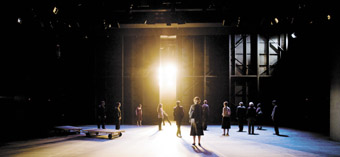
The Serpent’s Teeth
photo Brett Boardman
The Serpent’s Teeth
THERE ARE THOSE MOMENTS IN THE THEATRE WHEN YOU FIND YOURSELF SUDDENLY DISTANCED FROM THE PLAYING, SENSING SOMETHING WRONG, YOUR OWN LACK OF ATTENTIVENESS PERHAPS, A SUDDEN DISTRACTION (AN INCREASINGLY COMMON MOBILE PHONE GLOW A FEW ROWS AWAY)…BUT IT’S NONE OF THESE. THE DISCONNECT FOR ME WHILE WATCHING SEVERAL PRODUCTIONS IN SYDNEY RECENTLY WAS A MATTER OF SPACE, SPECIFICALLY WHAT KIND OF WORLD THE DIRECTOR AND DESIGNER (SET, COSTUME, LIGHT, SOUND) HAD BUILT FOR PERFORMERS AND AUDIENCE TO INHABIT.
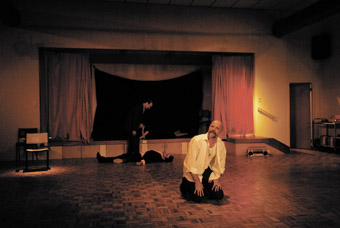
Antigone
photo Heidrun Löhr
Antigone
antigone
Chris Kohn’s Antigone for Company B at Belvoir Street Theatre attracted some reviewer ire for its contemporary community hall setting for a Greek classic. The complaint wasn’t quite the usual one that the director had willy-nilly displaced the play from its original period to some inappropriate other (all those Shakespeares in tightless, ruffless gangsterland, fascist states and corporate sectors) but rather that having so meticulously established a humble community hall with designer Dale Ferguson he did little with it. Kohn writes in his program notes:
…I settled on the idea of a civic centre, a liminal space, home to no individual but which provides a temporary home for the thoughts, energies and interactions of a diverse range of people…I was interested in placing Antigone in this frame, as it is a drama in which private feelings are played out in a public arena, with very public consequences. The community centre offered the possibility of existing ‘doubly’—as a room inhabited by a lonely troubled person in contemporary Australia, and as a refuge for modern Thebans, displaced by war and violence. The introduction of such a conceit has doubled the demands on the cast and creative team…
Liminal spaces, like the brilliant creations of Anna Viebrock for Christoph Marthaler, are increasingly de rigeur, as noted in these pages in recent issues. But as with any set design liminal spaces are only effective when they move beyond conceit to metaphor to active embodiment. Certainly there was a strong sense in Kohn’s Antigone of “private feelings…played out in a public arena”, not least because of Seamus Heaney’s version of the play, a sublime, conversational melding of ordinary idioms and striking images, and because of the ease with which most of the cast dealt with the writing. That’s where this ancient world felt most modern with Heaney playing up King Creon’s anti-terror program (“everyone is an agent of the law”, he tells his people), including his deployment of “anti-Theban” (grimly recalling “un-Australian”). It works too in Creon’s son Haemon’s scathing analysis of his father’s rationalism that puts the law above justice, compassion and ritual observance (Antigone is to die for burying her brother, a traitor to Thebes in the war that Creon has just won).
But for a director who worked design so adroitly in The Black Swan of Trespass and Eisteddfod for his own company, Stuck Pigs Squealing, the everydayness of the setting for Antigone is not exploited. There is no sense of this hall being lived in, unlike, say Viebrock’s design for Seemanslieder, other than citizens crawling like refugees with blankets out of cupboards below the stage in the play’s opening moments. Likewise, the choreographing of movement is largely formal, carefully shaped in circles and straight lines as if transposed from ancient ceremonial theatre. While this might have made up for the considerable difficulty of evoking the power of the state in a community hall, it did nothing to render the design conceit meaningful. The formal and the informal simply didn’t meet. That doesn’t mean the conceit is without potential—it’s not hard to imagine a more dangerous version of this Antigone, one in which the community hall is a living organism, with its own power plays and props, not simply a refuge or as it often appears, too temporary a space for all its palpable detailing. This is not a space that determines or resonates with action.
All of that said, I was engaged by much of this production, not least because of Heaney’s text, Deborah Mailman’s tragically obdurate Antigone, Hazem Shammas’ Haemon (he best provokes Boris’ Radmilovich’s otherwise restrained Creon into naked anger) and Paul Blackwell’s earnest and often rightly confused everyman Chorus. Gillian Jones as the blind seer Tiresias is a powerful presence, her terse staccato delivery has a curiously eerie touch of Aboriginal elder. Lighting designer Luiz Pampohla makes the most of limited opportunities, not least with a storm of flickering fluoros. Composer Jethro Woodward’s score has a melancholy cool jazz feel, and turns tense and aptly martial. Even the calculated banality of Ferguson’s design almost pays off because the issues writ so large—justice, faith, tradition, respect—are subjugated to the banality of political power that can only deal in absolutes.
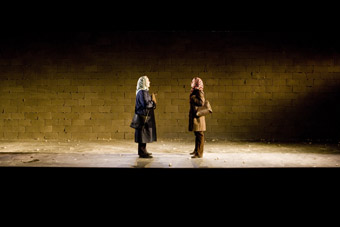
The Serpent’s Teeth
photo Brett Boardman
The Serpent’s Teeth
the serpent’s teeth
In The Serpent’s Teeth, the STC Actors Company performs a complementary pair of Daniel Keene plays, War and Soldiers, using highly contrasting spaces. In Citizens, a Besser brick wall (a palpable but not literal evocation of the Israeli locking off and taking of Palestinian land) fills the width of the foreground of the Sydney Opera House’s Drama Theatre stage, leaving a small, narrow pathway between wall and audience. People come and go, largely in pairs or meet in chance encounters, humiliated by deprivation and its compromises but ever helpful and quietly optimistic. The writing is spare, the mood essentially sad and, as ever with Keene, small pearls of wisdom are let drop for the taking scene to scene. Things are at their most interesting when he brushstrokes small irritations that become quietly consequential (our growing awareness from just two brief scenes that the brilliant Peter Carroll’s begrudgingly affectionate but irascible old man is coming to grips with death) or larger tensions that remain unspoken—Pamela Rabe’s direction heightens the awkwardness of two female friends exchanging favours they would rather not seek and which indicate subtle differences in status and fate.
There’s a deliberateness in Keene’s writing that design and direction match, Rabe pacing the intervals between arrivals very slowly to emphasise time, distance and curfew danger with lighting designer Nick Schlieper painting the wall in between encounters with the passage of sun, moon and shadow and sound designer Paul Charlier subtly texturing our listening with distant ominous noise. The play ends, without actors, with a massive helicopter take-off from immediately behind the wall, its spotlights and machine roar reaching out to subsume us all. Citizens remains quietly memorable, the stark design aptly evoking the fabulist Keene’s everywhere-if-not-quite-anywhere world, like Palestine but not, like Beckett land but just that little more everday. The very real looking wall in Wall works, even if the timing of the comings and goings and the intervals in between feel too regular, too laboured.
At intermission that all too solid wall is flown out and the rubble at its base, so ever carefully negotiated by the travellers in Wall, swept away to reveal an enormous empty space like an aircraft hanger in which Soldiers will bring together the families of the dead from the likes of Iraq and Afghanistan. They anxiously await the arrival of the bodies of their sons, husbands, fathers and lovers and for the accompanying ceremony. They are variously in favour of or opposed to war, tangled in conflicting loyalties, jealousies and generational tensions. It’s potent material, but with the large number of protagonists, numerous encounters and the play’s short time span, the effect is soap opera-ish. We see rapidly melting tips of emotional icebergs—outbursts, clashes, quizzings, confessions—and guess at what’s beneath. Some attain meaningful continuity, like an increasingly bewildered father (John Gaden) and a brother (Luke Mullins) whose antagonism grows as he feels ever less certain about why he’s at this ceremony. Others, too many, float by, glimpsed too briefly, if too intensely.
This emptiness is amplified not just by the design space itself, which has great power, but by director Tim Maddock’s deployment of it. He admirably emphasises the horrible emotional void these people face by exaggerating the physical distances between them (severely stretching the naturalistic envelope) and their relationship with the vast upstage sliding hangar doors, symbolic of the machines of war and euphemistic ceremony behind them. Maddock distributes his players neatly around the space in a nice choreography of existentially isolated souls but with little sense of the awkardness of being flung together with strangers, with hostile relatives and tense partners. Everyone projects furiously, as if at home in a vast, initimidating open space or imagine themselves somewhere else. Where is the desire for privacy, the fear of being overheard, the need to whisper, the discomfort of finding oneself, alone in grief, in a large crowd? Maddock mostly keeps his crowd thin (or set out like a spacious tableaux late in the play) instead of generating congestion—claustrophobia in an agoraphobic space. Perhaps that would have served Keene better, undercutting his rhetorical mode rather than simply amplifying it, reducing the melodramatic effect.
Finally, the aeroplane carrying the dead soldiers arrives like the ‘copter at the end of Wall, but here instead of rising it’s a vast decending light that likewise reaches out to grimly bathe all of us in its power and implicit misery. The design for The Serpent’s Teeth was extensively realised from conceit to metaphor to embodiment, but the playing and the choreographing of actor movement corresponded too literally with the writing, becoming essentially illustrative and amplificatory, the last thing a Keene script needs.
rock ‘n’ roll
An altogether less fascinating experience was the MTC production of Tom Stoppard’s Rock ‘n’ Roll for the STC. Here was a big conceit, the performance framed by a rock concert stage—huge speakers and scaffolding and a giant screen.
An inadvertant and uncomfortable dissident in Czechoslovoakia is educated in a leading English university and endures the various aftermaths of oppression, betrayals and unfulfilled love played out from the 1960s to more recent times. The Sydney Time Out reviewer blamed the show’s failings on crude didacticism, inept history telling and the self-congratulatory tone of Stoppard’s baby boomer mentality. I can assure him that not a few of that generation found Rock ‘n’ Roll witless (surprising for Stoppard), characterless (none of the power and passion of the music of the 60s and beyond, let alone anything of the Czech band that alledgedly inspired the play) and cliched (the indiscriminate Stoppard selection of songs and its accompanying film and video footage).
Why the concert stage design (from one of Australia’s best designers, Stephen Curtis), cavernously framing conventional domestic scenes? There is a sentimental payoff when the surviving principals link hands across the stage at play’s end to the roar of crowd and guitars. The awkward design for Rock ‘n’ Roll is another unlived-in space, an essentially empty concert stage for an empty play and as uncertain as Matthew Newton’s accent (he’s the naive protagonist, and oddly more British in temperament than Czech)—oscillating between Czech-inflected English and broad Australian as the intensity of the dramatic moment required.
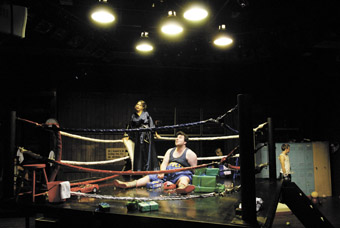
Phaedra’s Love
photo Heidrun Löhr
Phaedra’s Love
phaedra’s love
In infinitely more intimate surroundings—the Australian Theatre for Young People Studio One—director Kate Gaul, designer Alice Morgan and lighting designer Verity Hampson create a boxing gymnasium—replete with ring, lockers and plenty of bags for pummelling—for Sarah Kane’s Phaedra’s Love, her adaptation of Seneca’s Phaedra. The creative team take the boxing conceit and run with it: prince Hippolytus inhabits the ring where he will eventually be defeated, individual scenes are treated like bouts (numbers held aloft) and members of the court hang sullenly about, exercising, shadow boxing, clambering in and out of lockers, eyes on the main action in the ring. Visitors—clergy, cops—come and go, and the audience are packed in closely and steeply around the action.
While the boxing gym conceit is hardly subtle, it matches the combative drive of Kane’s writing, the organised violence of an extreme sport parallelling the structured power of the state and the capacity for both to go beyond their limits (as we increasingly experience in our own time). It also allows Gaul to give more young performers valuable experience of stage time, later coming into their own as a furious, vocal populace, while generating a sense of things overheard and turned a very blind eye to in Hippolytus’ corrupt court.
Centre-ring, Hippolytus gorges on snacks and video entertainments and masturbates into a sock. His stepmother Phaedra makes incestuous advances, a game she cannot win—the surfeited Hippolytus feels little in the way of desire, making death an attractive option. Michael Cutrupi as Hippolytus and Emily Ayoub as Phaedra both make the most of their physical (if not vocal) investment in their roles—his slow weight belying the capacity for verbal and physical attack, her stuttering, dystrophied movements suggesting deep-seated involuntary drives. Gaul drives the show fast, her performers delivering Kane’s acerbic dialogue—with its rapid, punchy alternations—briskly and without too much nuance, although Bjorn Stewart in particular, as King Theseus, manages to rise to the demands of Kane’s dark poetry in his brief appearance. Phaedra’s Love is often grossly and gorily comic (there’s plenty of blood and guts in the murder and castration of Hippolytus), but, for all its blunt pugilism, the production manages to convey the despair underlying both Hippolytus’ condition and the state he ruinously governs in his father’s absence.
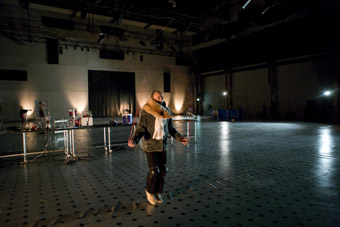
Salome In Cogito Volume III
photo Brett Boardman
Salome In Cogito Volume III
new design directions
Most theatre reviewing focuses on plot, character and theme and secondarily on the various aspects of design. But with a new generation of designers under the influence of Wilson, Castelluci, Viebrock and contemporary art, architecture and new media, set design increasingly calls attention to itself as a major part of the dynamic of realising a vision, and is more than simply illustrative or symbolic. New performance spaces, like the main theatre in Sydney’s CarriageWorks and elsewhere around the world [RT84, p16], allow for monumental, sculptural and multimedia stagings and new ways of placing audiences. Elsewhere, the new meticulousness in the visual arts resonates with a design realism that is almost surreal—the complete house on a revolve in Benedict Andrews’ production for the STC of Patrick White’s The Season at Sarsparilla (designer Robert Cousins) or the Kohn-Ferguson faithful reproduction for Antigone of the interior of a community hall that the director had once worked in.
After seeing Antigone and Phaedra’s Love, it seemed only right to take in The Rabble’s Salome, In Cogito Volume III (read the review on page 37), not least because a young company was tackling the huge CarriageWorks theatre space. The mix of aged interior (left largely untouched by the architects) and modern fittings meant that the theatre itself did much of the design work, various props and other items shaping it: a perspex box for John the Baptist’s cage; a table of chemistry lab equipment for a modern manipulative Salome; a bright blue above-ground pool for her baptism. Above all the space was made coherent by lighting (on a row of old metal columns, in a line of fluoros) and particularly by the carefully mapped trajectories of the performers in their obsessive travellings
Although derivative of the work of Romeo Castellucci from title to lighting, to the presentation of compulsive and obsessive states of being and damaged bodies, and although unable to match the way Castelluci builds an image or seizes the moment to confound us, this young, inherently more conventional theatrical company showed courage in working an uncompromising space (direction, design, lighting Emma Valente, design Kate Davis). It’s a pity that companies like The Rabble and those working the smaller but also capacious second theatre (the one home to the Performance Space program) in CarriageWorks, rarely have the production funds and resources to make the very best of their visions. Much of the responsibility for realising a design concept now falls to lighting and sound designers and to sets and walls that double as screens, since video projection, while stretching director and designer inventiveness, is often an effective and less expensive way to transform a space.
Company B, Antigone, writer Seamus Heaney from Sophocles, director Chris Kohn, performers Katie Fitchett, Gillian Jones, Deborah Mailman, Pacharo Mzembe, Boris Radmilovich, James Saunders, Hazem Shammas, Paul Blackwell, designer Dale Ferguson, lighting Luiz Pampolha, composer & sound designer Jethro Woodward; Belvoir St Theatre, Sydney, April 5-25; Sydney Theatre Company, The Serpent’s Teeth, writer Daniel Keene, director Pamela Rabe (Citizens), Tim Maddock (Soldiers), performers STC Actors Company, designer Robert Cousins, costumes Tess Schofield, lighting Nick Schlieper, composer & Sound designer Paul Charlier; Drama Theatre, Sydney Opera House, April 24-May 17; Melbourne Theatre Company, Rock ‘n’ Roll, writer Tom Stoppard, director Simon Phillips, designer Stephen Curtis; Sydney Theatre, April 11-May 17; Australian Theatre for Young People, Phaedra’s Love, writer Sarah Kane, director Kate Gaul, performers ATYP members, designer Alice Morgan, composer & sound designer Daryl Wallis, lighting Verity Hampson; ATYP Studio One,The Wharf, Sydney, April 1-12
RealTime issue #85 June-July 2008 pg. 40,41
© Keith Gallasch; for permission to reproduce apply to realtime@realtimearts.net
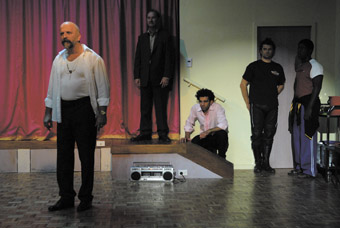
Company B, Antigone: left – right Boris Radmilovich, Paul Blackwell, Hazem Shammas, James Saunders, Pacharo Mzembe
photo Heidrun Löhr
Company B, Antigone: left – right Boris Radmilovich, Paul Blackwell, Hazem Shammas, James Saunders, Pacharo Mzembe
I GREW UP IN HOBART, TASMANIA, THE ONLY CHILD OF A MIXED-RACE FAMILY OF ANGLO-CELTIC AND CHINESE PARENTS. IN THAT CITY, AT THAT TIME, WE WERE RARE SPECIMENS AND WE CLUNG DEARLY TO OUR INDIVIDUALITY, SO UNIQUE WAS OUR RACIAL ABERRATION. AS A TEENAGER, I SPENT A LOT OF TIME PLAYING A GAME I CALLED “SPOT THE NON-CAUCASIAN.” WHAT A REVELATION IT WAS FOR ME THEN, WHEN I MOVED TO THE MAINLAND IN PURSUIT OF A THEATRE EDUCATION, TO FIND THE STREETS OF MELBOURNE DENSELY POPULATED WITH EVERY SHADE OF SKIN COLOUR IMAGINABLE, INCLUDING A SIGNIFICANT, BUT CERTAINLY NOT EXCESSIVELY DOMINANT PEPPERING OF WHITE.
It was the first time I didn’t stick out like a sore thumb, but rather, blended happily into the raucous, bustling mix. It seemed that the future of racial tolerance and multicultural visibility was beginning to become a very present reality. However over the years this has not been my experience as an actor. My illusions were shattered fairly swiftly after graduating from the VCA. Outside of the safe and cloistered walls of drama school, where cross-racial casting is only practical, our approach to cultural diversity in the theatre is in a tragic state.
In her 2007 Platform Papers essay, Cross-Racial Casting: Changing the Face of Australian Theatre, Sydney director Lee Lewis argues that Australia’s mainstages are filled with casts where the non-white performer is embarrassingly under-represented. She points strongly to the fact of ‘incidental discrimination’ within casting, artistic directorship and management, and scrutinises these ideas thoughtfully and with more than a smattering of passionate fire and brimstone. Lewis has raised arguments that have not necessarily been popular, nor necessarily representative of opinions of any number of theatre practitioners and administrators. However they are arguments that needed to be given voice, perhaps for the very fact of their unpopularity.
Lewis returned from New York in 2001 where she’d worked in theatre for 10 years. “Cross-racial casting was virtually, it seemed, a moral and political imperative in New York and, in the light of the profile that successive prime ministers were happy to trumpet of Australia as ‘a multicultural nation in Asia’, I could not help but wonder why that national identity was not reflected by [mainstage Australian theatre companies].” Lewis argues that Australia’s mainstages desperately lack the cultural diversity that is undeniably evident in the country’s largest capital cities. For too long, programming and casting choices have disavowed those whose appearance is not, largely speaking, white. It seals off a vast proportion of the population, and these choices, Lewis asserts, in turn have the flow-on effect of influencing our “national future imaginary”, or the way in which we see ourselves as a country across successive generations.
Much of the resistance to Lewis’ argument can, of course, be traced to the bottom-line, and she plainly acknowledges that cross-racial casting is not without risk. In trying to run large cultural organisations, a multitude of factors must be taken into account in order not to make a great, whopping loss at the end of the financial year. To sit on the fiscally responsible side of the line, considerations must be made safely within the sights of time management and ticket sales. While this manner of thinking is not unfamiliar in the economically rationalist world, it is undeniably anti-art. We no longer have an imperative that focuses on presenting challenging and thought-provoking work but rather, organisations bent solely on survival rather than evolution.
It goes without saying that as an artistic director, a great depth of experience, intelligence and passion goes into casting and programming, and not for a second is Lewis suggesting otherwise. However, what she pursues in her argument is the big “What if?” What if artistic directors of our national mainstages (with all the passion, rigour and intelligence that they apply to other vocational activities) maintained an essential imperative, a fundamental responsibility to engage in aggressive cross-racial casting? What if they did this to not only represent their moral and political ideals, but also as a visionary gesture towards the great ideal of art? What if artistic practice within Australia’s mainstage theatre companies demonstrated a progressive cultural leadership, and that exciting, thought-provoking, cross-racial casting choices were indisputable evidence of this fact? This is the mainstage theatre that Lee Lewis imagines, and one that we, as artists, audiences and members of a multi-racial nation now need to be completely dedicated to making manifest.
During a forum that accompanied the Melbourne launch of her essay, Lewis pointed out that there had been significant conversations about diversity in casting in the 1980s and 90s which ceased shortly thereafter. These were conversations, she said, “that should have made this paper redundant.” This issue has been aired, debated and, often before now, dropped. Affirmative action, quotas, reverse discrimination: all these ideas have somehow come through the wringer sullied, and sounding slightly ridiculous. Progress has been minimal, and often non-existent. There are huge numbers of theatre artists for whom this matter has profound significance and for whom the discussion incited by the paper is a massive revelation. Is it not the responsibility of us all—the fresh-blooded and the veteran—to keep the debate alive and out loud, to ensure that the conversation about cross-racial casting and its practical application does not go away in the same way it did over a decade ago?
Prime Minister Kevin Rudd’s recent apology to the Indigenous Australians of the Stolen Generations was a significant step in redressing a major wrong, a skeleton repeatedly shoved to the back of Australia’s political and social closet. The United States is possibly on the verge of electing its first ever African-American President, almost 150 years since that country’s abolition of slavery. Change is in the air, but it isn’t coming fast enough. Here, the children of Cambodian, Serbian and Sudanese immigrants still almost never see Australians like themselves represented in the theatre, and furthermore, their hopes to be fruitfully employed in the future on their country’s mainstages remain sadly, very slim.
For other responses to Lee Lewis’ paper, including those from Nicholas Pickard, Julian Meyrick and Neil Armfield, who defends the record of his Company B in cross-racial casting, see the Readers’ Forum in Platform Papers No 15, A Sustainable Arts Sector, Jan 2008.
Lee Lewis, Cross-Racial Casting: Changing the Face of Australian Theatre, Platform Papers No 13, Currency House, July 2007
RealTime issue #85 June-July 2008 pg. 38
© Ming-zhu Hii; for permission to reproduce apply to realtime@realtimearts.net
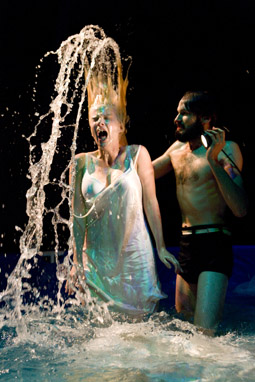
ary-Helen Sassman, Pier Carthew, Salome In Cogito Volume III
photo Brett Boardman
ary-Helen Sassman, Pier Carthew, Salome In Cogito Volume III
PERFORMANCE ENSEMBLE THE RABBLE REFERENCE ITALIAN THEATRE DIRECTOR ROMEO CASTELLUCCI AS AN INSPIRATION FOR THEIR INTERPRETIVE SALOME IN COGITO VOLUME III. CASTELLUCCI IS WELL KNOWN FOR HIS EPIC THEATRICAL IMAGINATION AND INVESTIGATION OF FORMAL TRAGEDY ACROSS EUROPEAN CITYSCAPES. INDEED IN THE TRAGEDIA ENDOGONIDIA SERIES, SEEN IN PART IN THE 2006 MELBOURNE INTERNATIONAL ARTS FESTIVAL, CASTELLUCCI DEMONSTRATES A MASTERFUL POST-DRAMATIC POETIC, PRIVILEGING SENSORY AND AFFECTIVE IMAGES AMIDST THE ARRHYTHMIC DRAMATURGIES AND DISPLACED SIGNIFIERS OF BROKEN PLACES. A BABY APPEARS ON STAGE. IT COOS. AN OLD MAN IN A BIKINI. HE UNDRESSES. A POOL OF BLOOD SPURTS FROM A BOTTLE. A POLICE BASHING. EXCRUCIATING LOUDNESS. A CITY UNRAVELS.
Salome In Cogito Volume III reads as an awkward homage to Castellucci and yet still offers much to be praised by way of its own striking visual and dramatic innovation. In particular there is the dramaturgical compulsion to sustain and release images in just the right breath, set alongside gurgling sound pulses that patter or strike the space along with sequences of flashing, horizontal light. The space itself deserves applause for its intense grandiosity: this cavernous theatre at the CarriageWorks has never been opened up in quite this way. Tall, bold columns and angry doors flank a cold and sinister marbled court. It seems we are in the domain of European aristocracy, save the ominous oversized above-ground pool and the unavoidable sense that the marble is actually its poorer cousin, linoleum, rippling in disguise.
The performers inhabit this space with fragments of repetitive action, guttural noise, durational acts, slow walking, vomit, jelly for blood, fake blood, spurting blood, flour, rancid cream, acts of bestiality and other theatrical pornographics that aim to poetically render Salome as a contemporary cultural narrative. The biblical figure of Salome, step-daughter to Herod and daughter to his incestuous wife Herodias, has come to represent the ultimate horror story of the power of female seduction. Granted a wish by Herod, Salome requests John the Baptist’s head in order to redeem the reputation of her besmirched mother. Oscar Wilde adapted this tale, giving some oomph to Salome’s motivation: her affections for John were rejected and so she had him promptly disposed of. Out of this we understand that Salome represents rottenness itself. The Rabble aren’t about to redeem her.
Salome and the court spend the evening hungering, it seems, for death, each other, sex, more death, food and blood. They each emit a signature breathy pant that at first iteration is interesting but quickly loses effect as we fail to understand what is so desperately desired, save the act of performing desire itself. In gothic bride white, Salome haunts the court with acts of indiscretion: a complex scientific experiment with meat off-cuts produces some sacred drinking juice; a game of chase is repeated but never resolved. Meantime, King and Queen ponce about the emptiness of their political wasteland and a dog figure belches and swerves, chained by a bungy rope to a pylon from which she can strangely self-release. Upstage, John the Baptist is made a minuscule specimen, framed in the warm, seedy light of a perspex display cabinet. We all know what is coming for him—it’s just a matter of time. And how.
Salome In Cogito Volume III is an admirable take on the breadth of postdramatic poetics, if perhaps a less interesting take on the thematics of Salome the Biblical tale or Wilde’s among many others. This is its biggest weakness, but hopefully the production bodes well for The Rabble’s future experiments. For Castellucci, tragedy is “a mechanism to expose the dead body.” The Rabble are working very well on the mechanism, but what they want it to expose is less clear.
The Rabble, Salome In Cogito Volume III, director Emma Valente, performers Mary Helen Sassman, Daniel Schlusser, Syd Brisbane, Pier Carthew, Dana Miltins, design Kate Davis, dramaturg Daisy Noyes, lighting Emma Valente, sound design Max Lyandvert; CarriageWorks, Sydney, May 7-17
RealTime issue #85 June-July 2008 pg. 37
© Bryoni Trezise; for permission to reproduce apply to realtime@realtimearts.net
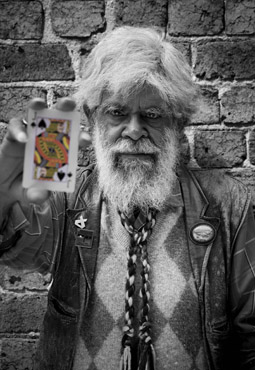
Jack Charles
photo Kerry Pryor
Jack Charles
WHEN THE AUSTRALIAN PERFORMING GROUP WAS SEARCHING FOR AN AUTHENTIC AUSTRALIAN VOICE, NIGHTSHIFT PRESUMED THAT VOICE HAD ALREADY BEEN FOUND AND, INSTEAD, WENT IN SEARCH OF ‘AUTHENTICITY’ ITSELF. THIRTY-FIVE YEARS LATER AND SITTING IN LA MAMA, THE SAME THEATRE WITHIN WHICH THAT SEARCH FOR AUTHENTICITY BEGAN, PHIL MOTHERWELL, SHIRALEE HOOD AND JACK CHARLES ARE STILL CHASING THE TRUTH. ON THE EVE OF THEIR TRIBUTE SHOW [P37] TO DIRECTOR LINDZEE SMITH WHO DIED LAST YEAR [RT78, P35], NIGHTSHIFT WOULDN’T HAVE IT ANY OTHER WAY.
You cannot prophesy the future without reflecting on the achievements of the past. The two are interchangeable, as are life and art. So when I put it to the group that a prominent Melbourne director explained his experience with Nightshift in the late 70s as: “The moral thrill of theatre, akin to electrocution”, Hood draws a sharp breath, but it is Motherwell who is vaulted upright. “We wanted to create a theatre that had the immediacy of a rock concert. Lindzee was right into Brecht: direct statements close to the bone, and pretense was an ugly word. It was a theatre of ideas, but it was visceral.”
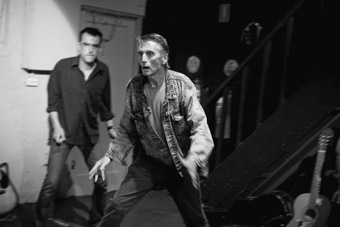
Gary Carter & Phil Motherwell
photos Kerry Pryor
Gary Carter & Phil Motherwell
As a theatre practice concerned with authentic expressions of the immediate, it makes sense that Nightshift’s current production grapples with post-apology Australia and the Stolen Generations. Hood and Charles are Indigenous Australians, and Motherwell’s play Steal Away Home is explicitly based on Charles’ life. And even though there is some ambivalence as to whether this current production is a continuum of the Nightshift oeuvre or a new theatrical collaboration, Hood, who first worked with Lindzee Smith in Perth during the 90s, takes up the charge. “Rudd’s apology is an opportunity for white Australia to have a go at understanding our story…All of the time my mother spent searching for her family she could have been consolidating her economic base. This was time wasted, and there has to be compensation…” Nightshift’s personnel may have changed since the late 60s, but its tradition of resistance continues in the form of direct political action.
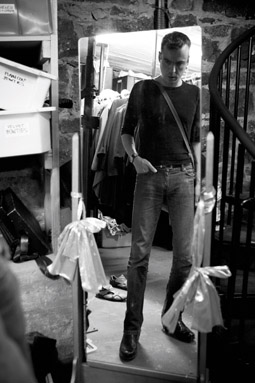
Garry Carter
photo Kerry Pryor
Garry Carter
Resistance always involves an element of danger, and tying ribbons around tree trunks was never part of Nightshift’s modus operandi. Motherwell embraces Jack Charles, describing him as a “Living legend…The Ben Hall of Australian theatre”. The outlaw metaphor is apt, as Charles’ polite manner belies a charm that is as disconcerting as it is seductive. “They only ever got me when they wanted a blackfella”, he says, referring to the colour-blind casting that continues in Australia to this day. And opportunities for Charles were further limited due to an extended holiday at Her Majesty’s Pleasure, but he was not alone in prison. Motherwell’s addiction to heroin was once also out of control. In desperation, he robbed three banks with a hand concealed in his pocket, received five years jail with a three year minimum term, but was out in 16 months. He recalls Lindzee Smith visiting him in that “Disneyland of despair” just prior to the publication of Motherwell’s little known classic, Dreamers of the Absolute [a play based on the transcript of the trial of anarchists in pre-revolutionary Russia; it was performed by Nightshift in Melbourne in 1978 , Troupe in Adelaide in 1979, and Smith directed it for the Adelaide School of TAFE in 2002. Ed]. “Lindzee waltzed into the Governor’s office with a secretary on his arm and declared: ‘I’ve got some business to discuss with Mr. Motherwell.’” After Smith’s visit to Pentridge, A Division would never be the same again.
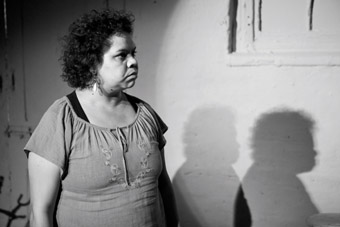
Shiralee Hood
photo Kerry Pryor
Shiralee Hood
In discussion with the Nightshift ensemble, the talk always oscillates between the stage, the page and that book of life that is a memoir of the street, be it inner suburban Melbourne or the grimy avenues of New York. So I put it to Motherwell that Dreamers of the Absolute is not just a study of the revolutionary impulse but also a manifesto for the theatre terrorist. “Dreamers” he says, “grew out of the anti-war movement. It wasn’t about a metaphorical terrorism, more a terrorism by the State; an established order that had to be undermined…I mean, we’ve only got the Pentagon’s word on terrorism, and we’ve learnt not to trust that, haven’t we?” So true, but why in Lindzee Smith’s written introduction to the play did he quote and thereby personalise the line, “The terror’s a cross it’s so hard to bear”? And why did Motherwell cast himself in the role of the revolutionary, Alexis? A wry smile appears in one corner of Motherwell’s mouth. We both know the answer to that question, but we’re not about to hear it today. Instead, still searching for an authentic expression of the immediate, Motherwell cracks us all up. “I used to write stuff just to give myself a part…Don’t laugh, it’s true.”
Nightshift reading
For a brief documentary account of Nightshift and its place in the functioning and the politics of the APG, if not for an evocation of the group’s powerful works, see Gabrielle Wolf, The Australian Performing Group, the Pram Factory and New Wave Theatre, Currency Press, Sydney, 2008. For vivid personal accounts of the Nightshift experience from Richard Murphet and Lindzee Smith (in an interview with Sue Ingleton), see the memoirs section of www.pramfactory.com. See also the Smith obituaries from James Shuv’us and Jai McHenry Derra at http://lindzeesmith.blogspot.com and Richard Murphet [RT 78, p35]. Phil Motherwell’s Dreamers of the Absolute was published by Yackandandah Playscripts in 1985. Eds.
RealTime issue #85 June-July 2008 pg. 36
© Tony Reck; for permission to reproduce apply to realtime@realtimearts.net
![Lindzee & Steve [Wilkinson] under the Brooklyn Bridge](https://www.realtime.org.au/wp-content/uploads/art/19/1971_reck_underbrooklynbridge81.jpg)
Lindzee & Steve [Wilkinson] under the Brooklyn Bridge
image Tim Burns
Lindzee & Steve [Wilkinson] under the Brooklyn Bridge
LINDZEE SMITH DIED LAST YEAR, BUT I SWEAR TO YOU I CAN SEE HIS FACE IN A PROJECTED IMAGE OF LABYRINTHINE IRON BARS SPLAYED ACROSS LA MAMA’S REAR WALL. THE SPIRIT OF THE FORMER OCEAN GROVE IRON MAN PERVADES THIS PRODUCTION: IF NOT IN ITS COMPLEX ENTANGLEMENT OF JAIL CELL DOORS, THEN IN ITS IDIOSYNCRATIC PRODUCTION STYLE. AN URGENT NEED TO EXPRESS THE INNER LIVES OF THOSE RESIDING OUTSIDE THE LAW DRIVES THIS TRIBUTE—SMITH, A MAN WHO WRENCHED ART FROM LIFE’S GURGLING AND GROANING, AND REFUSED TO LET GO.
This celebration of Nightshift, the 1970s offshoot of the Australian Performing Group (APG), consists of three plays and two films by lifelong Smith collaborators Phil Motherwell and Tim Burns. The plays comprise the earlier part of the show, but it’s best to begin any assessment with the final film of the night, Burns’ Thus Went Phillipa. This brutal exploration makes explicit Smith’s obsession with the link between art and life: the same obsession that inflects Motherwell’s writing with its poetic nuance. A gaunt Smith is shown smacked out in an Alphabet City squat. Watching him wield a blood filled syringe as he probes for a recalcitrant vein, Thus Went Phillipa comes across as a response to the collapse of Leftist politics, and a gradual awareness among its disciples that they were mistaken in their assumption that an unjust society could be transformed by direct action alone. Transformation must come from within and, even though the belief that heroin-induced dreams could precipitate this transformation was also misguided, Burns’ film displays a concern to explore an interior world: one exemplified by a dream-state junkie, Phillipa.
In contrast, Political Transmission is conceived as a Brechtian vision of the Left’s role in world affairs, particularly the fascist overthrow and 1973 assassination of Allende in Chile. Following an early diagnosis of lupus, the blood disease that eventually killed him, Smith is laid up in a New York hospital, his immune system ravaged by rampaging anti-bodies. Smith’s political diatribe heard voice-off is a didactic call to arms in response to a rise in fascism: an unhealthy political ideology attempting to overthrow a healthy social system. The film ends with a revitalised Smith catching a plane to Melbourne in preparation for some direct action of his own: a performance of Motherwell’s radical play Dreamers of the Absolute.
Motherwell himself then appears on stage, introducing three monologues rejigged for ensemble performance. Actor Isaac Drandich is a conduit for our electrified attention in his performance of The Fitzroy Yank. Ambiguous in its representation of a raconteur imprisoned by the mania of outrageous dreams, Drandich’s articulation of the Yank suggests an actor of twice his experience. But it’s when the ensemble comes together in The Native Rose and Steal Away Home, that Burns’ films, Motherwell’s plays, and Smith’s omnipotent spectral presence unite in an unlikely collision of the biographical and the highly imaginative.
In The Native Rose, Shiralee Hood delivers each line directly to the audience. The setting is a park on Anzac Parade in Sydney. The dope shootin’ and destroyed Rose finds communion on the street in the shape of damaged soldiers returning from World War II and a string of like-minded conspirators who thieve and drown their disfigured lives under the disapproving eye of a statue of Captain Cook. Equally at home in Motherwell’s inner suburban milieu, or Burns’ New York, it’s the lives of the disenfranchised transforming despair into hope that underscore Nightshift’s confronting directorial style.
And so it is in Steal Away Home that actor Jack Charles discovers his past is also present in the future. Charles’ truant childhood becomes an acute expression of the poetry drawn from drab Housing Commission homes, and a life that knows no other angle than that of living on the edge. So when Billy Tisdall dons a judge’s wig and indignantly declares to Charles, “You’ve robbed County Court Judges…”, the mischievous giggle from Jack’s tiny frame presents not just as a healthy disrespect for the dubious institution of the law, but as a response to Aboriginal dispossession. By having his past stolen from him, Charles has instinctively chosen to Steal Away Home.
Later, when riding my bicycle through Lindzee Smith’s old stomping ground, I sense his spirit in the streets. Although largely unrecognised, and despised by the mainstream, his eyes smile bright in the dark urban night. The lyricism of the tribute at La Mama has roused him from the earth, exposing the poetic heart of Nightshift.
Nightshift, writer, director Phil Motherwell, filmmaker Tim Burns, performers Lindzee Smith (on film), Isaac Drandich, Gary Carter, Shiralee Hood, Jack Charles, Billy Tisdall, projection Ian De Gruchy, music Joe Dolce, lighting Gabriel Townsend; La Mama, Melbourne, March 12-23
RealTime issue #85 June-July 2008 pg. 37
© Tony Reck; for permission to reproduce apply to realtime@realtimearts.net
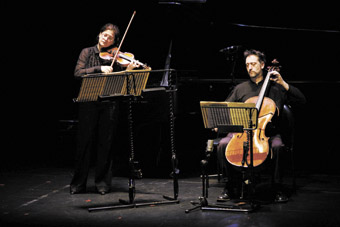
Telesto Duo (Tiziana Pintus and John Addison) performing Constantine Koukias’ Byzantine Reflections
photo James Knowler
Telesto Duo (Tiziana Pintus and John Addison) performing Constantine Koukias’ Byzantine Reflections
BY EARLY APRIL, ADELAIDE WAS SHOWING SIGNS OF FESTIVAL EXHAUSTION. INDEED, LOCAL ART SPACE AND EXPERIMENTAL MUSIC VENUE GALLERY DE LA CATESSEN, HOSTING FOUR PERFORMANCES IN FIVE DAYS, A RARE FEAT FOR UNDERGROUND MUSIC IN THIS CITY, CHEEKILY ASKED IN THEIR PROMOTIONAL FLYER, “IS THIS A FESTIVAL TOO?” THOUGH OBVIOUSLY HUMOROUS, THAT GENTLE POKE IN THE ADELAIDE CONTEMPORARY MUSIC FESTIVAL’S DIRECTION CUT TO THE QUICK: THE ACMF PROGRAM FELT BOTH SAFE AND ARBITRARY, ITS NAMING QUESTIONABLE.
Debates over genre are rife within this field. From contemporary through experimental, avant-garde, new music and so on, the ownership function of these concepts is connected more to overarching institutional frameworks—conservatoriums, funding bodies and so on who require a shorthand to codify the output of composers—than wider and less institutionally dictated discursive practices in what constitutes ‘the contemporary.’ Thus, the taxonomical anxiety at the heart of ACMF manifested directly in the festival’s program, with Russian composer Alfred Schnittke’s Piano Quintet (1972-76), in particular, almost voluptuously romantic.
The sentimentality of this quintet is doubtless due, at least in part, to its dedication to the composer’s mother, but Schnittke’s romanticism nonetheless stuck in the craw in the context of a ‘new music’ festival. Having said this, the quintet was still the most enjoyable entry in the Gala Concert. But while the Grainger Quartet have great facility to their vantage, their delivery across the program felt hermetic and uptight. One wonders how much this has to do with the relative conservatism of the program: with wilder, more open works perhaps the quartet could excel. As it was, pieces such as English-Australian polymath Andrew Ford’s A Reel, A Fling And A Ghostly Gallard: String Quartet no 2 (2006)—whose opening pauses promised plenty, only to give way to ‘celebratory dances’ that lacked exuberance or fire—didn’t offer enough challenge to these capable players.
The Telestos Duo of Tiziana Pintus (violin) and John Addison (cello) were more generous in their performances, though their material at the Gala Concert left them wanting. English-Australian composer Tristram Cary’s Messages For Solo ‘Cello (1993) featured some passages that were quite evocative, but overall the composition is too starchy, and while Addison performed strongly, the material offered little freedom to move. Indeed, the late Cary’s great contribution to modern music lies in his pioneering electronic work. At the ACMF’s second day of programming, held at the Festival Centre Artspace, soprano Greta Bradman performed his I Am Here (1980). Bradman possesses a fine voice, but the spray of phonemes created by Cary collaborator Peter Zinovieff’s text, coupled with the overworked performativity in Bradman’s delivery, fought against the tape accompaniment. The tape elements also needed to more clearly work the grain and texture of the tape into the compositional outcome. As it was, this sound source favoured the logic of process over the tactility of outcome.
I Am Here was preceded by a festival highlight: the Telesto Duo’s breathtaking performance of Russian composer Sofia Gubaidulina’s sonata for violin and cello, Rejoice! (1981/88). While Gubaidulina’s compositions are sometimes played with too much emotive flair, which leads to performances that link the spirituality and ‘profundity’ of her compositions to overtly ‘deep’ gestures, Telesto Duo approached Rejoice! with the right amount of studiousness. Particularly affecting was a series of harmonics, quietly wrung from the violin by Tiziana Pintus, which held the collective breath of the Artspace audience and briefly transformed the space’s antiseptic vibe into an ennobled zone—reflective and smart, without any recourse to pious display.
ACMF’s problem lies in the ambivalence it engenders in any critical member of the audience; the festival feels too benumbed to have any interventionist impact. While it glances toward electronic/tape music, its too slight acknowledgement of prepared or extended technique and its seeming ignorance of improvisation—two of the most significant leaps made by classical music in the 20th century—leaves one wondering which decade the contemporary in the title refers to. This may seem rather harsh criticism, and Gabriella Smart certainly deserves a tip of the hat for organising an event that leads one to ask these questions. But if new music or contemporary music (or whatever turn-of-phrase you use to box it in) is to make significant advances, festivals like ACMF need to pull off their blinders.
Adelaide Contemporary Music Festival, Adelaide Festival Centre, April 4-6
RealTime issue #85 June-July 2008 pg. 50
© Jon Dale; for permission to reproduce apply to realtime@realtimearts.net
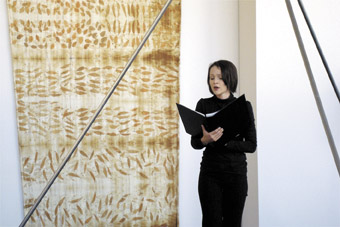
Greta Bradman sings Tristram Cary’s I Am Here at Adelaide Contemporary Music Festival
photo Mark Patterson
Greta Bradman sings Tristram Cary’s I Am Here at Adelaide Contemporary Music Festival
The editors were saddened to hear of the death of composer Tristram Cary, the pioneer of British electronic music in the 1960s who later spent much of his life in Adelaide. In the UK he composed for film (including The Ladykillers and for Hammer Films, Quatermass and the Pit, Blood from the Mummy’s Tomb) and television drama as well as making a pivotal electronic contribution to the sound world of Doctor Who. Cary built sound environments with multiple film loops, designed electronic sound studios and developed the synthesizer into the widely influential VCS3. In the mid 1970s he moved to Australia, directing the Electronic Music Studio at the Elder Conservatorium, Adelaide University, composing and setting up his own business. In 1991 he received the Medal of the Order of Australia. His legacy is to be found not only in CDs of his TV music, in Soundings, a CD collection of his electronic and electro-acoustic works, and in his recorded film music, but above all in Cary’s influence on the role of electronic sound in a huge range of musics and performance. Tristram Cary died in Adelaide on April 24. RT
RealTime issue #85 June-July 2008 pg. 50
© RealTime ; for permission to reproduce apply to realtime@realtimearts.net
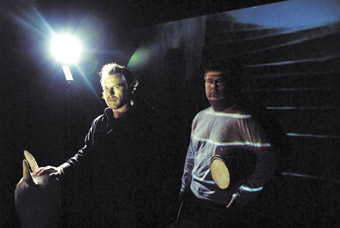
rePercussions of Movement, courtesy the artists
SOMETIMES I SEE A STAGE SET WITH PERCUSSION INSTRUMENTS AND THINK OF A COLONY OF INSECTS READYING TO FIGHT, OR DANCE. GONGS HOLD A SILENT HYMN; A PHALANX OF MARIMBAS STAND READY FOR COMBAT; TUBULAR BELLS FORM A SCREEN BEHIND WHICH AN ARMY MIGHT APPEAR. THIS IS THE SETTING FOR A CONTEST OF MINDS, BODIES, TIME AND SOUND, IN A DANCE OF SPEED, STRENGTH AND SUBTLETY. AN ARCHITECTURE OF ANTICIPATION DRAWS ME IN.
The first time I heard the work of Iannis Xenakis, I perceived great cubes of sound, looming and leering, pushing space through different geometries. Sound is monument, mathematics, repetition, disfiguration, reconstruction. A Herculean effort, splintering and shifting cultural and aural mountains.
Here too, in Synergy’s recent Sydney concert, his works push boulders, gravel, stars, tonalities, habits of composing and of listening, but they also invite playfulness. In Psappha, soloist Timothy Constable becomes Spiderman traversing a scaffold. He plays a contest between a glockenspiel and concert bass drum, his stick suspended above the drum as if it were the moment before its death. In this piece, Constable could well have pushed the physicality more— a Cossack leap would not have gone amiss to amplify this contest between space and sound.
But what happens when the span of space between instrument and player becomes altered by technology? When sound is computerised with amplification and touchpads, it’s easy for action to become minimal. Beyond a finger twitch, the physicality of the performer can virtually disappear. When such work is integrated with visual projections and human movement, you are either reaching for heaven or creating a space too loaded with significance for either performers or audience to survive the experience.
RePercussions of Movement at Canberra’s Street Theatre is a case in point. Percussionist/composer Gary France worked in collaboration with video-maker/performer Kim O’Donnell to produce a multimedia work which promised “an intensive investigation of movement, physical and psychological, through a kaleidoscopic integration of percussion, images and spoken word.” I try to enter the performance space without being suspicious: my most satisfying musical/theatrical experiences are usually not itemised.
Street 2, a narrow space, is set with various electronic sound machines and a wide, curved projection diorama at the back. Strange, neo-primitive sculptures occupy the floor, like humanoid plinths in meltdown. I never manage to fathom their relationship to the two performers.
RePercussions of Movement seems caught between conflicting impulses—between primitive and aesthetic, kinetic and meditative, contemplative and didactic. The small floorspace appears static, despite being punctuated by O’Connell’s running or his falling to the ground. France’s soaring arm as it plays the Handsonic Touchpad draws far too much attention to itself by comparison. It is the most interesting movement in this space.
The diorama is awash with projected images sourced from eastern and middle-eastern places—an awkward travelogue [but whose?] of minarets, prayer flags, turning dharma wheels and polluted cities. The images manage to be both idealised and condemnatory. Undoing some fine cross-cultural sonic evocations from the video-maker, we are given some 40 minutes of visual Orientalism burdened with (Western) shame. Whose karmic burdens are these? Whose guilts and obsessions?
But most difficult, for me, are the sombre passages of text. We are warned to pay attention, to beware our lusts and desires: “We exist to bear witness to the world”. “The most dangerous place is the mind.” It seems dangerous to negate the organ most called upon to receive the work.
Awkwardly, rePercussions’ eco-warrior tone recalls Koyaanisquatsi (but without its awesome impact) and its rather static relationship with ideas and texts reminds me of an early 1980s sound-text performance of Charles Amirkhanian. An earnest Amirkhanian, wearing a boiler-suit, would stand in front of a single, static, slide-projected image of repeated words, reciting the same two words. His mouth was the only part of him that moved.
Henri Bergson, who is quoted in rePercussions’ text, writes stunningly of the “shivers” which occur when perception and memory are freed to enter and re-enter the present. I re-remember so many moments of Xenakis’ Psappha (also of his Claviers and Peaux in the same Synergy concert). Unhappily, within rePercussions there are too many impediments to this process. I am not even sure whether rePercussions wants to shiver me, which leaves me feeling strangely un-composed as I head for home.
See also Keith Gallasch's review of Synergy
Synergy Percussion, works by Steve Reich, Iannis Xenakis, performers Michael Askill, Timothy Constable, Bree Van Reyk, Alison Pratt, guest Jeremy Barnett; Carriageworks, Sydney, April 23-26
rePercussions of Movement, an audiovisual meditation on movement, with music and soundscape by Gary France, concept, film design, text, movement, voice Kim O’Connell, sculpture Jutte Feddersen; Street 2, The Street Theatre, Canberra, April 3
RealTime issue #85 June-July 2008 pg. 51
© Zsuzsanna Soboslay; for permission to reproduce apply to realtime@realtimearts.net
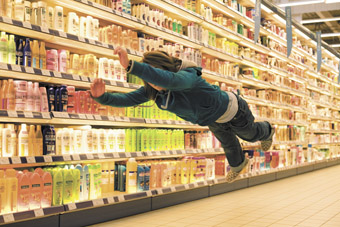
Hyper Nº04, Denis Darzacq, Perth Centre for Photography
THE HISTORY OF PHOTOGRAPHY IS LITTERED WITH CONTROVERSY. USED TO MOBILISE HUMAN RIGHTS CAMPAIGNS, AS A TARGET FOR FEMINIST CRITICAL THEORY, AND IN DISPUTES OVER THE LIMITS OF PRIVACY, IT HAS REDEFINED THE ETHICS OF THE GAZE. CONCEPTUAL PHOTOGRAPHY OFTEN PLAYS WITH ITS DOCUMENTARY OTHER BY TOYING WITH THESE ETHICAL BOUNDARIES AND BY CHALLENGING THE NATURALISTIC PRESUMPTION THAT THE CAMERA CAPTURES THE WORLD AS IT IS. THE EXHIBITIONS, SCREENINGS AND PAPERS THAT WORKED BEST IN FOTOFREO 2008 AT LEAST GLANCED AT THIS MEDIATED QUALITY, DOUBLING THE GAZE ONTO A MEDIUM THAT IT IS ALL TOO EASY TO TAKE FOR GRANTED.
Most of the work in Fotofreo 2008 was, however, printed onto the standard A0 to A2 size, and bordered with white developing paper, directing the viewer’s gaze into the illusion of the image. It was rare to find a photographer who drew the eye to the detail of the printed surface as much as to its depth. Perth photographer Alex Bradley’s compositions at Spectrum were one exception, encasing scenes from Hitchcock films in blood cells and drowning obscure television programs in images of sperm. Merging the televisual and biological, Bradley refracts classic cinema shots into sex toys and mass culture into mouths. His manipulations foreground the digital conditions by which images are now reproduced while most shows remained within a naturalistic mode.
Chinese artist Chen Nong’s handcoloured, back-to-back images of villagers standing amidst hillocks destined to be drowned by the Three Gorges Dam were also exceptional. On show at the Fremantle Arts Centre, they were painted in luminescent, twilight blues and golds, tinging the devastated landscape with a sense of hope. Dressed in handmade costumes to resemble the ancient terracotta warriors, the villagers appear like a ragged army that has survived some surreal, future war. Here are intimate monuments to a history of the present, if not to China itself—the enigmatic force of a new industrial age.
Similar monuments to industry were on show at the Fremantle Maritime Museum, in Toronto-based Edward Burtynsky’s commission to document the great, open cut mines of Western Australia. These large photographs shifted from the spectacle of immense depths and expanses, so unreal in themselves, to detailed textures of a land etched and colourfully scraped by machines and acidic chemicals. The tiny details of roads, trucks, tanks and huts are precisely rendered, but the actual scale of these mines remains difficult to fathom as they sit in land that has been burned silver and white by the acid in runoff. Both Nong and Burtynsky beautify devastation, toying with its scale and surface.
Impressive too was the multitude of smaller exhibitions promoted by FotoFreo, in new and innovative spaces for art. Crammed into the corridors of Fremantle’s ArtSource office were colourful portraits of youth in Hijacked. Curated by Max Pam and Mark McPherson, these photographers from Australia and the USA allude to personal worlds that have been washed in primary colours by the suburban experience—bright green grass, skies of uncanny blue, and eyes red from drinking. A show of Lomo photography, put together by West Australian artist Yolanda Stapleton for the small Keith and Lottie gallery, stood out for its unpretentious, low-fi images of everyday life from cult, retro cameras. The distinctive images created from Lomo Russian cameras, originally designed to imitate Japanese ones in the 1980s, have had something of a revival in the era of digital manipulation. Theirs is a lo-fi, homespun quality, a relief from the intensity of the high art and photojournalism genres that commandeered many festival spaces.
Such everyday qualities were also captured by French photographer Denis Darzacq at the Perth Centre for Contemporary Photography. Darzacq poses dancers in the conditioned air of supermarkets and bargain shops so that they appear to float above the aisles. One defies gravity in the frozen food section, while another appears to walk on air amidst lampshades and shampoos. The images offer a glimpse of human potential amidst alienating, hypercoloured worlds. Bodies, frozen in motion, seem to suggest a sense of infinitely slow duration, of enraptured stillness amidst the bustle of retailing.
While Darzacq plays with our naturalistic expectations of the medium, London-based Adam Broomberg and Oliver Chanarin at the Fremantle Prison Gallery parody the role of photojournalism in producing truth. Their small, four by five inch prints are linked in a catalogue of atrocity and obscurity. Rather than showing the victims of the Rwandan genocide, they exhibit the remains of discarded Kigali passport photographs; the heads have been cut out for other uses. The violence implicit in these artefacts lies in what we cannot see. So too in the photograph of a teenager’s bedroom, preserved since his murder, which sits next to proud portraits of a hunter and his game—buffalo, leopard, elephant…In an exhibition that defamiliarises and makes radical the naturalising function of photography, Broomberg and Chanarin show how the evidence of violence is not always violence itself.
Roger Ballen, an American who has lived in South Africa for 30 years, reveals a similarly deliberate approach in his work on show at the Art Gallery of Western Australia, playing with our ethical expectations of the medium. Traditionally, photographs of the poor and disadvantaged have been used to mobilise campaigns against discrimination, child poverty and war. But Ballen works with people living in housing estates in the neglected, old mining regions of South Africa to illuminate more universal, existential predicaments. He captures surreal qualities in the lives of these people, who develop performances and scratch drawings on fading walls for him. The photographs veer between the documentary format and a more artistically motivated one, testing the lines that we create between the intentions of artistic expression and the world as it is.
Despite many good exhibitions, including shows by Australians Marian Drew, Brook Andrew, Polixeni Papapetrou and Darren Siwes, only six of the 36 featured artists were women—despite the fact that many featured in the variously curated shows such as Hijacked and FotoLomo. Let’s hope to see more of them in 2010.
The status of the artist as genius creator, a notion familiar from emasculated, heroic discourses about modern art, does not sit comfortably at FotoFreo with either the photographic medium or within a contemporary art context, inflected as they are with postmodern ideas and new technologies. In the digital age, with its multiplication of cameras and after a loss of interest in the art object, the uncritical celebration of photographer as artist and the photograph as precious object, seems more quaint than relevant. This is why the more interesting exhibitions were more explicit in transgressing received ideas about the medium, such as its documentary function, as were those that broke with the established large print format for conceptual photography, and the various curated shows, which illuminated different aspects of the art rather than foregrounding a unique vision.
For more on 2008 Fotofreo see RT83, p50.
2008 Fotofreo, the City of Fremantle Photographic Festival, Fremantle & Perth, April 5-May 4, www.fotofreo.com
RealTime issue #85 June-July 2008 pg. 52
© Darren Jorgensen; for permission to reproduce apply to realtime@realtimearts.net
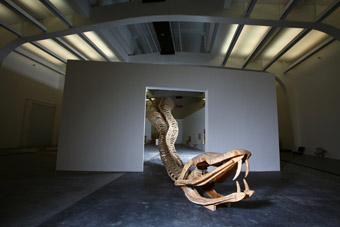
Huang Yong Ping, Python, 2000
courtesy UCCA
Huang Yong Ping, Python, 2000
RECENT MONTHS HAVE SEEN BEIJING’S FAMOUS 798 ART ZONE CONSUMED BY THE PRE-OLYMPICS ORGY OF DESTRUCTION, CONSTRUCTION AND RENOVATION THAT HAS OVERRUN MUCH OF THE CITY. DEPENDING ON WHO YOU ASK, THE RECENT SPATE OF DEMOLITION, BUILDING AND ROAD RESURFACING IS THE DEATH KNELL OF 798 AS A SITE OF CUTTING-EDGE CREATIVITY OR A SIGN THAT THE AREA IS FINALLY ASSUMING ITS RIGHTFUL PLACE AS AN ART ZONE OF INTERNATIONAL RENOWN. EITHER WAY, THE RENOVATIONS AND ARRIVAL OF MAJOR INSTITUTIONS LIKE THE ULLENS CENTER FOR CONTEMPORARY ART SIGNAL A NEW PHASE IN THE AREA’S SHORT BUT VOLATILE HISTORY.
One of those lamenting the changes is Huang Rui, who was among the first artists to establish a studio here in early 2002. Rui was a member of the Stars Group that kick-started China’s contemporary art movement in the late 1970s, following the end of the Cultural Revolution. He spent much of the 1980s and 90s in Japan, but by the turn of the century was back in Beijing and looking for a space to work. When fellow Stars Group alumnus Ai Weiwei introduced him to 798, Rui was immediately smitten. “I felt so comfortable,” he recalls. “I felt the atmosphere and architecture were perfect.”
in the beginning: artists & workers
The sprawling 1950s industrial complex was designed by East Germans to manufacture electronics for the military and is distinguished from thousands of other Chinese factories by its Bauhaus architecture. Distinctive features include sweeping arched support beams, saw-tooth shaped roofs, and skylights that maximise the entry of natural light.
When Huang Rui began working at 798, the factory had long been in decline, a victim of China’s economic liberalisation. Nevertheless, much of it was still in use. “All the workers were still here”, he reminisces. “20-30 per cent was empty, [but] most of the space was still active.” As word of the large, vacant spaces spread, more artists and galleries moved in, quickly followed by cafes, bars and a small theatre.
The industrial nature of 798 and the management’s lack of connection to the art world were key factors in the atmosphere of artistic freedom that blossomed in the burgeoning community. “Before 2000, the government hated contemporary art. But they didn’t really know what was happening inside 798”, explains Rui. “In other places people from the Xuan Chuan Bu [Propaganda Department] come to check the exhibited work.” But as a functioning factory, 798 fell outside the department’s jurisdiction.
The presence of industry also added a unique dynamic to the site. “[Initially] I think the workers were uneasy about all these strange people, including their own local artists”, says Reg Newitt, manager of the 798 branch of Red Gate, the oldest contemporary art gallery on the Chinese mainland. “But it was ultimately an unrealised tension, because it seemed that soon after that there was a relatively harmonious association between the artists, the galleries and the factory workers. And it’s that balance which has created the dynamism of 798.”
The other tension underlying the early period was the threat of imminent destruction. “When I came to 798 there was already a fixed plan to demolish the area and rebuild it as an electronics market, so my lease was pretty short”, recalls Rui. With other tenants, he began a prolonged campaign to save the complex. An increasingly irritated management tried to shut down an unsanctioned art fair in the spring of 2004, and finally resorted to blocking access by visitors. The Chaoyang District Government eventually interceded and resolved the dispute in the artists’ favour.
Local and international press coverage, a booming art market and a steady flow of visiting foreign dignitaries finally convinced authorities to shelve their redevelopment plans and 798 has now been designated an official “cultural site” for the Olympics. Governmental recognition has led to the aforementioned renovations, which have, ironically, included the demolition of some of the oldest galleries to make way for a car park. Inevitably, the early dynamic created by the presence of industry has all but disappeared as more of the old factories have closed down. And rising rents have forced many studio artists to move on. Despite his key role in saving the area, Huang Rui is deeply ambivalent about the changes he sees around him. “Under the pressure of controversy, the art of 798 expressed a responsibility towards society. But during the more recent commercial period the soul of the art can’t be seen”, he claims. “Artists want freedom and the capability to create, but what they’ve got is a market.”
financial success, creative laxity
While 798 has undoubtedly become more gentrified, this is arguably an inevitable by-product of growing popularity. What’s more open to debate is what this means for the area’s future, and the impact it has already had on the art being exhibited. There is certainly now a preponderance of painting over all other forms, and much of the work is clearly pandering to Western buyers looking for images of the exotic Eastern ‘other’ on the one hand, and ironic revolutionary chic on the other. Revealing pictures of cute Chinese girls in Mao suits abound, as do workers waving Pepsi signs in place of Little Red Books. Indeed, a certain degree of creative laxity has crept into the visual art scene, a result of the vastly inflated sums now being paid for Chinese work. Red Gate’s Australian owner and long-term China hand Brian Wallace comments, “Up until four years ago there were only three galleries really doing something in Beijing…But then the larger market arrived, and coincided with 798. There was a lot of money being passed around, and a lot of artists played to that, and either put their prices up or just turned more commercial. Including some of the most senior artists in the contemporary art scene.”
Rising interest from domestic buyers has also contributed to bringing painting to the fore. “Going back five to 10 years, photography, video and installation work were very popular”, says Wallace. “But the balance has swung back towards painting. And that, I think, is in part due to the Chinese market coming on the scene with more conservative tastes.”
But it would be wrong to say serious art or innovation has completely disappeared from 798, or in general. Spaces like Galleria Continua, Long March Space and Omin ART maintain a tradition of exploring art forms outside the canvas-bound concerns of most galleries. And the arrival of major not-for-profit institutions like the Ullens Center for Contemporary Art (UCCA) have, in the words of Huang Rui, “stopped 798 developing purely into a commercial gallery street.”
Owned by European millionaires Guy and Myriam Ullens, the UCCA fulfils an important function in a country where the national government is largely unwilling to lend contemporary art heavyweight institutional support. The Center is housed in one of 798’s best-preserved Bauhaus spaces, with a design that skilfully showcases the old factory structure. The inaugural exhibition in November 2007 was a retrospective, 85 New Wave—the Birth of Chinese Contemporary Art, widely regarded as a symbolic homecoming for a generation of artists who had mostly fled in the wake of the 1989 Tiananmen massacre.
predicting the unpredictable
In the best case scenario, institutions like Ullens will foster the development of 798 as a quality gallery zone for Beijing’s established arts community—a place to see where Chinese art has been and where its senior figures are going. Other zones will then provide a home for emerging artists and those seeking refuge from 798’s crowds and rising rents. To an extent this is already happening—Caochangdi, just a few minutes drive from 798, is rapidly gaining a reputation all its own. But it’s equally possible that clumsy, top-down management could transform the former factory into a kind of arts Disneyland, full of sanitised state-sanctioned culture. A bizarre exhibition of Michael Jordan memorabilia recently appeared like a portent of the area’s worst possible fate.
Most likely, however, the future will contain something of both these scenarios. Nothing is ever straightforward in China, and the one thing everyone at 798 seems to agree on is the unpredictable nature of what’s ahead. As in the country at large, it’s this sense of anxious, unstable possibility that makes the evolution of 798 so fascinating, often frustrating and utterly engrossing to watch.
Thanks to Wang Yi for her help translating the interviews with Chinese subjects.
RealTime issue #85 June-July 2008 pg. 53
© Dan Edwards; for permission to reproduce apply to realtime@realtimearts.net
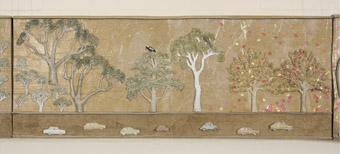
Elizabeth Paterson, Growing Home – the Street Trees of Canberra
photo Stuart Hay
Elizabeth Paterson, Growing Home – the Street Trees of Canberra
ARTIST ELIZABETH PATERSON WAS IN HER CAR ONE DAY WHEN SHE HEARD TRADITIONAL GREEK MUSIC ON THE RADIO. SHE REMEMBERS SITTING ALERT AND THINKING, WHAT IS IT ABOUT WHERE I LIVE THAT (LIKE THE GREEK MUSIC) IS SO DISTINCT, SO RECOGNISABLE, THAT THE THOUGHT ITSELF CARRIES THE EVOCATION OF HOME?
So was born her project, Growing Home: the street trees of Canberra, a work which documents the development of Canberra’s green spaces from the plans of horticulturalist Thomas Weston through to the 1970s, a span of some 60 years.
Displayed at the National Botanical Gardens Visitors’ Centre, the work comprises a 12-metre scroll which wraps around three walls of the gallery. A papier mache bas relief, the work’s structure is based on the Bayeux tapestry, and like the Bayeux, it travels in time through a distinct narrative of events.
The piece is filled with recognisable historical detail, such as landforms of the area and different species of trees and birds. Paterson wrestled with her subject over the long making period: “Canberra is controlled, quiet, empty, slightly boring. Parts of me wanted to find something more exciting, but the content itself kept drawing me back.”
The artist finds she is “bemused, surprised, pleased” by the result. “It works in spite of me.” Whereas in other cities, architecture carries the Grand Human Narrative, Canberra’s story remains its struggle to overcome landscape. After the miracle of transforming vast limestone plains with gelignite, experimental plantings and an army of men planting rootstock, we are still left with a Great Emptiness characteristic of the Paddock. The city is laid out incorporating paddocks within it. The King of the Paddock, she says, is the Gum tree, and “gum trees want to push people out.”
While the earlier parts of the scroll are full of the activities of digging, planting, period tractors towing and lifting, visible human presence thins as our eyes traverse panels from the “building years” towards the 60s and 70s. In the earlier years, some scruffy dogs walk themselves amongst the men, plantings and earthworks; in later decades, a sole dog-walker heads off past parked cars.
Paterson began as a theatre maker, training in the late 1970s at the VCA. Her earliest independent works, such as The Old Woman at the Window [1980], show a tendency to present tableaux within a frame, hinting at stories formed outside of it. A later street theatre piece, The Odd Jalopy [1996-98], revealed its concerns with the kinds of rich, unspoken narratives that could be imagined from glimpsed arguments and exchanges, reveries and vignettes of immigrants, enacted by the two performers as they trundled the tin-pot vehicle along its journey through various venues and events.
Similarly, the panels of Growing Home capture a series of enactments within memory spaces. The scroll becomes a (partial) autobiography of the town. Its simple materials, quotidian action and play with space also link the work to the concerns of the legendary Polish theatre director Tadeusz Kantor, with whom Paterson studied in the 1980s and whom she credits as turning her from theatre towards visual arts.
One of the scroll’s chief characteristics is its restraint. No single tree—native or non-native—is too heroic (what can truly conquer that limestone soil?). No individual towers over the landscape. (Apparently, Weston and Walter Burley Griffin argued as Weston proved Griffin’s planting fantasies would fail.) In one panel, a tiny bust of Weston comes head-to-head with a rabbit.
The brown paper tone holds the piece, reminding us of the fundamental aridity of the region. It is also an historical touchstone, reminiscent of the brown paper packages of earlier times.
Technical challenges included finding a way to “flatten” the papier mache (“it doesn’t like it”) and discovering latex moulding as a way to achieve both repetition of the tiny features (the leaves of the trees) and detail (individual differences in cars, workmen, birds, rabbits).
“My next step”, says Paterson, “is to find the spontaneous—to move more away from historical narrative.” Yet these kinds of elements are already suggested, in the decorative “cornices” of the work, the rhythmic explorations of line and defining of space across the piece, and in the aforementioned vignette of man versus rabbit. “I’m in a state of looking for ‘what next’? A time of self-examination. What is exciting to me now?”
Elizabeth Paterson, Growing Home: the street trees of Canberra, National Botanic Gardens, Canberra, April 3-June 29
RealTime issue #85 June-July 2008 pg. 54
© Zsuzsanna Soboslay; for permission to reproduce apply to realtime@realtimearts.net
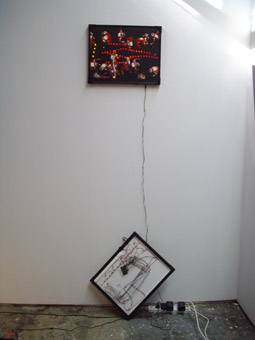
Scot Cotterell, Thanks For Having Us
courtesy the artist
Scot Cotterell, Thanks For Having Us
AN ECLECTIC MIXTURE OF ART OBJECTS, FOUND MATERIALS, A LIVING AREA AND AN ARTIST INHABIT HOBART’S 6A GALLERY FOR THE EXHIBITION THANKS FOR HAVING US. LOCAL ARTISTS TRISTAN STOWARDS AND SCOT COTTERELL PRODUCED WORK IN A JOINT SHOW THAT RESPONDED TO THE UNIQUELY SHAPED GALLERY SPACE. COTTERELL EXHIBITED AN ARRAY OF ARTWORKS WITH MATERIALS THAT RANGED FROM FOUND OBJECTS TO ARCHAIC VIDEO EQUIPMENT, RECONFIGURED ELECTRONICS AND PAINTED MASONITE. STOWARDS ON THE OTHER HAND TOOK THE OPPORTUNITY TO MOVE INTO THE GALLERY FOR THE DURATION OF THE EXHIBITION. THE HANDPAINTED TIMETABLE OUTSIDE THE GALLERY DOOR INVITED THE VIEWER TO EXPERIENCE “A DAY IN THE LIFE OF THE ARTIST TRISTAN STOWARDS.”
Situated in a brutally functional Besser brick building that used to house a petfood butcher’s shop, 6a Gallery is Hobart’s newest artist run-initiative. Far from the generic white cube, 6a is a relatively small, oddly shaped space, consisting of a tiny area at the entrance, a narrow hallway and a kitchenette with an unplumbed bathtub. This unconventional environment challenges artists to consider the site, and has inspired a number of diverse site-specific artworks. For Stowards, the kitchenette feature provided the perfect circumstances for his participatory artwork. Similarly the entrance to the gallery, with its roller doors and rough surrounds, complemented the aesthetics of Cotterell’s art.
Cotterell’s work sprawls across the gallery floor, a seemingly haphazard placement of objects. Powercords wind their way around a plastic-wrapped frame, dusty canvases are stacked against the wall facing away from the viewer, a large grid of ancient speakers emits distorted sound and tacky LED ‘paintings’ barely hang on the wall next to an insignificant looking bootleg copy of an ’N Sync CD. Assumedly in response to the unusual gallery space, Cotterell has shunned traditional forms of art presentation, preferring to place smaller objects on the floor or leaning against the wall so that the viewer has to bend down to engage with the works.
The artwork that initially attracts my attention is one of Cotterell’s faux ‘graffitied’ posts, which I recognise as a single part of a site-specific work in a recent outdoor sculpture trail. Out of context, the graffiti takes on a completely different meaning, emphasised by the upright post’s isolation in the forefront of the gallery. This re-presentation raises an interesting question—where do site-specific artworks go when the show is over?
I’m later informed that Cotterell’s intention is to display older exhibited work, such as the graffitied post, amongst newly produced work, in an attempt to challenge the ingrained convention of linear development in current art practice. However, the works are displayed without an artist statement, titles or dates; and for a viewer unfamiliar with Cotterell’s art practice, there is no distinguishing the old from the new. The average viewer’s only indication of the artist’s intention is the exhibition title—a rather humble “Thanks for having us.”
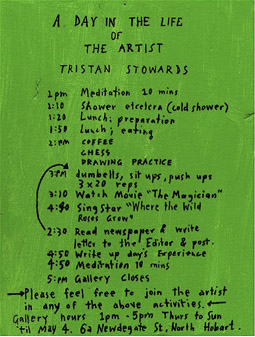
Tristan Stowards, Thanks For Having Us
courtesy the artist
Tristan Stowards, Thanks For Having Us
With Stowards’ artwork, the exhibition title takes on domestic connotations. Entering the artist’s temporary home, I’m surprised at the extent to which the gallery actually looks like a permanent dwelling, and I feel like an intruder in an incredibly personal space. A full bookshelf, television and bed/couch are squashed into the tiny room and the walls are crammed with Stowards’ collection of paintings, drawings and photographs.
The viewer is invited to join the artist in such diverse and often banal activities as writing letters to the editor, eating lunch and watching a movie. Stowards turns out to be a warm and enthusiastically welcoming host and I find myself returning to the gallery many times over the course of the exhibition. On my first visit, keen to avoid the “dumbell, sit ups, push ups” session, I strategically arrive in time for the 2pm “drawing practice”, after which I proudly watch as my still life, Jaffle Maker with Olive Oil Bottle against Kitchenette Tiles, is added to the growing number of drawings in the gallery hallway. My second visit is somewhat humiliating. I turn up for the 4.40pm “Singstar ‘Where the Wild Roses Grow’” and am classed a “wannabe” by the Playstation Game. Stowards’ daily timetable of tasks and play enjoyably mocks both the romantic ideal of the working artist and the dole bludger stereotype.
The creations of Stowards and Cotterell, although strikingly different in approach, offer engaging interpretations of artistic practice. Stowards achieves this by sharing his personal experience as an artist with the public in a participatory artwork, and Cotterell by his presentation of anonymous artworks which reject the contemporary art conventions of artistic progression and statements of intent. Yet, the main strength of Thanks for Having Us lies in the artists’ use of 6a, creating an entertaining exhibition that tests the function of the traditional gallery space.
Thanks For Having Us, artists Scot Cotterell, Tristan Stowards, 6a Gallery, Hobart, April 11-May 4.; 6a Newdegate Street, North Hobart is open Thursday-Sunday 1-5
RealTime issue #85 June-July 2008 pg. 54
© Lucy Hawthorne; for permission to reproduce apply to realtime@realtimearts.net
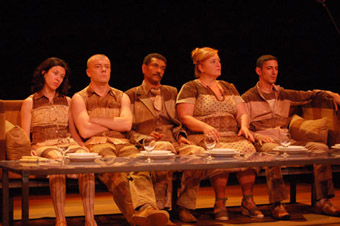
Fuck Darwin or How I Learned to Love Socialism, Montenegrin National Theatre
AS PERFORMANCE SPACE DIRECTOR FIONA WINNING POINTED OUT WHEN SHE WENT THERE IN 2006 AS A JUROR, THE CAIRO INTERNATIONAL FESTIVAL OF EXPERIMENTAL THEATRE IS STRUCTURED AS A COMPETITION. THERE ARE BEST ACTOR, ACTRESS, PERFORMANCE, ENSEMBLE, DIRECTOR AND SCENOGRAPHY CATEGORIES—A BIT LIKE THE OSCARS, AS WERE SOME OF THE DRESSES AND A SORT OF MINI-PAPARAZZI VERY ACTIVE AT THE FOOT OF THE STAGE AT BOTH THE OPENING AND CLOSING CEREMONIES.
CIFET attracts performances from about 70 countries, selected initially by various means in the countries of origin. Once in Egypt, some shows are then filtered through yet another selection process to be viewed and judged by the internationally composed jury.
I was invited to the festival in September 2007 as ‘Honouree’, and it was indeed a real honour to see so much work from Middle-Eastern countries, with a smattering of shows from Eastern Europe and from the USA and UK.
Farouk Husni, Minister of Culture and founder of the festival, has worked to create “a context of human openness and communication” and to “acknowledge change”, and by its very existence the event does so. However, aspects of the festival have been questioned in its 19th year, in the print and online press and the final speech from this year’s Jury Chair, Karen Fricker (UK). The openly contentious issues included the competitive nature of the event itself and, on several occasions, the lack of technical and other support for performers and performances, also drew attention. After his colleague’s mid-performance announcement that they were stopping their performance because of technological breakdowns, an actor from Bulgaria called on the festival to consider if it was worth holding it at all without what he saw as proper support, extending to those works selected for the Jury to view.
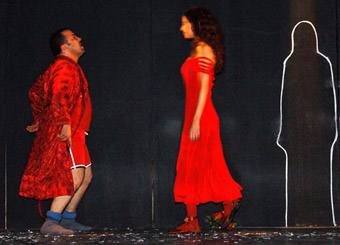
A Non-Identical Copy, Al Teatro
The place of technology in theatre was in fact the central issue at the symposium, two days of debate from writers and directors for and against the use of technology. It was surprising how many invocations there were to Jarry, Aristotle and the Futurists, sometimes on both sides of the argument. But it was a multimedia work from Syria (Show Cola) which won the Best Performance. I missed seeing it because of the complexities of negotiations with my driver, and the lack of theatre addresses in the program.
The emerging issue of gender politics was also a matter for much discussion within the Jury meetings, I gather, and certainly among audiences. Highly problematic and generalised in its stance, the generalisations of The Mask from Jordan polarised, even alienated, many in its audience with its emotive presentation of the oppression of women. But then there was a sassy, sexy and challenging group of young Egyptian women, all new to performance, who played to packed houses—mostly Arabic, of both sexes and many ages, laughing, sad and pensive in their response to very bold work.
It was an Egyptian-Montenegran work, Fuck Darwin!, Or How I Learned To Live With Socialism, from Cairo director Ahmed El Attar which seemed most closely related to forms of contemporary performance. It played with time and declared the presence of the performer as more than actor more overtly than any other work I saw at the festival. Also impressive was the stark Iraqi version of Macbeth that presented four characters in modern western civic and military dress in a series of monologues and dialogues inside a bare architectural set almost suggestive of the work of the Futurist painter, Carlo Carra. Macbeth’s dying speech was a city power broker’s lament that deepened into something much more about death.
A powerfully staged work from Tunisia, Al-Teatro’s A non-identical copy, comprising a doubled Mephistophelean figure and disjointed images of power, captivated me although I didn’t understand it at all. Shifting power plays in a state of war were also evident in an almost surreal work from Bahrain, Basic Colours, with images of strange shelters, hand to hand battles and an unforgettable man in white underwear trailing a string of tin cans as he walked, circling through the unending and shifting battles for power between the members of an all male cast.
Much of the work in the festival was performatively naïve, bound to the the centrality of narrative and authenticity, and assuming obscure references would be carried across by passionate intent. Some shows seemed simply too raw to be showing in such a robust setting—an exquisitely performed little mime/drama from Sri Lanka expressing the pain of the country's ongoing war, and a mysterious and messy but oddly haunting piece from Mauritius that incorporated expressive movement, Shakespeare, classic Greek drama, Hindu and stylised African figures and a bunch of op shop costumes and props.
Stark representations of the Egyptian legal system were presented in a small piece that moved between several tiny upstairs rooms in the faded grandeur of one of the Townhouse venues, very much outside the environs of the festival. In another Townhouse performance, the well-known actress Nora Amin presented a grieving monologue in recognition of the anniversary of a tragic 2005 theatre fire in which a number of prominent Cairo theatre practitioners died.
As its honorary president, Martha Coigney (USA) said in her presentation at the end of the event, the festival “is a celebration of experimental theatre in the world, a recognition of what is next.” It has certainly opened my eyes to just how much is involved to make theatre, and prompts the reiteration of Martha’s final call: “Instead of war, have a festival!”
Cairo International Festival of Experimental Theatre, Cairo, Sep 1-10,2007
RealTime issue #85 June-July 2008 pg. web
© Clare Grant; for permission to reproduce apply to realtime@realtimearts.net
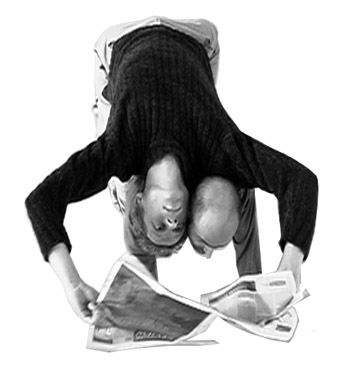
Fragmentation, Suzon Fuks
Competing for the financial and cultural boon of the ReelDance award are 10 Australian and New Zealand dance films. From the symbolically abstract to the psychologically narrative these works reveal a pleasing even surprising pulse of local creativity. One after another they roll out in an almost gruelling marathon where attention, perception and dispassion become acts of discipline.
Deserving of (but not winning) the award for best film was Suzon Fuks’ Fragmentation, managing to be both technically bold and humanly warm. James Cunningham and Rob Tannion read the morning newspaper: but they do it upside down and on top of each other, on the floor and up a wall, sometimes collaborative, sometimes combative, but always attuned, always nuanced. With gentle athleticism they morph into a body with two heads as the camera dives in and backs away, stroking flesh in close-up and cutting up images of habit. Even the screen dances as it changes shape, splitting into multiple images or moving slender longitudes of vision sequentially across a dark horizon. Gloriously, the soundtrack is composed of the sounds of newspapers crumpling and feet on a floor, thickening this six minute film with dimension, depth and place. Rendered without a manipulative musical score, Fragmentation is authentically idiosyncratic and situation specific as body and media meld.
My award for ‘most lushly cinematic’ goes to Cordelia Beresford’s The Shape of Water. Actually winning the 2008 ReelDance Festival award, it features the choreography of Narelle Benjamin and dancers from the Sydney Dance Company cast as liminal human/sea creatures moved, apparently, by oceanic momentum. But it descends into a hair flicking water dance with lots of exposed flesh, displaying the unbearably stylised motifs of neo-classicism and Ashtanga yoga. Not creatures at all, these are but dancers with pointed feet shifting into a variety of impressive asanas. True flow and ebb is achieved cinematically, in the rocking house, perched on the edge of the cliff, reminiscent of Bondi, making ground unstable, providing tension. Will it fall?
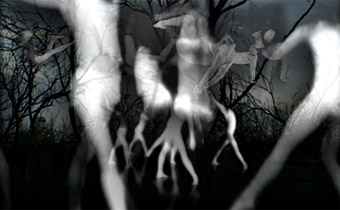
Pod, video still
Narelle Benjamin & Sam James
Pod, video still
Narelle Benjamin again teams with the Sydney Dance Company in Sam James’ Pod. Credits squirm and ripple, introducing a film where dancers emerge from and fold into a grey toned background, thick and dense like ancient humus. Mediated moments of emergence and disappearance make human and mossy worlds barely distinct. Bodies open and twist, almost primordial, almost amoeboid—if it wasn’t for those pesky pointed feet, again casting these bodies as those of anonymous dancerly dancers. Just once, inverted and relaxed feet sit atop swaying legs, made truly reed-like, conjuring the wind and dancer, relinquishing dancerliness, merging with nature. A soundtrack of strings and harp, supported by an electronic pulse, is a tad saccharin in a film yearning for sounds more globular and fleshy.
Sam James’ second submission, Quietly Collapsed, wins my ‘we’ve all been there’ award and confirms James’ eclectic talents. The camera pans, zooms and lingers over the backs of seated office workers: black and white characters only slightly tinged with colour. A blue computer screen pops up, as a particle of colour in a dull world, seemingly serene but masking the madness of deadlines. Rosie Dennis stands up to dance out this lurking madness amidst a soundscape that twitches, drills and speeds in eloquent and brain piercing constancy.
Award for ‘most cheerful’ goes to Morning Herd, directed by New Zealander Rick Harvie. Choreographer/dancer Ross McCormack is the farmer with an imaginary herd of cows, as he uses fences, gates, railings, grass and muddy earth as supports for choreography that is both stylised and quotidian. Cinematic space is intersected with posts and beams and fences that corral architectural vision in length and verticality. But it is the warmth of its colours: the greenness of green, and the brownness of brown I will remember.
‘Most poignant’ award goes to Shadow Play, featuring fine performances by Kirk Page and Alexandra Harrison. But it is the presence of Rininya Page (the late Russell Page’s daughter) that deepens the emotional intensity. The narrative of a troubled family borders on triteness but is saved by intense spurts of argumentative athleticism, a palette of golden light and the trace of a lost dancer.
Sue Healy’s Will Time Tell is taut and lovely (see our Dance Write feature). Soma Songs by Daniel Belton shrinks dancers into disembodiment in architectural symbolism and Reset by the same director was eight minutes too long. Sean O’Brien’s Dis-Oriental is quirkily funny, manically scored and edited, yet remains strangely symmetrical in its framing of dancer Yumi Umiumare, who is revealed and hidden in plays of light and darkness.
ReelDance Awards, ReelDance International Dance on Screen Festival, May 18, Performance Space, CarriageWorks, Sydney, May 11-18
Go to www.reeldance.org.au for the full list of awards.
RealTime issue #85 June-July 2008 pg. web
© Pauline Manley; for permission to reproduce apply to realtime@realtimearts.net
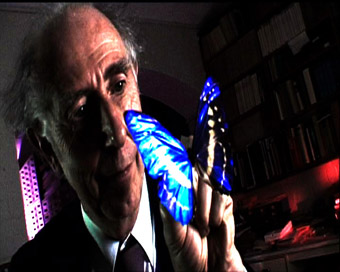
Butterfly Man, Samantha Rebillet
The opening night of the ReelDance International Dance on Screen Festival began with a parody lecture and short film demonstration by Double The Fist. We were told there were two elements to dance film—a. dance, and b. film—and shown examples. There was the experimental dance film, the camera-as-dancer film and the narrative dance film, where employer and employee negotiated the intricacies of a workplace agreement through dance. It was a warm welcome into the world of ReelDance.
Most of the films in this opening program were less overt in their use of dance than films in other festival sessions. The theme was everyday dance. Interestingly, this theme led the films to share another common element–dancing men. There was scarcely a woman on screen.
Alexei Dmitriev's Dubus (Russian, 4mins) created a montage of moving bodies from the black and white worlds of Casablanca, Citizen Kane and film musicals of the early 40s, edited to dance forwards and backwards to a swing soundtrack. The rhythm of the editing—catching singers, orchestras and dancers swinging between action, never quite moving forward—gave the film's performers the appearance of a surging almost maniacal group enthusiasm for the pursuits of late night nightclub music and dancing.
Butterfly Man (Australia, 6mins) by Samantha Rebillet was restrained in its introduction of dance. This documentary style film, a portrait of butterfly collector Don Herbison-Evans, opens with still shots of the interior of his home, with live butterflies abounding on his bedspread and ones that had been ‘sent to heaven’ in the fridge and freezer. Herbison-Evans talks about the process of collecting as the film follows him to the Macleay Museum, where his collection is kept, and back home again. Here he tells us that he himself was like a butterfly, having blossomed at fifty when he discovered his love of dance. At this point, the camera reveals picture rails laden with trophies. We see Herbison-Evans resplendent in a pink satin shirt, practising his dance moves in the lounge room. He is clearly a man who could be labelled eccentric, and it would have been possible for the film to patronise or make fun of his passions. However, the filmmaker deftly steps around this, as exemplified in the closing scene where Herbison-Evans, elegant and dignified, waltzes with his partner, There is real pleasure in watching him guide her across the floor.
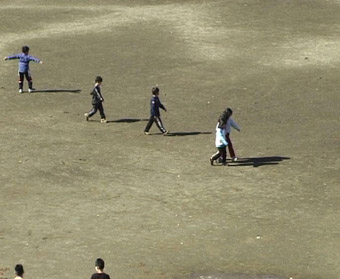
Dancing Boy, Marjan Laaper
There are more eccentric men, touched by the call of Elvis, in Brenin/King (director Margaret Constantas, UK, 14mins). Three men make their way through the heather of the Welsh countryside, rock and roll moves jerking out of their bodies, to join a male choir singing Elvis songs in Welsh, atop a craggy hill. There they make a slow motion dance joining together classic ‘King’ poses while answering questions from the choir posed to these 'reincarnations' of Elvis. The ritual over, the men make their way back down the hill. Brenin/King is a beautiful looking film, with the strange actions of the men juxtaposed against the expansive Welsh landscape. But after the authenticity of Butterfly Man, the clear composition of this fiction, made me feel the filmmakers were a little too aware of the quirk factor in their subjects.
An uneasy feeling lurks beneath the simple surface of Night Practice (UK/Sweden, 3mins) by Susanna Wallin. One teenage boy runs a lap around an oval, while a group of other boys practice breakdance moves in the centre, on the grass and on a large high jump mat. The field is made artificially day bright by huge floodlights, flaring the pale blue of the running track. In the distance, there is the sound of traffic and sirens. The running boy looks to the centre group as he runs, and a smaller boy pedals his bike across the field. The final scene has the smaller boy lying across the running track, laughing and feeding lollies into his mouth, interrupting the graceful run of the older boy.
The program also had two films from Norway, Waltz (Zoe Christiansen,10mins) and Shall We Dance? (Martin Lund, 9mins), which made different uses of social dance, and Oru Divasum (Australia, 5mins) in which director Paul Blackman performs fluid hip hop moves against a background of bemused Indians in Chennai.
The film that stayed with me longest, however, was the very simple Dancing Boy by Marjan Laaper (Netherlands, 2mins), which is exactly as the program described it: “a boy spinning across a field, the screen and out of frame.” There is such joy in his moving and his having a body that can spin, that the 'dance' is at once everyday and quite extraordinary.
Global Shorts #01: This Dancing Life, May 15, ReelDance International Dance on Screen Festival, Sydney, May 11-18
RealTime issue #85 June-July 2008 pg. web
© Jane McKernan; for permission to reproduce apply to realtime@realtimearts.net
I have fond memories of early Sunday morning recoveries in front of a friend’s TV eating Vegemite-smeared Saos while watching music videos on Rage, a ritual formative in my knowledge of pop, indie, rock and dance music. Bands old and new had images to their music slickly produced for them: surreal, narrative driven, overblown and minimal. More often than not, the band was placed artfully in incongruous locations. Music video comfortably defied all rules of visual coherency. Until seeing ReelDance's Global Shorts: Music: Dance: Image program, I hadn't realised that these suburban, post-party moments of my teens were early encounters with diverse examples of screen dance. Sixteen clips were screened, originating from Norway, UK and Canada with most made in Germany and Australia.
Not so unusually, the bands appear on screen to sing and play while a wacky world is unleashed. Dancing or exaggerated everyday movement is foregrounded in the subject matter, the structure of the clip, built into the editing or humorously executed by band members. In I’d rather dance with you (Kings of Convenience, dir Geir Homes, Norway, 4mins) the lead—dressed in a nerdy three stripe, tight red tracksuit—commandeers a group of young ballerinas, seeking vengeance on his ballet mistress by teaching them his simple, daggy choreography. The tune is poppy and delicately sung. His twisting moves and cross-over kicks are light and joyous, delivered with ease. This devious corruption of form, softened by natural lighting and slow paced action, informs the editing language. He is a red figure juxtaposed against the ivory white room and beige suit of the piano player, singing and smiling dulcetly in several close-ups. Parallel framing allows the dance to unfold alongside the narrative, culminating in a concert hall performance where applauding parents watch a ballet rendered in the celebrated, subversive manner of Little Miss Sunshine. A favoured shot is a pan from left to right of tiny white stockinged legs, collared by jagged tulle, knees knocking together.
The cleverly constructed I have seen you dancing better than this (Luigi Archetti and Bo Wiget, Germany, 4mins) is an extreme example of music not corresponding to visual image. Two middle aged-men in black with low slung electric guitars strum heavy metal style—head forward, face shrouded by hair, knees bent, pelvis hovering over toes. The sequence is continuous, with the edit simply shifting focus between mid and close range. Filmed in black and white, the frame never changes content or configuration. The layered electronic sound is punctuated by a single organ note, deliberately not meeting the action. Perceptually the sense of the music played by the men is not lost but heightened by the images of a dance moving to a tune we can't hear. At no time do the two strands intersect, they only share duration. The movement is seen and the music is 'listened to' because of this juncture alone.
The opening scene of Australian band Mess Hall’s clip Pulse (dir Justin Kerzel, Australia, 4mins) is at dusk; two small residential structures fill the background; the band can be seen through a window. Two children skip with the hypnotic beat, constant and consistent. The skipping is adroitly captured in a single stable shot, changing when a band member leaves the room. The camera pans to the left revealing more skippers, two girls playing a clapping game and a coastline with a tanker on the horizon; its light further beating out the pulse. The evenly controlled pace is suddenly broken as the guitarist runs past changing the shot from stable frame to frenetic Dogme style, an INXS like chorus kicking in. The camera chases the man. The motion intensifies, creating ambiguous shapes. The man draws away from the camera toward the distant city lights. The camera pans 180 degrees to indicate the reason for his fleeing: a raging fire. Pulse is superbly choreographed in a unified sequence, the music wedded entirely to the action.
As a consequence of defining dance film narrowly, I was initially suspicious of music video’s inclusion in the ReelDance Festival. But in this context, music video appears to be the most inviting of all screen forms for dancing to ably burst out beyond the pedestrian gesture without seeming contrived. Perhaps some dance film could benefit from a tighter relationship between music, dance and image.
Global Shorts #02: The Art of Moving, May 16, ReelDance International Dance on Screen Festival, Performance Space, CarriageWorks, Sydney, May 11-18
RealTime issue #85 June-July 2008 pg. web
© Jodie McNeilly; for permission to reproduce apply to realtime@realtimearts.net
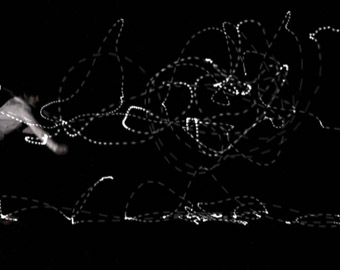
Traces, Chirstinn Whyte
In Trace (Chirstinn Whyte, UK) a dancer’s passage leaves an indentation, dot to dot, as the young woman enters right of frame, her movement lucid, crisp in its execution, and moves perpetually backwards, dehumanised in rewound slow motion. The camera is still, the stifled sound mimics her quiet movements. Superimposed dotted lines mark the air her limbs have conquered–remnants of her movement–while the right side of the screen floods with notated movement as the dancer continues her journey.
Global Shorts #03: The Art of Moving was a collection of 15 short films crammed into 70 minutes, ranging from a crowd of teenagers seeking the camera’s gaze (You made me love you, director Miranda Pennell, UK, 4mins) to the unforgettable image of a has-been ballerina with humorously exaggerated curves (Que Me Ilamen Heroina, dir Stephen Lynch, Spain, 10mins). The program presented an array of unique filmic explorations with interplay between body, gesture, choreography, objects, superimposed graphics and various film techniques. Passagem (Celina Portella, Elisa Pessoa, Brazil, 6mins) and Narroweyes (Sirah Foighel Brutmann, Aaph Polonsky, Israel, 7mins) use a single shot to document clusters of moving bodies. In Nicole Seiler's films, Hulle Fulle (Switzerland, 2mins) and Devant-Avant (2mins), faint projections of underwear clad figures appear momentarily on a washing line in one and an infinite space reveals a ghostly duo, through intervals of dispersed steam. in the other.
Autumn leaves falling, an ominous dust storm, flocking birds. “The Gathering” (dir The good guys, Netherlands, 7 mins) is a mesmerising recording of birds in their thousands, hovering above the city skyline, unconscious performers, but proud. Perfectly choreographed birds fluff their feathers in flight as they duck and weave. The camera is still, adjusting in and out of focus, amateurish yet poetic as if filmed from an onlooker’s window sill. Shifting from close up to long, wide shots, our gaze is relentlessly challenged as this natural phenomenon is transformed into an accumulating image of the unknown. The birds lose all their familiarity as this magical formation elongates, folds, pulsates and coils in a perpetual whirlwind over the still, afternoon sky. Soothing, meditative acoustic guitar mimics the graceful and playful nature of the birds’ ephemeral interactions. Eventually the wafting, looming yet serenely feminine mass disperses—the tip of the tail, a lone flyer, briskly passes the screen; the audience sighs, dazzled by its innocence.
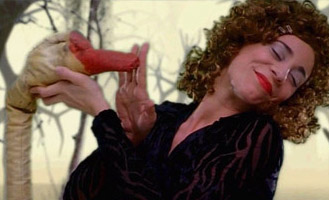
Que Me Ilamen Heroina, Stephen Lynch
The female figure is celebrated, transformed and industrialised in Marriage (dir Amy Caron, USA, 1min)), El Escape (Marilen Iglesias-Breuker, argentina, 7mins) and Tingel Tangel (Kathryn Ferguson, UK, 2mins). All three films present the female as a powerful if dehumanised being whether through the supernatural levitation of a housewife’s legs, the mechanical movement and acrobatic distortion of chrome corseted doll-like women, or the playful puppetry of a wooden dancing machine from a Weimar Berlin cabaret show.
In contrast, Mark Adam's Gun (Canada, 6mins) is a parody of ultra-masculine Hollywood action films, taking the gestures of the gunman and presenting them satirically, larger-than-life and embellished with an intensely clichéd score and comical facial expressions. In a suspenseful fusion of blockbuster cinema and art film with James Bond-like camera effects, done-to-death action-hero images and speeding vehicles, three men taunt one another with weapons. The camera dances, low angle to high, until the gun is aimed at us and we are shot into black. Our eyes adjust to the sudden blindness, white words—“Keep moving fool”—stain our retinas.
Jan Verbeek's Osmotic (Germany/South Korea, 3mins) captures the intricate, unaware ‘dance’ of a parking attendant through the overlapping of images and split screens. Inearthia, by Compagnie CoLateral and Maren Sandmann (Switzerland, 2mins), creates the optical illusion of the earth being spun by a single man by deploying the clever use of weight and momentum, camera trickery and a captivating body. The program ended teasingly with Torbjorn Skarild’s Alt I Alt/All in All (Norway, 5mins) in which a rhythmic score develops from the repeated bounce of a diving board to the momentous ricochet as the diver's feet spring. There's enormous anticipation for the splash, for the breaking of the surface of a placid pool. It never occurs.
Global Shorts #03: The Art of Moving, May 17, ReelDance International Dance on Screen Festival, Performance Space, CarriageWorks, Sydney, May 11-18
RealTime issue #85 June-July 2008 pg. web
© Ashley Syne; for permission to reproduce apply to realtime@realtimearts.net
ART, IN ITS MULTITUDINOUS FORMS, IS AN INHERITED FEATURE OF HUMAN ACTIVITY, GENETICALLY (THE PROPENSITY FOR AND THE NEED TO MAKE ART) AND CULTURALLY (THE FORMS WE INVENT, SHARE, PASS ON AND INNOVATIVELY MUTATE). ART IS DEEPLY TIED TO OUR WELLBEING AND IS INTEGRAL TO HUMAN ECOLOGY: ARTS’ DIVERSE FORMS ALLOW US TO CHOOSE THE WAYS IN WHICH WE CAN MAKE OR ENJOY ART, WHAT ROLES WE CAN PLAY IN AND THROUGH IT, WHAT COMMUNITIES WE CAN BELONG TO. THE SUSTAINABILITY OF ART PRACTICES IS NOT SIMPLY AN ECONOMIC ISSUE, IT’S ONE OF HUMAN ECOLOGY.
Sustainability is a word familiar to us from both ecology and business, and these days its parallel uses are being drawn closer and closer together. Business has become very conscious of the economic advantages of ecological awareness, and there are companies and corporations merging profit-making and environmental responsibility well ahead of more cautious governments, but without the prospect of profit they might be less enthusiastic. Sustainability in the arts refers to the capacity to survive: art as a tradition worth maintaining and growing, art as individuals, groups and companies functioning as businesses, of a kind, and art as an ecology—a complex of local and global networks of learning, exchange and influence. Art is a complicated totality; we need to see it as such, and address its wellbeing as an ecosystem.
sustaining the sector
In A Sustainable Arts Sector: What will it take?, authors Cathy Hunt and Phyllida Shaw have created a brief guide to how a sustainable arts organisation should function; they report on and compare UK and Australian arts councils’ strategies for building sustainability, including through remedial programs; and they detail changes in funding outside of governments (a gradual but palpable shift from sponsorship to philanthropy). It’s a timely essay, practical in spirit but always mindful that the prevalent business or managerial model for arts funding and management has its limits when it comes to encouraging innovation and supporting the long-term development of artists and their visions, not least in the small to medium sector where much of the future of art is generated.
The strength of the essay is that although still in the arts managerial mode it addresses the ongoing need for government funding as part of arts sustainability and that it sees the art sector as a totality, making some sense of the occasional use of the word ‘ecology.’ While there’s little room for artform detail in an essay, the emphasis on commonality focuses shared dilemmas and suggests the potential of a united vision. This is at its strongest in the essay’s conclusion where the authors delineate the beneficial impact for the arts of the UK National Lottery which “provided the opportunity for a significant change, including a wholesale review of the challenge of sustainability.” The authors conclude their essay “with an invitation to the new Australian Government to initiate a discussion about the establishment of an endowment to create a new funding source for the arts in Australia—a Future Fund for the Arts, financed by the Australian Government in partnership with the state governments and the private sector, through a special tax incentive linked to corporate and individual investment.”
Set up as a foundation this fund would provide support for “artistic and organisational risk and innovation; projects and programmes lasting seven years or more; longitudinal reseach into the long-term impact of the arts.” Hunt and Shaw think that with “state, federal and local government funding focused on the short to medium term and a Future Fund addressing a long term agenda, the sector’s sustainability is more likely assured.”
the 2020 summit
Invited members of the arts community, including Hunt, went to the 2020 Summit with this vision, or something similar, in mind. ACTU President Sharan Burrow called for a future fund for the entertainment industry including investment in multimedia and internet production and what looked like an inspired idea, a “cultural schoolbag” to give Australian school children cheap access to museums, film and the visual and performing arts.
The provisional document that came out of “Towards a Creative Australia” section of the 2020 Summit opens with the ambition “to double cultural output by 2020. To achieve this there is a need to implement policies that will produce a sustainable creative sector and support artists, build educational capacity, integrate Indigenous and settler perspectives and recognise the centrality of the arts and creativity to the whole economy.”
It’s an odd ambition, to “double cultural output.” A better goal surely would have been to make the arts in Australia sustainable instead of setting a meaningless number as your target. It’s like saying to government we’ll double our effort if you give us the money to make us sustainable without saying what sustainability means. It looks like a productivity model rather than one addressing capacity and effectiveness. If artists and organisations struggle to sustain themselves now, how will they fare with doubling their output, however much their ranks increase over the next decade. Richard Letts, in his response to Hunt and Shaw in Plaform Papers 16, reports that “the recent census shows a quite striking decline from 2001 to 2006 in the number of people declaring their main occupation to be [an artist] in the main art forms” by some 20% on average, this after “an upward trend of at least four decades duration.” Whatever the reason for this, and Letts suggests several, all of them disturbing, it’s enough to make you wonder about the viability of arts training courses and the sustainability of careers in the arts. Let’s hope the doubling notion just goes away.
The strong call at the summit for increased art in schools (practitioners-in-residence “via a national mentoring plan”, mandated arts courses, creativity summer schools, in-service teacher arts training) was promptly made real in part with the 2008 Australian Government Budget allocating “$5.2 million over four years to the Australia Council to improve access to quality artistic experiences for students in primary and secondary schools and tertiary institutions.” There will be “grants of up to $20,000 for individual professional artists, and $100,000 for arts organisations, to develop and deliver arts learning experiences through in?school residencies.”
Again sustainability is ignored. While a national artists-in-schools scheme is an admirable goal and a requisite part of any arts education program, how does it mesh with artist availability, training and capacity? How many students will it actually reach compared with, say, the ACTU’s “cultural schoolbag”, where kids might see art where it usually happens? Just how seriously has any of this been thought through? Again it’s superficially attractive—more work opportunities for artists and companies who can accommodate the load or see it as a career option or something on the side aiding survival.
One of the high priorities singled out by the Creative Australia team at the summit was for “A National Endowment Fund for the Arts”, a title rich in irony in these censorious times, recalling the diminution of the US’s National Endowment for the Arts (NEA) triggered by conservative responses to the funding of provocative American artists like Robert Mapplethorpe and Karen Finlay. Naming aside, it’s a pity that a future fund wasn’t the priority above all others, it’s the only one that could pull all the others together and make sustainability its focus.
the budget
While the 2008 Budget realised some of the 2020 Summit’s Creative Australia arts-in-education dreams long before the government has to announce what it will do with the recommendations, the overall picture is of yet another Australian Government failing to address the sustainability of the arts. Once again programs look like initiative spending, attractive in the short-term but vague in the long. Yes, it’s great to have more emerging artists, and better supported, terrific to have artists in schools, and wonderful to have “creative communities.” But are there the networks, the administrators, producers and the artists (not just the numbers, but their appropriacy and capacity) to realise these schemes, to make them endure?
“A Creative Australia”, the young and emerging artist program, allocates “$6.6m for young and emerging artists and young audiences.” (Perhaps the reference here, otherwise unexplained, to “young audiences” suggests the possibility of the “cultural schoolbag?” idea). On the surface this looks admirable, nurturing the next generation of artists, but for what kind of future? The current generation is not well sustained.
Creative Australia says the budget paper, “will provide support for: performing arts companies to offset the income that would otherwise be earned from presenting better known or more commercial works; projects that support young and emerging artists in developing professional skills, expertise and professional networking; and projects that engage young artists and audiences, particularly in demonstrating best practice in the areas of youth arts and new technologies.”
$10 million over four years will be invested, says the budget announcement, in “a Creative Communities program to improve opportunities for Australians to participate in arts and cultural activities in the places where they live. Funding will be allocated by the Australia Council for high quality participatory arts programs that enhance community wellbeing, encourage innovation and assist communities to find creative solutions to the issues they face.” On the other hand the budget cut of $4.3m from Regional Arts Australia over four years is expected to reduce touring (likewise the National Gallery of Australia has accommodated cuts to its funding by halving its touring exhibitions from ten to five).
It has to be said that while the initiatives for emerging artists, arts-in-education and creative communities look focused and impressive at first glance, the amounts of money are modest when spread over four years. And the Australia Council has to manage new programs while dealing with staff cuts amounting to $2m.
a word about business
Just as Hunt and Shaw temper the art-as-business model (addressing the vocabulary that positions artists variously as supplicants and business people) so did Justin Macdonnell, returning from a successful stint as artistic director of the Carnival Center for the Performing Arts in Miami, Florida and now Executive Director of ANZArts in Australia, a think tank for the creative industries. He reminded his Currency House audience that “the arts are innovative, that is their nature”, but “the chances are you’re stuck with a legal structure, funding model or work practices that belong in another age.”
Macdonnell fears that, “In a world of financial uncertainty, investment is not going to the creation of artists who make new work but to sustain those who interpret old work.” He asks how can arts companies innovate with “unweildy institutions of part-time volunteer boards and full-time burnt-out management…with little left over to devote to such things?” He points out that for “about 50 years in the English speaking world, the arts…have been urged, even compelled by their funding masters to emulate the business model”, not least by having a board made up of managers, accountants and lawyers “to guide and restrain the wilful artist—as though it were the arts that regularly had the corporate crashes, bankruptcies and shady dealings. That push has almost eliminated arts boards’ ability to make informed judgments about the very arts they govern.” It will be interesting to hear what alternative models Macdonnell has in mind. In the meantime, read his paper, Investing in the Future: the Arts and Innovation at www.currencyhouse.org.au; it gives some indication of what Macdonnell achieved in Miami.
sustaining & building arts ecology
The Make it New? papers and consequent programs emerging from the Australia Council’s Theatre Board and Manager John Baylis have addressed the challenges of building networks and freeing artists of various burdens by creating producer and management models that support innovation, thus initiating an ecological approach to sustainability for the small to medium performing arts sector.
Although controversial, the Board’s funding of producers seeks to reinforce and develop the growing networks for touring, resourcing, presenting and commissioning that have sprung up in recent years, providing artists with producers who know the terrain and the niches here and overseas where works will fit and prosper (we’ll have more on this with reports from Australia and the UK in RealTime 86).
The Theatre Board’s recently announced MAPS (management and production services) scheme aims “to bring more independent theatre and dance works to the stage” by “provid[ing] independent Australian theatre and dance artists with subsidised production, management, touring and marketing support.” One of the key points in Make it New? and one in line with Macdonnell’s thinking, was that the ‘one model fits all’ approach to management and governance for small groups was cumbersome, inefficient and un-creative. Australia Council for the Arts chief executive Kathy Keele said in a press release that MAPS, a partnership between the Australia Council and arts funding agencies in Queensland, Victoria and Western Australia, “provides a flexible support structure that frees these artists from administration so they can focus on what they do best—creating work. Through MAPS they will be able to tap into the skills, networks and infrastructure normally only available to artists working for established arts organisations.” MAPS will be delivered by Performing Lines in Western Australia, Strut & Fret in Victoria and a partnership between Metro Arts and Brisbane Powerhouse in Queensland.
In New South Wales, Arts NSW and the Australia Council have announced the Regional Performing Arts Centre Partnerships scheme. Part of the Local Stages initiative, it “aims to develop hot-houses for the performing arts in regional communities…Based at the Illawarra Performing Arts Centre, Bathurst Memorial Entertainment Centre and Griffith Regional Theatre, the partnerships will support residencies, workshops, performance nights and funding for local creative projects. Each performing arts centre (PAC) receives $100,000 per annum towards the costs of a dedicated producer/animateur position and a production budget for that person to support local professional theatre-making.” Like MAPS the aim is to reduce administrative pressure on artists, make better use of existing facilities and improve local government investment, growing networks and developing creative hubs, thus improving sustainability for innovative artists. Which artists get the support and how will be a key issue and, as Hunt and Shaw remind us, what might make all of this work is a willingness to adopt a long-term view after more than a decade of politicians leaning towards short-term initiative funding.
despoliation & rights
While 2020 Summit ideas were being debated and promulgated and the Budget for the arts largely, if mysteriously, praised, artists were otherwise on the receiving end of a good thrashing. The Age headed its report on Summit 2020 participants’ message to Rudd about the Bill Henson censorship fiasco, “Arts elite attacks Rudd over images”, recalling the 1996 election campaign Liberal Party assault on artists as ‘an elite.’ On other fronts, Michael Duffy in the Sydney Morning Herald announced “the disappearance of significant Australian artists, in any art form”, declaring that “the dead hand of subsidy” was stifling artistic greatness. A report to NSW Arts Minister Frank Sartor recommended the closing down of the states regional writers centres, suggesting that “[b]etter outcomes may be achieved by addressing the needs of regional writers on-line”! Sydney Writers Week banned a student magazine covering the event. An exhibition to mark the 60th anniversary of what Palestinians call al Nakba (the catastrophe) at Leichhardt Public Library (Hebron and Leichhardt are sister cities) was visited by New South Wales counter-terrorism taskforce sedition unit the night before it was to open. The library then shut down the exhibition. And it goes on.
It seems that we need more than an arts future fund to make Australian art sustainable. David Throsby argued for an Australian Cultural Policy in Platform Paper 7. And beyond that we need an Australian Charter of Rights. The 2008 federal budget includes $2.28m over two years to consult on and implement various human rights legislations and treaties. Hopefully, the anti-sedition laws that John Howard’s government strengthened in 2005 (see Jonathan Biggins, Platform Paper 10, Satire or Sedition: the threat to national security) will be removed but, more importantly, freedom of expression given its proper place in our constitution. You can’t sustain the arts with money and practical policies if it’s vulnerable willy nilly to censorship and ministerial interference. Or make it sustainable only in terms of what its functional value is. As Richard Letts reminds us, our first responsibilty is to art for art’s sake—”it’s much closer to the core than art for the sake of business or the economy.”
Cathy Hunt and Phyllida Shaw, A Sustainable Arts Sector: What will it take, Plaftorm Papers, No 15, Jan 2008, Currency House, Sydney
RealTime issue #85 June-July 2008 pg. 12, 42
© Keith Gallasch; for permission to reproduce apply to realtime@realtimearts.net
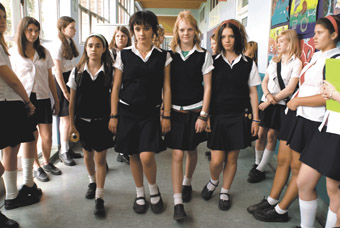
Hey Hey It’s Esther Blueburger
THE ONLY JEWISH GIRL AT AN UPTIGHT PRIVATE CHRISTIAN GIRLS SCHOOL, 13-YEAR-OLD ESTHER BLUEBURGER (DANIELLE CANTANZARITI) SERIOUSLY STRUGGLES TO FIT IN. ONE OF THE FEW LINES SHE SPEAKS TO ANYONE AT SCHOOL PRETTY MUCH SUMS IT UP, “I KNOW YOU HATE ME, BUT MY MUM THINKS YOU’RE COMING TO MY BAT MITZVAH.”
Writer-director Cathy Randall has described Hey Hey It’s Esther Blueburger as a female twist on the Holden Caulfield tradition, made in response to her own experiences of growing up without access to female outsider heroes.
Esther finds her own way to fit in by breaking out. This happens in part because she meets Sunni (Keisha Castle-Hughes) who plays the drums, goes to the local public school, has a cool, relaxed mum (Toni Collette) and does not judge Esther for being different.
Esther also breaks out successfully because she has a seriously camp sensibility. The opening sequence of the film gives an almost aerial view of the school grounds as uniformed schoolgirls choreographically embrace their lunch. It’s a satirical homage to Busby Berkeley that makes eating school lunch look like synchronised swimming or perhaps more like a propaganda film for the Hitler youth. In fact, this high angled view of the playground is Esther’s. It’s what the film’s production designer Nell Hanson calls “Esther-Vision.” It is not quite reality but it reflects the way Esther sees things with her impressively quirky imagination.
Esther-Vision is, in many ways, what drives this film. It comes on with varying degrees of intensity throughout. When Esther is peer-pressured into giving a guy a blowjob in a back alley on a night out, instead of the act we see her dancing in garish bright colours atop a makeshift stage. When Esther clandestinely attends Sunni’s public school as a Swedish exchange student, it’s a ruse that produces a strange piece of performance poetry for her new class. She is suddenly compelled to repeat it upon return to her private school and is chased off the edge of the stage by a school prefect for her efforts.
This is not a traditional teenage comedy but it draws on many major elements of that genre. What makes the film work is its ability to use the over-the-top camp satire of Esther-Vision for sharply observed social critique. At one moment during Esther’s bat mitzvah, all the mothers and grandmothers in attendance seem to chase her around the family garden recommending hairdressers and putting down her rather geeky appearance. Such a moment might border on cheap and clichéd satire but it works as critique, partly because we see all of this from Esther’s point of view.
This comic critique extends perhaps most unflinchingly to the dysfunction within Esther’s nuclear family. Her twin brother Jacob (Christian Byers) travels on his own hilarious journey of teenage identity crisis from obsessive genius to expelled, fantastical axe wielding menace, to becoming Jewish Orthodox.
Esther’s mother, Grace Blueburger (Essie Davis) also goes on an emotional journey as a result of Esther’s escapades. She never moves too far away, however, from the inhibitions arising from her obsession with living up to her middle-class cultural expectations. Esther’s father, Osmond Blueburger (Russel Dykstra) maintains a stronger sense of empathy with his children throughout the film but remains somewhat in the background.
Thankfully, the film does not resolve the family’s dysfunctional relationships in the final dinner scene. Esther’s parents still fail to really acknowledge her but have come to some self-awareness and a sense of humour about the way they all misunderstand each other.
It has taken more than six years to realise this gorgeous project. In 2002, Randall won a scholarship to attend the Los Angeles Film School’s Feature Development Programme. In 2003 she received an AWGIE award nomination for best un-produced screenplay. It was then picked up as the first feature produced by Miriam Stein with Tama Films, the company Stein set up in 2003. The South Australian Film Corporation provided incentives for the feature to shoot in South Australia.
Hey Hey It’s Esther Blueburger was one of two Australian films selected for the Generation section of the 2008 Berlinale, along with The Black Balloon. Since 1978, the Berlin Film Festival has had a special section dedicated to films that look at the world from the viewpoint of children and youth (a children’s section has been introduced to the Sydney Film Festival in recent years). It is exciting to see Randall’s first feature film being celebrated at home and overseas. Let’s hope it continues to reach Esthers everywhere and to foster the camp imagination in all of us.
Hey Hey It’s Esther Blueburger, writer, director Cathy Randall, producer Miriam Stein, director of photography Anna Howard, production designer Nell Hanson, editor Dany Cooper, original music Guy Gross, sound designer Liam Egan, Tama Films, distribution Disney; www.estherblueburger.com
RealTime issue #85 June-July 2008 pg. 22
© Megan Carrigy; for permission to reproduce apply to realtime@realtimearts.net

Beirut Diaries
THE SYDNEY ARAB FILM FESTIVAL, MANAGED BY INFORMATION AND CULTURAL EXCHANGE (ICE), EXISTS IN ORDER TO CREATE A CRITICAL SPACE WHERE THE COMPLEXITY AND DIVERSITY OF ARAB EXPERIENCE CAN BE EMBRACED. OBVIOUSLY, THIS IS A VERY IMPORTANT UNDERTAKING WHEN THE MAINSTREAM MEDIA IN AUSTRALIA RELIES UPON AN ARRAY OF PREDOMINANTLY NEGATIVE AND MISLEADING STEREOTYPES. THE FESTIVAL PROVIDES THE OPPORTUNITY TO ENJOY ALTERNATIVE REPRESENTATIONS OF ARAB CULTURE, WITH AN EXPLICIT EMPHASIS ON PERSONAL STORYTELLING AND SELF-REPRESENTATION.
Viewers came out in force for the 2008 festival, making it clear that there is not only a political need for these alternative critical spaces in Australia, but a deep hunger for them. Films serious and whimsical, unashamedly romantic and stridently political were all embraced by sell-out crowds.
The history of the festival itself reveals that this vision has taken shape over a number of years. The first Sydney Arab Film Festival was held in April 2001 over three days at The Roxy Parramatta in association with Casula Powerhouse’s East of Somewhere exhibition. In 2004, ICE hosted A Big Night of Arab Shorts, showcasing local short films by Arab-Australian filmmakers. In 2005, a major event was staged with 48 local and internationally produced films screened across Campbelltown, Parramatta and Bankstown. After a break in 2006, the 2007 festival was held over four consecutive Sundays at Parramatta Riverside Theatres with three international guests and additional forums presented at other venues along with TONE, an exhibition presented by Casula Powerhouse.
The 2008 festival has taken a much more streamlined shape, running over four days in one venue—a strategy that appears to have paid off in terms of attendance and profile.
The festival opened with a sold out Australian premiere of Caramel, a luscious Lebanese and French co-production directed by Nadine Labaki, who also stars in the film. The film traces the complex stories of four friends whose daily lives intersect at a Beirut beauty salon. Recently released in Lebanon and France, Caramel has become the most successful Lebanese film ever to be released in both countries. Nadine Labaki has been named by Variety magazine as Middle East Filmmaker of The Year. Hopscotch will release Caramel in Australia in mid-2008.
Three other feature films screened at the festival. Seventh Heaven, a new feature from Egypt was introduced by festival guest, director Saad Hendawy. His film explores the complex relationship between Bakr, a celebrated but conflicted Sufi dancer, and Hanan, an independent and wealthy single woman who works as a high-class prostitute, previously uncharted territory for the Egyptian cinema.
On an entirely different note, the Tunisian film TV is Coming, directed by Moncef Dhouib, offered audiences a whacky and biting satirical comedy. In the sleepy Tunisian town of el-Malaga, news of the arrival of a German television production sends the town’s cultural committee into a frenzy of cultural production and intense self-censorship.
The festival’s closing night introduced Underexposure, billed as the first Iraqi feature film since the beginning of the war on Iraq and the first uncensored feature film from that country in over a decade. Directed by Oday Rasheed, Underexposure weaves together stories of fictional characters with real footage of the landscape of war-torn Iraq. This strategy worked to highlight the difficulty for filmmakers of even thinking through how to represent what has happened to their country and the difficulty of negotiating the huge volume of televisual imagery that has already come to stand in for their experience.
The closing night also saw the launch of ICE’s Changing Lives project which includes a website that facilitates digital storytelling by young Arab-Australians. The first group of these beautifully crafted digital stories by young Iraqi-Australian women can be found at www.changinglives.com.au.
Two major forums, one on Palestine the other on Lebanon, were presented at the festival, both chaired by Dr Paula Abood. The festival marked the 60th anniversary of “al Nakba”, the Catastrophe of 1948 for the Palestinian people when their land was taken from them. In the first part of the substantial double session—Palestine Films & Forum—Maher Maghrabi, a writer and a journalist for The Age, powerfully worked the metaphor of the wall for the audience in order to introduce a documentary, The Iron Wall. Directed by Mohammed Alatar, it potently illustrated the political significance of the Israeli settlements and outposts that have been built in Palestinian territories and provided a detailed picture of how the ongoing building of the wall is fracturing Palestinian land and people. The film featured interviews with prominent Israeli and Palestinian peace activists and political analysts. The second part of this forum revealed a very different approach to the Palestinian situation in the fictional short film Before the Wind Blows, by Samer Najari. Three young people—a World War II Japanese pilot, a young Lebanese woman during the civil war of the 1980s, and a young Palestinian man from a refugee camp in the Occupied Territories—are each having their portrait taken as they prepare to depart on their respective suicide operations.
The second forum focused on women’s contributions to the Palestinian struggle. It was introduced by Randa Abdel-Fattah, lawyer, writer and author of the acclaimed novel Does My Head Look Big in This? The short film Make a Wish, directed by Cherien Dabis, carefully crafted the graceful story of Miriam, a young Palestinian girl determined to muster together enough money to secretly buy a cake to celebrate the birthday of her missing father. The documentary Women in Struggle, directed by Buthina Canaan Khoury, introduced four Palestinian women who were former political prisoners in Israeli jails and who spoke about their resistance, their experiences in prison as well as their current daily life under occupation.
The equally packed session on Lebanon focused on films made by Australian residents who traveled there, documenting the aftermath of Israel’s 2006 attack. In the short documentary A Wishful Smile, Mirna Nassar explored the experiences of two residents of Qana in southern Lebanon devastated by the bombing of their village. Lebanon Burning, directed by academic and journalist Peter Manning and produced by businessman Mohsen Safieddin, reported on the targeting of civilian factories and infrastructure by Israel. Manning has written Us and Them: A Journalist’s Investigation of Media, Muslims, and the Middle East, examining many of the issues with which the Sydney Arab Film Festival is in dialogue. A major medical supply factory run by Mohsen Safieddin’s family was targeted by the Israeli offensive and obliterated in the attack. It was disappointing to learn at the forum that Lebanon Burning, a story that so far has not been told by the Australian media, has been rejected by both SBS and ABC.
In another documentary session, Beirut Diaries: Truth, Lies and Videos followed the experiences of a young woman who takes part in a downtown Beirut tent camp that served as the physical and emotional heart of the protest movement after the February 2005 assassination of Lebanese Prime Minister Rafik Hariri. This feature length documentary, directed by Mai Masri, provided powerful access to the everyday political activism on the streets of Beirut, revealing a wide range of divisions and alliances among young people concerned about the future of their nation.
Professor Ghassan Hage had launched the festival with a beautiful, strong speech that emphasised the importance of the event as a space where positive identity formation and dialogue can take place, perhaps in a way similar to the hopes of the tent camp in Beirut Diaries. The power of film, in particular, as a medium that can, as Hage describes it, help us pull ourselves together, was certainly exemplified by the success of this year’s festival.
It’s exciting to see the Sydney Arab Film Festival truly start to come into its own in 2008 as the result of years of grassroots community activism. The vision, the hard work, the hopes and the dreams of the organising committee are clearly beginning to pay off.
2008 Sydney Arab Film Festival, festival directors Fadia Abboud, Mouna Zaylah, organising committee Firas Naji, Phillip George, Alissar Gazal, Mohamed Duar, Paula Abood, Khaled Sabsabi, Fatima Mawas; Information and Cultural Exchange, Parramatta Riverside Theatres, April 10-13
RealTime issue #85 June-July 2008 pg. 21
© Megan Carrigy; for permission to reproduce apply to realtime@realtimearts.net
![En La Ciudad de Sylvia [In the City of Sylvia]](https://www.realtime.org.au/wp-content/uploads/art/19/1942_city_of_sylvia.jpg)
En La Ciudad de Sylvia [In the City of Sylvia]
JOSÉ LUIS GUERIN’S IN THE CITY OF SYLVIA, WHICH TOURED IN AUSTRALIA RECENTLY AS PART OF THE LA MIRADA SPANISH FILM SERIES AND IS PROGRAMMED FOR THE 2008 SYDNEY FILM FESTIVAL, EMERGED FROM LAST YEAR’S CANNES FILM FESTIVAL AS ONE OF THE MOST IMPORTANT FILMS OF THE YEAR. IT IS ONE OF A GROWING NUMBER OF DRAMATICALLY MINIMALIST WORKS—THINK OF THE FILMS OF HOU HSIAO-HSIEN AND TSAI MING-LIANG FOR STARTERS—WHICH PARES DOWN ITS NARRATIVE TO ALLOW THE CONSTRUCTION AND MANIPULATION OF CINEMATIC SPACE TO COME FORWARD.
The story, such as it is, is a vaguely autobiographical one about a young man who briefly met the eponymous Sylvia in a Strasbourg bar six years previously. (In real life, Guerin returned to Strasbourg 22 years after the initial encounter.) He has now returned to the city in the hope of finding her, or at least seeing where his obsessive return to their meeting will lead him. He sits at a café, follows a woman whom he mistakenly believes to be Sylvia, and revisits the bar where he encounters another woman. End of story.
Guerin, who introduced the film when it screened at the Hong Kong Film Festival recently, said that he wanted to take narrative and character psychology out of the film, so that the audience would be forced to concentrate on gesture and the processes of watching and listening.
The nameless protagonist, played by Xavier Lafitte, spends most of the film simply watching women. He is equipped with lightened contact lenses so that he appears to be a pair of shining eyeballs. The erotic power of looking is clearly important here. Women repeatedly stare down from advertising posters, returning his look, and challenging that of the camera. When the man has a sexual encounter with the woman he meets at the bar, all we see are the two looking at each other. We don’t see them having sex, or perhaps we do in this exchange of looks.
It is, of course, one of the banal commonplaces of bad film theory that movies are all about voyeurism, particularly male voyeurism. Guerin is clearly interested in this proposition but also in going beyond it to explore the ways in which looking is a vital part of our spatial orientation to the world and to the cinema. The opening sequence, in which the central figure sits at an outdoor café looking and sketching, becomes a rich forest of glances performing a multitude of functions.
The astonishing thing about the scene is the way it sustains and varies itself while little or nothing of narrative interest occurs. The man barely speaks, and only shifts position once, though in the minimalist context of the film, be assured that this is a moment of some excitement! He mainly looks from place to place, inviting us to look, really look, at the images.
My emphasis thus far on looking risks devaluing the importance of the soundtrack, which provides a primary means of interpreting the denseness of the physical environment. As the man follows the woman he thinks might be Sylvia through the labyrinthine alleyways of the city in the middle section of the film, we start to concentrate on the sound of trams, street musicians, bottles rolling on the pavement—the everyday transformed.
These are all sounds which would normally be relegated to the peripheries of our attention but as Guerin puts it: “When the figure disappears, the surroundings appear.” The lack of dialogue and non-diegetic music focuses attention on the soundscape. At one moment I was shocked to hear non-diegetic music fade up, until a car drives through the foreground, and with a sudden shock of recognition, you see that its radio is the source of the music. Guerin uses devices such as this explicitly to draw our attention to the interaction of picture and sound.
A drunken old woman sits on the footpath and kicks away a bottle. Some time later we return to the same framing, and though the old woman is now absent, we hear someone off-screen kicking over a bottle. There is a thrill of recognition here. Passersby in the street start to appear as choreographed performers and recurrent characters, such as an African man selling odds and ends, take on the significance of a chorus.
The effect is something like Jacques Tati’s masterpiece Playtime, in which the world is made strange and wonderful by the play of form. It is a vision of a world transformed not merely by male desire, but rather by looking and listening closely—by cinema.
When I suggested the comparison with Tati to Guerin (who also teaches at the Pompeu Fabra University in Spain), he accepted it enthusiastically. He is that rare type of filmmaker—certainly if we compare him to most of his Australian counterparts—who speaks knowledgably about a wide range of films. There are rich echoes of Hitchcock’s Vertigo here too, not to mention Chris Marker’s Sans Soleil.
The film is often screened (though unfortunately not in Australia) with its companion piece/predecessor, Some Photos in Sylvia’s City, which began as a video journal kept by Guerin. The resultant piece is composed entirely of still images in the style of Marker’s famous La Jetée. This totally silent, black and white film is something like the sketches which the protagonist scribbles in the first sequence of Sylvia. It is at once a blueprint for the latter film and in a kind of dialectical opposition with it.
While In the City of Sylvia remains resolutely within the minimal nature of its story, some Photos in Sylvia’s City uses intertitles to establish a didactic comparison with the motif of the male artist’s obsession with women in the European literary canon from Dante to Petrarch to Goethe. In Guerin’s latter film, the down-scaled version of this literary precedent becomes the graffiti “je t’aime Laure” (the subject of Petrarch’s passion) repeatedly spray-painted on the walls of Strasbourg.
Guerin’s triumph is the transformation of urban space into an eroticised aesthetic space through a rich variety of artistic practices, including writing and filmmaking, but in both instances, a world transformed and animated by desire.
En La Ciudad de Sylvia [In the City of Sylvia], director, writer José Luis Guerin, 84 mins, 2007; 32nd Hong Kong International Film Festival, March 17-April 6, www.hkiff.org.hk/eng/; screening in the Sydney Film Festival June 8.
RealTime issue #85 June-July 2008 pg. 20
© Mike Walsh; for permission to reproduce apply to realtime@realtimearts.net
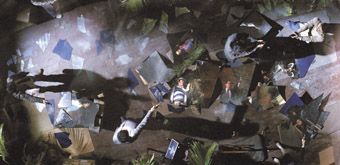
The Mad Detective
THE HONG KONG FILM INDUSTRY, LIKE THE CITY ITSELF, CHANGES CONVULSIVELY. GONE ARE THE DAYS OF A VIBRANT COMMERCIAL INDUSTRY BASED ON EXUBERANT GENRE FILMS. IF THE LOCAL PANORAMA SECTION AT THE RECENT HONG KONG INTERNATIONAL FILM FESTIVAL IS ANYTHING TO GO BY, THE POSSIBILITIES HAVE POLARISED INTO BIG BUDGET HACK-AND-SLASH HISTORICAL EPICS CO-PRODUCED ON THE MAINLAND OR SMALL CITY-SPECIFIC YOUTH FILMS MADE CHEAPLY BY FILM SCHOOL GRADUATES.
It seems that the last man standing in the commercial cinema is Johnnie To Kei-fung. He had three films screening in and around this year’s festival and, at the time of writing, several attempts are underway to bring these films (and the man himself) to Australian cinemas. To is a prolific figure, having directed over 50 films in the past 25 years and producing many others through his company Milky Way Image. He has won numerous awards with films such as The Mission, Running Out of Time, the two recent Election films and Exiled.
After years of moving between styles in order to gain international recognition as an auteur, To seems to have found a mature vision with his recent films, The Mad Detective and Sparrow. He is an unashamedly commercial director working in crime stories and occasionally comedies, but one who wants to push genre filmmaking to the limits of abstraction. It is no accident that his films have become staples at the Cannes, Berlin and Venice film festivals over the past couple of years.
The Mad Detective marks To’s reconciliation with scenarist Wai Ka-fai with whom he collaborated on the equally bizarre Running on Karma in 2003. Wai has an established thematic interest in visionary protagonists who are powerless to change their destiny. Long-time To star Lau Ching-wan plays Bun, a cop whose curse is his ability to see people who aren’t there.
The self is an essentially porous construction in this film. By placing himself in the physical position of others, Bun can identify himself completely with them and thereby recreate crimes. Hence, his unorthodox methods of detection include being zipped into a large carry bag and thrown downstairs. He also looks within people and sees the deeply divided components of their psyches, including a killer with seven different personalities. As one who is ever more conscious of the fat, middle-aged accountant and the Japanese schoolgirl simultaneously struggling for ascendancy inside him, it’s difficult not to take the detective’s madness seriously.
The film involves the continual adjustment and refinement of its abstract premises for the audience. There is no early overarching explanation of the detective’s powers or his hallucinatory plight. Each scene plays out like the solution to a piece of puzzle which, in turn, sets up a further puzzle. Our understanding of the narrative situation unfolds incrementally. In one scene, Bun intervenes to stop a young girl shoplifting and then argues with his wife who protests his interference. It turns out that his wife is upset because the girl wasn’t really there. It’s only some time later, however, that we realise that the wife wasn’t there either.
While this sounds rather cryptic, the film was a commercial success in Hong Kong because it rewards the audience for figuring out the puzzle as the film progresses. It’s a film which makes you feel smarter at the end than when you went into the cinema.
Sparrow, which premiered at the Berlin Film Festival earlier this year, is a long-term To project, shot over three years between other projects. It is much lighter in tone than most of To’s recent crime films, dealing with a group of small-time pickpockets who are recruited by a mysterious temptress to win her freedom from a threatening sugar daddy.
The story proceeds through a series of set pieces in which the object is to imply everything while telling the audience as little as possible. The film shimmers along with a minimum of dialogue. The female protagonist’s sexual allure is established in the way she takes a cigarette from the mouth of one of the heroes, takes a drag leaving lipstick on it, and then wordlessly returns it to his lips.
Glorious spatial play abounds unencumbered by dialogue. The gang pursues the woman into a tiny elevator, only to find they are jammed into the space with two workmen carrying a huge fish tank. All the threat and the tension in the scene has to be spoken with looks, just as the space has to be broken up and reassembled through montage.
This push towards a purely formal organisation of narrative finds its crescendo in the final encounter featuring black umbrellas, driving rain and the swirling abstraction of figures pirouetting in the dark. It is one of the most deliciously choreographed and cut sequences in contemporary cinema.
The lightness of tone comes from the way To foregrounds the aspect of play in genre narrative, and so it comes as no surprise that he organised Triangle, the third of his films shown at the Hong Kong festival. The challenge here was that Tsui Hark should script and direct the first third of a film, deliver it to Ringo Lam who would make the middle, and then pass it on To who would provide the end. In the spirit of Lars von Trier’s The Five Obstructions, Triangle explores the idea that art-making is a playful process in which you constantly set yourself challenges which you then try to overcome.
The story echoes or allegorises the challenge of this collaboration as three buddies try to pull off a heist, while trying not to betray each other in the process. The result is surprisingly coherent despite Tsui’s characteristic disregard for narrative clarity, and the marriage of To’s more elegant and elegiac sensibility with the smash and grab cynicism of his colleagues. Where Lam has the treacherous female character apparently fatally wounded, To miraculously (and gracefully) resurrects her and reconciles her with her husband. The discontinuity works as a kind of wink to the audience, highlighting and celebrating the arbitrary nature of the game of artistic form.
Johnnie To Kei-fung, The Mad Detective, Sparrow, Triangle [with directors Tsui Hark and Ringo Lam], 32nd Hong Kong International Film Festival, March 17-April 6,
www.hkiff.org.hk/eng/
RealTime issue #85 June-July 2008 pg. 19
© Mike Walsh; for permission to reproduce apply to realtime@realtimearts.net
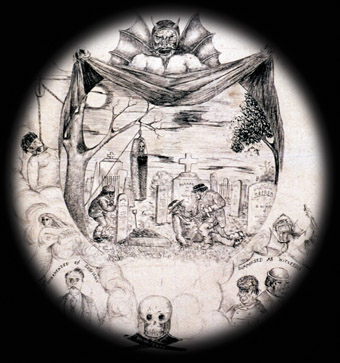
Bernard Lloyd, Homo Tasmanicus, image courtesy of WL Crowther Library, State Library of Tasmania
THAT THERE IS A NOTION OF TASMANIAN GOTHIC IS A LONG ACCEPTED ONE; A DEFINITION OF WHAT IT MIGHT CONSIST OF IS QUITE ANOTHER MATTER. I HAVE MY OWN VERSION, OF COURSE, AND IT MAY WELL BE QUITE DIFFERENT FROM THE INTERPRETATIONS PRESENTED TO AN ENTHUSIASTIC GROUP OF LOCAL FILM WATCHERS IN THE PEACOCK THEATRE, ITSELF A ROOM THAT ECHOES WITH AN OLD UGLINESS. THIS COMFORTABLE VENUE IS LOCATED ALMOST PRECISELY IN THE AREA WHERE WHALES WERE CARVED INTO MORE MANAGEABLE CHUNKS WHEN THE TOURIST PRECINCT OF SALAMANCA WAS ONCE A THRIVING DOCKLANDS. TYPICAL TASMANIA REALLY: AWFUL YARNS AND FACTS ABOUND ALL THROUGH THE PLACE, FROM MINOR DETAILS TO DEEPER HORRORS OF GENOCIDE AND EXTINCTION. THERE ARE A LOT OF WAYS TO GET THE CREEPS ON THIS COLD ISLAND.
The event I was attending was the screening of the results of a pilot guerilla filmmaking program run by the energetic Rachel Lucas and facilitated by Wide Angle Tasmania, an organisation that lives up to its name, presenting programs like this one, teaching more advanced, focused technical skills and screening local filmic endeavour.
Guerilla filmmaking is, like Tasmanian Gothic, another term open to varying interpretation, but it was easy to see what it meant here—get a camera and get going. The films were shoestring budget efforts, made to a tight schedule that left little time for contemplation or frippery. The emphasis on demystifying process and empowering these newer filmmakers to tell their stories and make screen-ready narratives yielded varying results, but one has to start somewhere, and this program was about getting people out of the blocks. I must admit to liking this kind of approach a lot and it echoes the old punk adage: this is a guitar, these are three chords, now form a band.
Rachael Lewis’ awfully tense footage of a chicken attempting to cross a road seemed to be a gag but then got quite dreadful as the possibility of seeing something die on screen was dangled. The film was called Les Roadkill and we’d already been treated to loving close-ups of car-damaged native animals by the time the chook appeared.
Watching Vivien Mason’s Two Heads Are Better Than One I was prepared to dismiss a discussion of the old two-headed Tasmanian myth as just too daft, but this documentary style film did its research well, finding an explanation for the myth—a lack of iodine in local soils had resulted in a plague of goitre and consequent neck scars—before presenting a chap who had made a decent living out of selling two-headed images on postcards. Another documentary, Tracie Walsh’s Slaughter at Pittwater, led us into the uglier aspects of Tasmania’s history, discussing an Indigenous massacre, Aboriginal resistance and a subsequent legal cover up.
The jewel in the crown of this screening was Homo Tasmanicus by Bernard Lloyd, a terrific research effort into the true tale of a gruesome tussle by factions of doctors for the possession of the body of one the last of the Tasmanian Aboriginal people, William Lanny. The narrative is constructed from extensive quotations from letters of one Doctor Crowther, who so coveted the scientific prize that he was oblivious to human dignity. This ugly tale, filled with midnight digging, body snatching and dissection yielded a feeling of hideous, immoral murk. The awful narrative was well supported by a smart decision to use extant historical imagery, all made to resemble the projections of a magic lantern, that ancient flame powered device that predated film itself. This was the Gothic moment of the evening, the screen mostly black, allowing us to peer voyeur like into our hideous past. Satisfyingly nasty.
Wide Angle Tasmania, Summer Screen Safari: Tasmanian Gothic, Screening and Discussion; Peacock Theatre, Salamanca Arts Centre, March 12; www.wideangle.org.au
RealTime issue #85 June-July 2008 pg. 18
© Andrew Harper; for permission to reproduce apply to realtime@realtimearts.net
CORNEL OZIES’ BOLLYWOOD DREAMING STARTS OUT LIKE PURE BOLLYWOOD—AN ATTRACTIVE YOUNG WOMAN DANCING ELEGANTLY AND FLUENTLY IN TRADITIONAL INDIAN DRESS TO A HEAVY, PULSING BEAT ON SAND BEFORE A WIDE ROCKY OUTCROP. CUT TO A YOUNG GIRL IN PLAITS AND SHORTS SITTING ON THE TOP OF A SKATE BOARD RAMP, TELLING US IN VOICEOVER: “I’M DIFFERENT FROM OTHER GIRLS IN BROOME ‘CAUSE I SKATE, I DO BOXING, KICK BOXING AND LIKE I’M THE ONLY PERSON IN BROOME IN LOVE WITH BOLLYWOOD…IT’S PRACTICALLY MY WORLD.”
Bollywood Dreaming (8 mins) is a thoroughly confident short documentary about an engaging, ambitious girl, Jedda Rae Hill, daughter of an African-American father and an Aboriginal mother from Broome. When not addressing herself to camera about her dreams—to be a skate board hero, a WAAPA student, a Hollywood actress, a Hindi speaker and Bollywood star—she and her mother bicker gently about the risks that boxing and skateboarding threaten to a youthful complexion. In between we see Jedda skateboarding, shot mostly below the knee, emphasising the speed and her pleasure in it, and pulling back for the odd fall. An extended Bollywood episode confirms how much she’s learned from watching the films over and over.
Bollywood Dreaming ends on a slightly sad note. For all her ambition and potent sense of self, Jedda muses, “I doubt they’ll be hiring any Aboriginal African-Americans. But it’s a dream.” This short film is perfectly constructed and intimately realised, director Cornel Ozies doubtless benefiting from the considerable experience of the film’s writer and director’s mentor, Mitch Torres, and the expressive camera work of David Tindale.
Two films deal with the Dreaming. Karla (writer-director Karrie Anne Keating, 7 mins), the story of how fire came to the Nyungars of the Pinjarra region, uses a mixture of traditional dance, story-telling around a camp fire and paintings, some of which are enlivened by simple animation. It’s Kelton Pell’s telling that is the film’s great strength: first we hear him, later we see him in close-up, then in the glow of the fire and finally engaging his young audience. Rob Bygott’s cinematography works the play of light and dark adroitly and Kimberley West’s editing maintains the film’s momentum as it shifts between formats. In Who Paintin’ Wandjina (8 mins), three senior Aboriginal women from the Kimberley region learn of a young graffiti artist who is covering Perth with images of Wnadjina, the spirit who came to earth in the Dreaming to give the people their law. Writer-director Taryne Laffer cleverly juxtaposes the voice of the artist (he remains anonymous) with the three onscreen women speaking in turn about the damage they feel the graffiti will do to their culture. It generates some sympathy for both sides of the argument even though the promise of resolution seems unlikely.
There’s no doubt that the graffiti artist’s work is inventive, often subtly placed and rich in colour. He originally thought he was doing the Aboriginal people a favour by spreading the image. But, as the women say, “Where is the spirit, where is the land, where is the story?” And the rich colourings offend because traditionally Wandjini are painted only in black, yellow, red and white. A “watering down” of the image’s power and meaning is feared, especially since, as one of the women explains, her people have no intellectual copyright in the image. Mark Parish’s cinematography alternates between the relative stillness of the women and rapid flow of graffiti images (editors Kimberly West, Rob Bygott), emphasising their viral spread.
Writer-director Mandy Corunna’s Wrong Way (7 mins) is straightforward documentary storytelling about teenagers who fall in love not knowing that they’re cousins (a result of the way families had been separated). Her mother forces the lovers apart but soon they elope, baby in arms, heading by bush track 87km to New Norcia but are deterred by pursuers. Eventually they find another town to live in and raise 12 children, but the girl’s mother always fears some kind of payback. The film is narrated onscreen by a descendant and reinforced with old photographs and simple re-enactments. Most affecting is the story of the journey told by the young wife, recorded in her old age in 1999.
Your’e Not Playing That! (4.30 mins) is as obvious as its title. A little boy in an AFL football-mad WA household would prefer to play rugby, much to his father’s horror, not least because he’s named his son Alex after his footballer hero Alex Jesaulenko. In a brief reverie, the boy imagines himself as a rugby superman knocking down an opponent (his father as another super hero) on his way to a touchdown. If the tone is comic, the father’s anger is nonetheless palpable. But the boy’s mother is sympathetic. Cut to a professional rugby player in a dressing room, snapping awake from this childhood recollection and about to play before his parents for the first time. The family await the start of the match, full of anticipation, except for dad watching football on the mobile. Mum sets him right. The end. Writer Kelli-Cross’ film is feelgood fun, given a little dark oomph by Trevor Jamieson as dad.
Bollywood Dreaming is clearly the best film in this edition of Deadly Yarns, not only because it’s subtly and expressively crafted, but because it focuses on a distinctive subject—a young Aboriginal woman indentifying with male sport and Indian film in her search for a place in the world. It’s about the options for making a life, a hybrid life, drawing on a distant culture, and no stranger than the Indigenous appropriation of country music and hip hop. Who Paintin’ this Wandjina is also a strong film, especially after several viewings. It uses the beauty of art—original, spiritual Indigenous art and its dextrous graffiti copies—and the deftness of its filming to explore the contentious and emotionally disturbing subject of cultural ownership. These films look like promising career beginnings. Collectively they confirm the ways in which Australian Aboriginal people live hybrid lives, and have hybrid dreams while their Dreaming dreams on.
–
Deadly Yarns 3, Indigenous Short Films for ABC TV’s Message Sticks; developed and produced with the assistance of Screen West, Lottery West, ABC TV and FTI [Film & Television Institute WA], 2007
RealTime issue #85 June-July 2008
© Keith Gallasch; for permission to reproduce apply to realtime@realtimearts.net
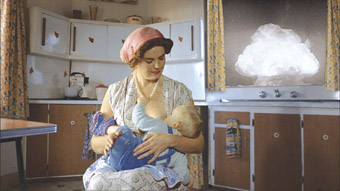
Janet Merewether, Maverick Mother
IN JANET MEREWETHER’S MEMORABLY IDIOSYNCRATIC AND HIGHLY INVENTIVE JABE BABE [BEST DOCUMENTARY, AFI AND IF AWARDS 2005, RT68, P18], THE SCREEN IMAGES OSCILLATE BETWEEN DOCUMENTATION OF THE SUBJECT, A YOUNG WOMAN SUFFERING THE LIFE-THREATENING MARFAN SYNDROME, AND RICHLY STAGED, WITTY PROJECTIONS OF HER FANTASY SELVES. IN MAVERICK MOTHER THE FILMMAKER HAS NOW TURNED HER CAMERA ON HERSELF USING A SIMILAR FORMULA, IF MORE COMPLEXLY AND EVEN MORE REVEALINGLY.
The film’s three-way dynamic comprises informal footage showing Merewether going about her life, meeting with family and friends as she resolves to have a child at 39 years of age and then grapples with the demanding experience. A second strand conjures often comic theatrical visions of herself, again beautifully staged; while the third, where she confronts the camera, or points it into a mirror she is facing, deepens the autobiographical richness of the film with intimate moments of self doubt, confusion, pleasure, fear and grief.
Shifting between these three perspectives, Merewether tells her story chronologically, from the time she decides to act on her feelings and have a child, to just how she does it (she’s not in a relationship), to telling her tolerant mother and disapproving father, to living through the pregnancy and a long and painful birthing, to becoming a proud mother, but one anxious about something missing. It’s the accumulation of anxiety, leavened by the comic theatrical asides and a home movie-ish lightness, that gives the film its emotional strength. From the beginning it’s clear that Merewether is not eager to be a single mother, but she can’t find a man to share parenting. So the solo mother option appears to be the only one. Sex with a bisexual friend yields no result (except his lover smashing a piano), the sperm bank option involves a six to nine month waiting list and, anyway, the description of the donors seems limited to hair, skin colour and occupation. And it feels humiliating for the filmmaker to be labelled as “socially infertile.” Merewether reflects on the irony of the sperm shortage given how men “splash their sperm around” (we watch it shoot onto and dribble down plush red velvet furnishings accompanied by male groaning), but notes the drop in donor numbers since offspring can legally trace their male parent. And then, chance plays its hand—Merewether’s pregnancy is the result of a one night stand at a Nine Inch Nails concert. Suddenly the implications and likely consequences of single motherhood loom large.
Despite a very supportive household and network of friends, Merewether suffers the absence of intimate sharing during pregnancy and acutely in early motherhood. She appreciates how society now tolerates single mothers in ways impossible in her mother’s generation, but she has to live with her father’s blunt espousal of those older values (along with belittling comments about Merewether being a weirdo artist and mothers as managers of ‘minutiae’). She tries to establish contact with the father of her child, hoping for a key male in her son’s life, but the man (a good dancer, she says, and into extreme sports) responds to neither letters nor phone calls, only visiting well after the birth. He’s as reticent and as non-committal as the tactfully blurred image we see of him when he finally appears.
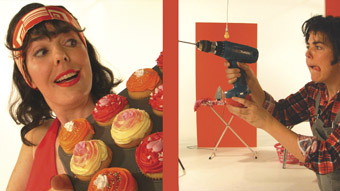
Janet Merewether, Maverick Mother
What appears to strengthen Merewether is her beautiful child, her mother’s acceptance, her brothers promising to take some responsibility for the boy, and hearing American writer Peggy Drexler on radio praising single mothers as mavericks “who make up the rules as they go along.” We viewers need strength too, sharing with Merewether numerous frustrations, the intimacy of a naked transforming body, a lot of birthing blood and baby shit, and tears as the filmmaker weeps into camera shortly after her baby has suffered a dangerous choking episode.
Stress and fear in Maverick Mother are, however, often made light of in the staged scenes, most of them brief if meticulously crafted episodes. Some play on cliches—baby floating on drifting pink cloud, baby in a cabbage patch, baby carried by stork, caveman bludgeoning a potential partner with his club, spinsters at spinning wheels. Merewether is frequently costumed herself—as a doll “left on the shelf”, as a blonde-wigged, cigarette puffing bad mum in sexy leopard print outfit in an apartment in disarray, or a young mother in the 50s about to be deprived of her illegitimate child. In the opening credits she is elaborately dressed and coiffed in baroque mode, large mock breasts bared, squirting milk, as she plays both actress and director while apt period music plays.
Drexler’s notion of solo, maverick mothers potentially reducing global violence yields other images: Merewether as a peasant suckling her child, the World War I dead seen in black and white through an open door behind her; as a 50s mother, an A-bomb plume filling the window; and as a 21st century career woman mother, the twin towers of September 11 smouldering in the near distance. Getting used to the idea that she will have to play mother and father, she reflects on what her father taught her—how to renovate—and we see her alternating between cake-baking housewife and butch home handyman. There’s a wry sense of joy in these transformations, of anything being possible. Merewether begins her film saying she felt like she’d been living on the sidelines of life; at its end she declares, “I am now inside the experience of living.”
Finally, we watch mother and child, “just the two of us”, at the beach in black and white, small frame footage, iterating the home movie idiom of Merewether’s film and the ties it suggests between past and present, and the very big differences. We hear her say, “I have juggled directing this film and directing my new life.” And we applaud her successful balancing act. Baroque is the right word for this film, its neat chronological structure, its tri-partite framing and witty fantasy-making and, as with the best Baroque music, the emotional power unleashed by careful, ostensibly casual crafting by writer-director, cinematographers, composer, editor and production and post production designers collaborating seamlessly.
in memoriam: jabe babe
It is with great sadness we report that Jabe Babe, the wonderful subject of Janet Merewether’s documentary Jabe Babe, died of heart failure, a complication from Marfan Syndrome, aged 34 on April 6. Merewether’s film is a fine tribute to her. Eds.
Maverick Mother, writer, director, producer Janet Merewether, director of photography Justine Kerrigan, pregnancy & birth cinematography Jackie Farkas, video camera Maverick Mother, writer, director, producer Janet Merewether, production & costume designer Melinda Doring, editor?Jan St Vincent Welch, post production designer Tim Ritcher, sound designer Liam Egan, composer Felicity Fox, Produced by Screen Culture Pty Ltd. 52 minutes. www.maverickmother.net. Premiere screening: SBS TV, Feb 1. DVD sales www.marcom.com.au
RealTime issue #85 June-July 2008 pg. 17
© Keith Gallasch; for permission to reproduce apply to realtime@realtimearts.net
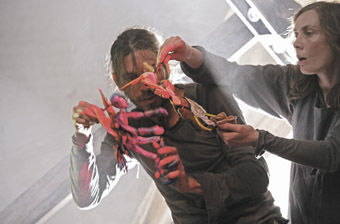
Black Hole Theatre, Coop
photo Jeff Busby
Black Hole Theatre, Coop
THE 2008 UNIMA INTERNATIONAL PUPPETRY FESTIVAL WAS DRIPPING WITH HISTORICISM, ITS BROCHURE PRINTED TO RESEMBLE A YELLOWING, WELL-THUMBED DOCUMENT, WHILE WOODEN MECHANICAL STRUCTURES (ROMEO E JULIA’S MARIONETTES, CLATTERING TOYS IN THE MECHANICS ALIVE EXHIBITION) FEATURED IN OTHER PUBLICITY. MANY SHOWS HARKED BACK TO ROMANTIC OR EXPRESSIONIST MODES, WHILE MARIONETTES AS PRECURSORS OF CYBERNETICISM WERE CONSPICUOUSLY ABSENT. THE BEST OF THESE WORKS OVERTLY ENGAGED WITH HISTORICAL DISTANCE, WHILE OTHERS ASSUMED THAT 19TH CENTURY IDEAS TRANSLATE TO NEW CONTEXTS.
South African visual artist and theatre-maker William Kentridge’s Woyzeck On The Highveld exemplified this historical and formal ambivalence. His plastic works and films are deeply historicist. Their dark tones (Kentridge works in black and white charcoals), exaggerated physiognomies and focus on (usually male) individual protagonists faced with hostile, modern environments likens his aesthetic to European Expressionism à la Schiele, Nolde, Kirchner, Murnau etc. This is heightened by Kentridge’s choosing to adapt Georg Büchner’s classic precursor of Expressionism, Woyzeck. Casting the protagonist as a poor African servant of the effete, white ‘Captain’(dressed as a bourgeois civilian and with no military role in this version) suggested one could read Woyzeck’s oppressed condition and eventual madness in racial terms. Nothing further was made of this though, while the mise en scene—especially the heavy-handed neo-Romantic music and Kentridge’s animations—suggested that Woyzeck’s fate was as much a product of modern urban life as it was of sociopolitical forces.
In short, Kentridge’s production was highly traditional and conceptually uninspiring. Nevertheless, moments of genuine surrealism and disturbing defamiliarisation shone through. At one point, Woyzeck’s marionette repeatedly tried to set a table devoid of literal props while behind him animations of each object (complete with sound effects) moved of their own accord. Woyzeck’s world seemed to come alive around him (like his own mechanised form) in ways both threatening and beautiful. Similarly an interlude in which a carnival ringmaster proclaimed how any animal (like Woyzeck) could be disciplined to perform intelligent acts on command, was here enacted by a beautiful, snuffling, marionette rhinoceros, whose open wooden ribs established its kinship with both Dürer’s print of the astonishing products of empire, Rhinocerus AD 1515, and to that other prize of human conquests: the hull of a tall ship.
Unlike Kentridge, the local artists behind Red Lashes applied a critical eye to their deployment of art historical materials, drawing on similar European dramaturgical precedents—notably modernism and Expressionist cabaret. Here however these performative concepts and ideas (rough songs, shadow play, themes of perverted village life, dark mines and Grimm fairytale imagery) were invoked ironically. Historicism thereby acted as commentary, as a game or mask which these performers invoked while constantly peeking around the corner of their own theatrical assumptions. Red Lashes’ artists are in love with the imagery of Expressionism, but not with Expressionism as a way of depicting actual social existence. A canny sense of theatrical nominalism and pastiche lies at the heart of the artists’ work.
Red Lashes depicts the town of Guells, where a devoted daughter longs for the return of her dead father and so drops her heart beneath the floorboards where it is transformed into a beast which hungers, mewls and sings, suggesting the result of an implicity incestuous union. In Red Lashes’ dark, compulsive Freudian tales, the use of puppetry, objects and historicism function to distance the audience—not to disarm the tawdry effect but to free the tales for poetry and critical play. In the end Red Lashes suggests that beautiful stories, such as one told by the father, often conceal darker truths and so should be treated sceptically. A closing image shows the female protagonist holding to her breast a glowing red heart like some kind of demonic spawn of truth and poetry.
If Red Lashes gave birth to a child of ‘rough music’ (the term for medieval tricks and aural provocations visited upon newlyweds), then Coop from Melbourne’s Black Hole Theatre was its more precisely and smoothly structured sibling, emanating from a more overtly Artaudian and Surrealist sensibility. Originally devised as a musing on Hieronymus Bosch’s sensually grotesque altarpiece. The Garden Of Earthly Delights (1504), under the title In The Beginning…Uhmmm… (2006), Coop (2007) has evolved into a sophisticated work exploring themes identified by Artaud in his commentary on Bosch. Artaud’s desire to smash through reality, representation and language was motivated by his characterisation of the universe as a demiurgical construction, of creation not as the product of a loving god but rather a demotic trickster and conjurer who has doomed us to false or incomplete perception and to a language insufficient to express reality. Although one can read Coop’s raging, mute patriarch as God—or as a homeless man who imagines himself to be God—the curses and arbitrary rages he visits on his children/companions are more suggestive of Artaud’s Demiurge.
Like Artaud’s work, Coop is resonant with Christian imagery. Coop’s wild, dishevelled young man who returns to the patriarchal fold could be the Prodigal Son, though a later scene where two of the characters animate small marionettes to whom the father-puppet gives miniature wings before jealously ripping them off and kicking the damned male puppet, also suggests the Fall of Satan from his original place as God’s most favoured angel. And is the woman a daughter, sibling, lover, or all of these in her guises as Eve and Mary to these males? Whichever she is—and no single interpretation is satisfactory—she is an object of possessive conflict between them.
The physicality of the performers is particularly astute. They hunch, crawl, grab and stroke—sometimes equipped with wax hands on sticks like ex votos. They gape, contort and shriek as though not quite human. They too are overtly puppets, animated animal-object-things which inhabit this space, given life as much by surrounding scenographic structures (Ben Cobham’s gorgeous set whose crossed arch of exposed beams suggests a wrecked ark or the ribs of Jonah’s whale) and sounds (a wonderful electroacoustic, and often quotational, radiophonic score from Kelly Ryall) as by their own souls or desires. In a particularly haunting moment, the woman is seduced and aroused by the spidery hand of the young man, here given its own life through the addition of a glowing infantile doll’s head.
Amidst such incestuous co-minglings of plastic and meat (also featured is a comically dancing chicken carcass, complete with red boots, choreographed by Michelle Heaven) Lautréamont’s Surrealist adage of humans and objects sharing their desires to produce that which is as beautiful as the coupling —on a dissecting table of a sewing machine and an umbrella—is potently active. While Kentridge revivifies a body now suffering from rigor mortis, director Nancy Black and her collaborators generate a production whose diverse fusions of materials and projections of desire remain conceptually unresolved and endlessly open to new readings.
UMIMA, 20th Union Internationale de la Marionette Congress and World Puppetry Festival, Handspring Puppet Company, Woyzeck On The Highveld, adapted from Georg Büchner, director, co-designer, projections William Kentridge, co-designer, puppet master: Adrian Kohler; Playhouse.April 8-12; Red Lashes, writer Jeffrey Jay Fowler, director Timothy Watts, devisors, performers Michelle Anderson, Oda Aunan, Brendan Ewing, Sharney Nougher, lighting Chris Isaacs; Perth City Farm, April 8-11; Black Hole, Coop, devised by the company, director Nancy Black, designer, lighting Ben Cobham, performers Rod Primrose, Tamara Rewse, Conor Fox, sound, music Kelly Ryall, choreography Michelle Heaven, dramaturg John Paul Hussey; Yirra Yaakin Theatre, April 11-12; UNIMA, April 2-12, www.unima2008.com
RealTime issue #85 June-July 2008 pg. 16
© Jonathan Marshall; for permission to reproduce apply to realtime@realtimearts.net
AS MEMBERS OF THE CREATIVE STREAM OF THE AUSTRALIA 2020 SUMMIT, WE WISH TO EXPRESS OUR DISMAY AT THE POLICE RAID ON BILL HENSON’S RECENT SYDNEY EXHIBITION, THE ALLEGATIONS THAT HE IS A CHILD PORNOGRAPHER, AND THE SUBSEQUENT REPORTS THAT HE AND OTHERS MAY BE CHARGED WITH OBSCENITY.
The potential prosecution of one of our most respected artists is no way to build a Creative Australia, and does untold damage to our cultural reputation. The public debate prompted by the Henson exhibition is welcome and important. We need to discuss the ethics of art and the issues that it raises. That is one of the things art is for: it is valuable because it gives rise to such debate and difference, because it raises difficult, sometimes unanswerable, questions about who we are, as individuals and as members of society. However, this on-going discussion, which is crucial to the healthy functioning of our democracy, cannot take place in a court of law.
We invite the Prime Minister, Mr Rudd, and the NSW Premier, Mr Iemma, to rethink their public comments about Mr Henson’s work. We understand that they were made in the context of deep community concern about the sexual exploitation of children. We understand and respect also that they have every right to their personal opinions. However, as political leaders they are influential in forming public opinion, and we believe their words should be well considered.
We also call on the Minister for Environment Heritage and the Arts, Mr Garrett, to stand up for artists against a trend of encroaching censorship which has recently resulted in the closure of this and other exhibitions.
We wish to make absolutely clear that none of us endorses, in any way, the abuse of children. Mr Henson’s work has nothing to do with child pornography and, according to the judgment of some of the most respected curators and critics in the world, it is certainly art. We ask for the following points to be fairly considered:
1. Mr Henson is a highly distinguished artist. His work is held in all major Australian collections including the Art Gallery of NSW, Art Gallery of SA, Art Gallery of WA, National Gallery of Victoria and the National Gallery of Australia.
Among international collections, his work is held in the Solomon R Guggenheim Museum, New York; the Victoria and Albert Museum, London; San Francisco Museum of Modern Art; the Los Angeles County Museum of Art; the Denver Art Museum; the Houston Museum of Fine Art; 21C Museum, Louisville; the Montreal Museum of Fine Art; Bibliothèque Nationale in Paris; the DG Bank Collection in Frankfurt and the Sammlung Volpinum and the Museum Moderner Kunst, Vienna.
Major retrospectives of Mr Henson’s work at the Art Galleries of NSW and Victoria attracted more than 115,000 people, and produced not one complaint of obscenity. His work has also been studied widely in schools for many years.
2. Mr Henson has been photographing young models for more than 15 years. Until now, there has been no suggestion by any of his subjects or their families of any abusive practices. On the contrary, his models have strongly defended his practice and the feeling of safety generated in his process, and have expressed pride in his work.
We suggest that the media sensationalism and the criminalisation of laying charges against Mr Henson, his gallery and the parents of the young people depicted in his work, would be far more traumatic for the young people concerned than anything Mr Henson has done.
3. The work itself is not pornographic, even though it includes depictions of naked human beings. It is more justly seen in a tradition of the nude in art that stretches back to the ancient Greeks, and which includes painters such as Caravaggio and Michelangelo. Many of Henson’s controversial images are not in fact sexual at all. Others depict the sexuality of young people, but in ways that are fundamentally different from how naked bodies are depicted in pornography. The intention of the art is not to titillate or to gratify perverse sexual desires, but rather to make the viewer consider the fragility, beauty, mystery and inviolabilty of the human body.
In contrast, the defining essence of pornography is that it endorses, condones or encourages abusive sexual practice. We respectfully suggest that Henson’s work, even when it is disturbing, does nothing of the sort. I would personally argue that, in its respect for the autonomy of its subjects, the work is a counter-argument to the exploitation and commodification of young people in both commercial media and in pornographic images.
Many of us have children of our own. The sexual abuse and exploitation of children fills us all with abhorrence. But it is equally damaging to deny the obvious fact that adolescents are sexual beings. This very denial contributes to abusive behaviour, because it is part of the denial of the personhood of the young. In my opinion, Mr Henson’s work shows the delicacy of the transition from childhood to adulthood, its troubledness and its beauty, in ways which do not violate the essential innocence of his subjects. It can be confronting, but that does not mean that it is pornography.
Legal opinion is that if charges were laid against Mr Henson, he would be unlikely to be found guilty. The seizure of the photographs, and the possible prosecution of Mr Henson, the Rosyln Oxley9 Gallery or the parents of Henson’s subjects, takes up valuable police and court time that would be much better spent pursuing those who actually do abuse children.
4. Perhaps the most distressing aspect of the trial-by-media to which Mr Henson and his work has been subject over the past few days, is how his art has been diminished and corrupted. The allegations that he is making child pornography have done more to promote his work to possible paedophiles than any art gallery, where the work is seen in its proper, contemplative context. It is notable that the attacks on Mr Henson’s work have, almost without exception, come from those who are unfamiliar with the photographs, or who have seen them in mutilated or reduced images on the internet.
If an example is made of Bill Henson, one of Australia’s most prominent artists, it is hard to believe that those who have sought to bring these charges will stop with him. Rather, this action will encourage a repressive climate of hysterical condemnation, backed by the threat of prosecution.
We are already seeing troubling signs in the pre-emptive self-censorship of some galleries. This is not the hallmark of an open democracy nor of a decent and civilised society. We should remember that an important index of social freedom, in earlier times or in repressive regimes elsewhere in the world, is how artists and art are treated by the state.
We urge our political leaders to follow the example of NSW Premier Neville Wran, when in 1982 a similar outcry greeted paintings by Juan Davila. At that time, Mr Wran said: “I do not believe that art has anything to do with the vice squad”. With Mr Wran, we believe the proper place for debate is outside the courts of law.
Alison Croggon, Writer
Wednesday, May 28, 2008
For further information, please contact Alison Croggon
alisoncroggon@aapt.net.au
Signatories: Louise Adler, CEO & Publisher-in-Chief, Melbourne University Publishing, Geoffery Atherden, Writer, Neil Armfield, Artistic Director, Belvoir St Theatre [invited but could not attend the summit], Stephen Armstrong, Executive Producer, Malthouse Theatre, James Baker, tax advisor and accountant, Geraldine Barlow, Curator, Larissa Behrendt, Professor of Law, University of Technology Sydney, Cate Blanchett, actor, Daryl Buckley, musician, Leticia Cacares, theatre director, Karen Casey, visual artist, Kate Champion, choreographer, Artistic Director Force Majeure, Rachel Dixon, new media developer, Phoebe Dunn, Chief Executive Officer, Australian Commercial Galleries Association, Jo Dyer, Executive Producer, Sydney Theatre Company, Kristy Edmunds, Artistic Director, Melbourne International Festival of the Arts, Saul Eslake, economist, Richard Gill, Artistic Director, Victorian Opera, Peter Goldsworthy, writer, Marieke Hardy, writer and broadcaster, Sam Haren, Artistic Director, The Border Project, Frank Howarth, Cathy Hunt, creative consultant, Nicholas Jose, writer, Andrew Kay, producer, Ana Kokkinos, filmmaker, Sandra Levy, Matthew Lutton, theatre director, Nick Marchand, Artistic Director, Griffin Theatre, Sue Maslin, Producer, Film Art Doco Pty Ltd, Elizabeth Ann Macgregor, Director, Museum of Contemporary Art, Callum Morton, visual artist, Rosemary Myers, Artistic Director, Windmill Performing Arts, Rachel Healy, Director Performing Arts, Sydney Opera House, Liza Lim, composer, Jan Minchin, Director, Tolarno Galleries, Helen O’Neil, executive producer, Charles Parkinson, Artistic Director, Tasmanian Theatre Company, David Pledger, theatre director, Marion Potts, theatre director, Katrina Sedgwick, Festival Director, Adelaide Film Festival, Mary Vallentine, arts manager.
Additional signatories: the following support the appeal contained in this letter without necessarily endorsing the detailed argument: John Coetzee, novelist, Ramona Koval, writer and broadcaster, Julianne Schultz, writer.
RealTime issue #85 June-July 2008 pg.
© Alison Crogon; for permission to reproduce apply to realtime@realtimearts.net
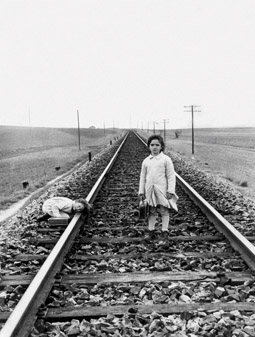
The Spirit of the Beehive
Many RealTime readers will be familiar with the films of Abbas Kiarostami and have read about his photographic work (reported from an exhibition in Beijing in RealTime 84, p24). He’s soon to direct Mozart’s Cosi Fan Tutte for the English National Opera. Spain’s Victor Erice, filmmaker and reviewer, is a much less familiar figure having made only three, albeit acclaimed, feature films (The Spirit of the Beehive, 1973, The South, 1983, The Quince Tree Sun, 1992) over some 30 years.
An exhibition of film, video, photography and painting by the two artists will be accompanied by filmed dialogues. Erice and Kiarostami are the same age and their films share some common preoccupations with childhood and our place in the landscape as well as distinctively poetic and contemplative styles of filmmaking.
Correspondences: Víctor Erice and Abbas Kiarostami offers a rare opportunity, beyond film scholarship and documentaries, to engage with filmmakers through their other means of expression and their communication with each other. To be able to see some of their key films, like Erice’s remarkable The Spirit of the Beehive (a superior companion piece to Guillermo Del Toro’s Pan’s Labyrinth) in this context will make for a very special cinema experience. RT
Correspondences: Víctor Erice and Abbas Kiarostami, curators Alain Bergala, Jordi Balló, Centre de Cultura Contemporània de Barcelona and la Casa Encendida de Madrid, ACMI Screen Gallery, Aug 21-Nov 2. Complementary film program to be announced,
RealTime issue #85 June-July 2008 pg. 22
© RealTime ; for permission to reproduce apply to realtime@realtimearts.net
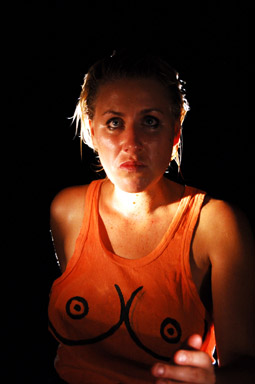
Brown Council, Runaway
photo William Mansfield
Brown Council, Runaway
WITH A STRONG PRESENCE AT THIS YEAR’S NEXT WAVE FESTIVAL AS WELL AS AT NATIONAL AND INTERNATIONAL FRINGE FESTIVALS, A NEW GENERATION OF YOUNG SYDNEY-BASED PERFORMANCE MAKERS IS CLEARLY GOING PLACES. CONSIDERING THE CURRENT VIBRANCY AND DIVERSITY OF SYDNEY’S EMERGING ARTISTS COMMUNITY, THIS IS HARDLY SURPRISING. AT PRESENT THE COMMUNITY TEEMS WITH TALENTED YOUNG INDEPENDENTS WHO HAVE CREATED ONGOING ENSEMBLES, INVENTIVELY SEEKING OUT AND STITCHING TOGETHER OPPORTUNITIES TO SUSTAIN THEIR PRACTICES.
They take advantage of emerging artists initiatives and mentoring schemes provided by contemporary arts organisations such as PACT Youth Theatre, Performance Space and Urban Theatre Projects as well as by federal, state and local funding bodies. In addition, they have also been rather proactive in creating their own opportunities through self-instigated, artist-run initiatives. The Cab Sav series, housed at Lanfranchis Memorial Discotheque until the venue’s demise last June, immediately springs to mind. Other initiatives include Quarter Bred, a residency program supported and housed by PACT Youth Theatre, and Underbelly, a public arts lab and festival, at CarriageWorks, now in its second year. Earlier this year, the Imperial Panda Festival, presented in small alternative venues, played to full houses every night of its two-week season.
Sydney’s young independents comprise a wide range of artists from various backgrounds and include performers, musicians, new media artists, writers, producers and designers. It is striking how close-knit and self-sufficient the community has become, with artists supporting each other’s practices, taking on various roles in their respective productions—on stage, behind the scenes and front of house.
brown council
The members of the all-female artistic collaboration Brown Council—Fran Barrett, Kate Blackmore, Kelly Doley and Di Smith—met when studying at Sydney’s College of Fine Arts (COFA). Straddling contemporary performance and the visual arts, their work is strongly concept driven, peppered with references to the history of performance art, but at the same time firmly anchored in the realm of high theatricality, incorporating outrageous wigs, costumes made of sheets and lots of fake blood.
In Milkshake, a short performance piece, later turned into a video work, Barrett, Blackmore, Doley and Smith are clad in hand-painted skeleton costumes, their faces made up to look like skulls. Subverting the overt sexuality of many music video clips, they perform a stylised booty dance routine to hip hop artists Kellis’ chart-topper Milkshake, while simultaneously drinking a litre of milk each. As they gyrate their hips and shake their torsos, they literally turn into human milkshakes. What started as a good-natured booty dance turns into an act of performative endurance. There are burps and pained facial expressions; it is obvious that the performers are on the brink of vomiting.
Brown Council’s first full-length work, Six Minute Soul Mate, which recently premiered at the Next Wave Festival in Melbourne, is a very different affair. Exploring the nature of love and romance within a contemporary quick fix culture, it consists of nine six-minute monologues in front of brightly coloured heart-shaped backdrops, emulating the structure of speed dating events.
post
Since starting to work together as a group in 2004, Post (Zoe Coombs Marr, Mish Grigor and Nat Rose) have gradually developed a distinctive theatrical style, fusing a penchant for brightly coloured lycra with an astute eye for political satire. Their most substantial work to date is their full-length theatre show, Gifted and Talented [RT80, p46]. Receiving significant critical interest when first performed at PACT in 2007, it has since become a hit on the festival circuit with seasons at the 2007 Melbourne Fringe Festival, the 2008 Adelaide Fringe Festival and the 2008 Brisbane Festival’s Under the Radar program.
Set behind the scenes of an eisteddfod, Gifted and Talented is an hilarious yet disturbing critique of the constant striving for perfection and obsession with imposing control over other people’s bodies. Dressed in multi-coloured fluoro tracksuits, Coombs Marr, Grigor and Rose play suburban mums who viciously discuss the failings of their amateur dancer daughters, all the while chain smoking, downing cans of Solo and gorging sausage rolls with gallons of tomato sauce. In an unexpected twist, Post link the cruel strategies their eisteddfod mums with acts of government sanctioned violence as reported in the wake of the prisoner abuse scandals in Abu Ghraib and Guantanamo Bay.
Post’s new work, Swimming Home in Heels, a 10-minute performance installation set in a hotel room for one audience member at a time, recently premiered at Next Wave. Exploring notions of lies and intimacy, it will form the basis for a new full-length theatre show, Shamelessly Glitzy Work, to be developed in residency at Performance Space later this year.
janie gibson
With two memorable solos, performed at short works nights at Performance Space and Lanfranchis in 2006 and 2007, Janie Gibson has established herself as a powerful and original performance maker with a keen interest in over the top characterisation and fantastical monologues. She recently created her first group work, The Whale Chorus, collaborating with performers Alex Grady, Matt Prest, Georgie Read and Phoebe Torzillo [RT84,p36]. Gibson directed the work as well as performing in it.
The Whale Chorus gingerly teeters on the line between dream and nightmare. It’s populated with centaur and gnome-like creatures as well as a troubled young family. There is exuberant ensemble dancing inspired by 1980s dance films as well as intensely delivered renditions of well known pop songs. There is also a narrative of sorts constantly looping back on itself, evoking David Lynch’s complex dream logic. Amongst all this, Gibson occasionally appears as a mysterious queen of evil, majestically delivering lines of comic book cruelty: “Do you dare me to stick my long extended fingernails into this electrical socket? Do you?”
Gibson’s next project, titled Cassandra, is a surreal domestic drama set in a space halfway between a kitchen and a karaoke bar. The performers, some from Whale Chorus, will take turns playing an exaggerated nerd character, Cassandra, donning a brown wig, a T-shirt with a pillow underneath, pants and glasses and clutching a bowl of Weetbix. Cassandra will be developed at Underbelly at CarriageWorks in July and presented at the Brisbane Festival’s Under the Radar.
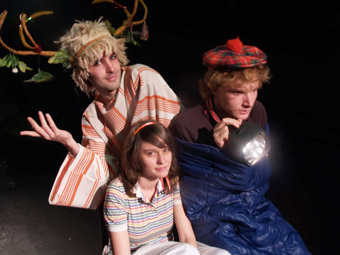
Pig Island, Simply Fancy
pig island
After meeting at the Sydney University Drama Society (SUDS), Nick Coyle, Charlie Garber and Claudia O’Doherty formed Pig Island in 2006. Since then they have created three full-length works, rapidly gaining a reputation as one of Sydney’s most exciting young theatre companies.
Their wildly imaginative and often deliriously funny self-devised shows have struck a chord with audiences and critics. Winning the Golden Gibbo Award for Best Independent Production at last year’s Melbourne International Comedy Festival for their first show, The Glass Boat, their most recent production, Simply Fancy, was picked up by Neil Armfield for a three-week season at Downstairs Belvoir Street where it played to good houses in January, before moving on to the 2008 Melbourne Comedy Festival.
Simply Fancy dazzles with its highly energetic performance style and dialogue-based text that is both fresh and inventive. Its rollicking storyline revolves around the quest of a dad and his two teenage children for a pineapple, kiwi fruit and guava to make a fruit salad for Grandma’s birthday. This absurdist, madcap adventure features a vast array of locations and characters, the most memorable being the mantaray, an enigmatic creature half praying mantis half stingray. Pig Island are currently preparing to take Simply Fancy to the Edingburgh Fringe Festival in August this year.
RealTime issue #85 June-July 2008 pg. 12
© Martin del Amo; for permission to reproduce apply to realtime@realtimearts.net
The 2008 Brisbane Festival includes in its potent line-up of performances, new works such as Elision ensemble’s production of Liza Lim’s new opera, The Navigator, directed by Barrie Kosky, alongside classics re-visited like Macbeth in the Contemporary Legend Theatre of Taiwan’s The Kingdom of Desire, replete with 22 performers, 15 musicians, Chinese opera and acrobatic fights and set in ancient China, and the British company Cheek by Jowl’s all Russian cast version of Chekhov’s Three Sisters, performed in Russian and directed by Declan Donnellan.
Peter Brook directs a monologue performed by long-time associate Bruce Myers in The Grand Inquisitor. Christ returns to Earth in Seville during the Spanish Inquisition, performs miracles and is, of course, judged a heretic. The Grand Inquistor is adapted by Marie-Hélène Estienne from Dostoyevsky’sThe Brothers Karamazov, and has not a little resonance with our own increasingly censorious times. The Queensland Theatre Company will premiere The August Moon about the impact of 2006’s Cyclone Larry. Within days of the disaster, playwrights Adam Grossetti and Jean-Marc Russ ventured north to witness the aftermath of the cyclone, documenting personal accounts of the trauma including tales of injustice which provided the material for their dramatisation.
A unique dance offering comes in the form of bODY_rEMIX/gOLDBERG_vARIATIONS, a ballet in two 45-minute acts featuring ten dancers from Marie Chouinard’s company which was founded in Montreal in 1990 and constantly travels the world’s arts festivals. The choreographer’s distinctive approach entails dancers working onstage with ballet barres, crutches, pointe shoes, harnesses and ski poles, adding a surreal prosthetic dimension to dance, extending reach and reshaping bodies.
Brisbane sound artist Joel Stern and “engineer, sculptor and self-confessed tinkerer” Beh Wattenberg come together to create The Swell String: “an obscured portal emits thunderous rumbles, metallic shimmering, pure tones and beautiful harmonic drones.” This experimental sculpture can be experienced at the Judith Wright Centre of Contemporary Arts.
More audience engagement comes in the form of an interactive work by leading UK media artist Gina Czarnecki, resident in Australian in recent years where she worked with Australian Dance Theatre on Devolution. The festival will premiere her latest creation, Contagion, at QUT’s Creative Industries Precinct: “Participants explore ideas of biological infection and the spread of information, knowledge, rumour and myth in society…”
In an interesting and distinctive move, initiated in 2006, the festival established its own curated fringe, titled Under the Radar, featuring in 2008 Black Curtain Theatre Movement of South Africa, The Lonesome Buckwhips of New Zealand, Legs on the Wall, Queensland’s Sandro Colarelli and provocative new works from emerging performers around Australia. RT
2008 Brisbane Festival, artistic director Lyndon Terracini; Brisbane, July 18-Aug 3;
www.brisbanefestival.com.au
See page 27 for another Brisbane Festival media arts venture, Big Square Eye.
RealTime issue #85 June-July 2008 pg. 10
© RealTime ; for permission to reproduce apply to realtime@realtimearts.net
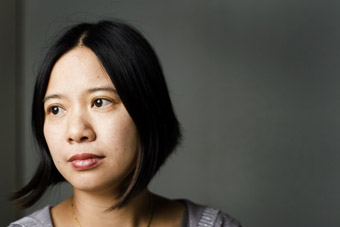
Liza Lim
photo courtesy Brisbane Festival
Liza Lim
COMPOSER LIZA LIM’S OPERA YUE LING JIE (MOON SPIRIT FEASTING) WAS ONE OF THE HIGHLIGHTS OF LYNDON TERACCINI’S 2006 BRISBANE FESTIVAL. NOW HER LATEST OPERATIC WORK, THE NAVIGATOR, AGAIN WITH THE ELISION ENSEMBLE WITH WHOM SHE HAS BEEN ASSOCIATED FOR OVER 20 YEARS, WILL PREMIERE AT THIS YEAR’S BRISBANE FESTIVAL IN JULY-AUGUST. THIS PROMISES TO BE ANOTHER STANDOUT EVENT WITH THE ADDED EXCITEMENT OF DIRECTION BY BARRIE KOSKY. LIM HAS COLLABORATED WITH KOSKY BEFORE ON THEIR MUTUAL ADAPTATION OF AESCHYLUS’ THE ORESTEIA, PERFORMED IN MELBOURNE IN 1993. WHEN I SPOKE TO HER AT HER WEST END HOME SHE WAS EAGER TO BEGIN THE PRODUCTION PROCESS WITH KOSKY WHOM SHE APPRECIATES AS A DIRECTOR WHO WILL APPROACH THE WORK WITH NO PRECONCEPTIONS. SHE FULLY EXPECTS HER OWN TO BE “BLOWN OUT OF THE WATER”, AND ANTICIPATES THIS PROSPECT WITH RELISH.
The Navigator is Lim’s third opera work to date and she avers enthusiatically that opera is her favourite medium: “I would just keep writing and writing them.” The impetus to embark on this form came when Kosky called her out of the blue about collaborating on The Oresteia. Lim believes that this is “probably the best way to start writing operas, by just falling into them.” The Oresteia was “very much about ritual and possession” and Lim sees a preoccupation with these concerns in her later work. Moon Spirit Feasting was about “communicating with spirits, or memory, cultural memory, the kind of knowledge contained in these stories being evoked, brought to life, through ritual.” The Navigator is mainly based on the Tristan and Isolde story combined with some personal links Lim has with Wagner’s opera. She first heard Wagner’s version in her early 20s when “it probably went over my head”, but since listening to an orchestral rehearsal of Wagner’s overture in Sydney later on she now regards the work as one of the absolute gems in the classical repertoire: “It was a revolution in musical language. The Tristan chord which is the kind of thing that people talk about broke all the rules of musical grammar.” Lim heard the prelude again in 2004 and “just kind of fell in love with music again.” (She had at the time put music on the backburner while she prioritized being a mother.) When she heard Wagner’s complete opera played at a music festival in Brisbane a connection was forged on an entirely new level: “It was like a door opening.”
The process of creating her new work began in 2005 so it has been quite a journey from the beginning to now. In a nutshell, the Tristan and Isolde story is of unrequited, adulterous love achieving transcendence in death, but Lim is not interested in this aspect at all. In her mind, “the subject of the opera is desire, not just sexual desire, but the erotic in the widest sense of unbelievable aliveness, of being in contact with some kind of ecstatic information.” Pausing, she muses: “That’s probably the topic of all my operas—some kind of ecstatic transformation.” She has seen what she describes as a fantastic production in Germany of Tristan and Isolde directed by Kosky, and she quotes his depiction of the work as “a fugue of the senses.” This strongly connected with Lim who values hearing, sight, touch and smell as ways of personally operating in the world, of exchanging with the world.
Another source of Lim’s new work is the Mahabharata—not the stories, but the key moments which Lim regards as “the point of absolute risk when you stand to lose everything to gain something, and that again is a portal to some kind of transcendency. You’re teetering between extremes, and in that teetering you go beyond ordinary concerns. You have a wider horizon.” As a corollary, what Lim finds exciting about the process of making a big project is all the unpredictable ways it might go because it depends on “being really present in the moment, whether it’s the actual thing of writing it, or when in rehearsal you see the configuration of bodies and the personalities and what people bring to it. I’ve written a score, but the way that score communicates is absolutely dependent on the presence of the performers and their energies, the aliveness they can bring to it.” This is why Lim finds it useful to talk about the work as a fugue of the senses because, in her view, the performers are not representing, not playing roles. “In that moment they are a particular constellation of energies, and that is what the work is about.”
Lim had worked before with her librettist, Melbourne poet Patricia Sykes, on a large work called Mother Tongue [2005] and proposed that they should make an opera together. “I really felt at that time that her kind of writing was what I would want to work with in a theatrical setting as well. The writing is complete in itself as a form of poetic expression, but it also opens up spaces in which music can exist, in which theatre can exist. Look at the different ways in which art forms exist in time. Music time flows in a certain way, theatre time flows in quite a different way. And then of course you have some things on a page. I just thought that those time flows could be counterpointed in an operatic form. There’s so much marvelous poetry I read, but it doesn’t allow me an entry. The music transforms the poetic into something else, although sometimes I think that can be a bit unbearable for a writer. It’s a very tense relationship. But Patricia is willing to engage in a dialogue about it.”
I suggest to Lim that her music is kinetic and she responds that she likes that word, because she does think very much of the physical gestures of the music and because, particularly in the case of instrumentalists, it’s very much an expression of a physical relationship that’s even more dramatised when you’ve got a singer whose body is her instrument. Lim finds her singers totally awesome considering what they’re required to do and because there’s no holding back. “Audiences find that quite frightening too. The vulnerability as well, inviting the audience to look at that aspect of themselves.” When pressed she submits she has extended her language in this work, particularly in the area of lyricism. The ritual aspect and the explosions of colour are all there, but there’s a lyricism as well. “Longing, yearning is a huge element. The tension between desire and the experience of desire. There’s a paradox in there. There’s the triangular relationship between the person who desires, the object of desire, and the pathway between them which, if it disappears, kills desire. It is the geometry of desire which is looked at in different ways.”
2008 Brisbane Festival, The Navigator, composer Liza Lim, librettist Patricia Sykes, director Barrie Kosky; Judith Wright Centre of Contemporary Arts, July 30-Aug 2
RealTime issue #85 June-July 2008 pg. 10
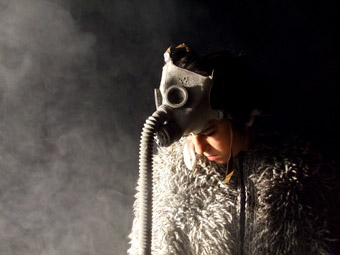
Comeback
courtesy Monster Truck
Comeback
OPENING NIGHT OF THE PLATEAUX FESTIVAL SAW THE FOYER FILLED WITH PEOPLE EATING TRI-COLOURED ICE-BLOCKS COVERED WITH SOMETHING THAT UNEXPECTEDLY CRACKLED AND POPPED IN YOUR MOUTH. IT WAS A GOOD METAPHOR FOR WHAT WAS TO COME OVER THE NEXT TWO WEEKS. THE INTERNATIONAL FESTIVAL TAKES PLACE ANNUALLY AT THE MOUSONTURM KÜNSTLERHAUS IN FRANKFURT, GERMANY, FOCUSING ON NEW DIRECTIONS IN CONTEMPORARY PERFORMANCE WHETHER IN THEATRE, DANCE, SOUND OR VIDEO. EIGHT YEARS ON, IT’S BUILDING A REPUTATION AMONGST ARTISTS AND PRESENTERS AS A PLATFORM FOR EXCITING, AMBITIOUS AND PROVOCATIVE WORK.
Comeback, a sugar-coated fairytale from the young German company Monster Truck opened the festival. It is a nightmarish theatrical spectacle that has overtones of Forced Entertainment’s Bloody Mess and, from Australia, My Darling Patricia’s Politely Savage. Comeback explores the things we are afraid of—mostly from childhood—and is realised as a fantastical nightmare featuring a candy dome-shaped house, a wolf in sheep’s clothing, a depressed donkey and libido-crazed wardrobe. It has very little dialogue, instead popular music shapes the non-linear narrative: AC/DC’s Thunderstruck when a heavy storm of candy floss blows in; Fancy Pants for the horny cupboard; and Ground Control to Major Tom to accompanies the precarious journey of a tin of beans travelling into the dark of night.
All of this might seem clichéd and obvious but the Monster Truckers are skilled makers, storytellers and performers. The entire set is handmade and remade for each performance by the five artists. Sugar and water boil for hours to make toffee windows that are re-installed in the house each day only to be smashed with an ice-pick in the evening; a candy floss machine is restocked with kilos of sugar for a snow sugar blizzard which leaves a deliciously sweet smell in the air; the roof of the house is rebuilt and re-covered in metres and metres of aluminium foil.
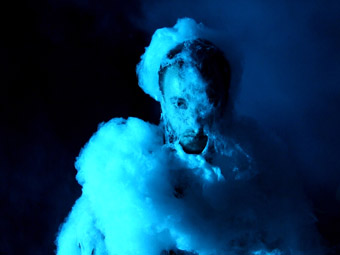
Comeback
courtesy Monster Truck
Comeback
My delight with Comeback was in the level of detail realised in each of the dreamlike images, the raw and recycled aesthetic of the set and costumes, and the surprising dramaturgical choices made to realise this fantastical tale. Leaving the theatre it felt like I had visited a surreal playground. I was giddy on the pandemonium, delighting in the chaos of night.
Throughout the festival the work of filmmaker Björn Renner played on a continuous loop across three screens in the foyer. Shot on 16mm the films ranged from a pop-music video clip (The Knife) to a claustrophobic afternoon tea with a fractured mother and her two grown, (co-)dependent sons (Exquisite Moments). Renner’s films are visually rich pastiches of child-like illustration, collage and animation spliced with film.
The main theme of the films’ emotionally disturbing content is dysfunctional relationships, whether with self, mother, teacher or partner. Each frame in Renner’s films appears like a blank canvas which the artist fills with absurd, surreal, sublime and ultimately compelling images. His films reminded me of a textured scrapbook—cluttered and overloaded with cut-outs, ideas and cultural references that were, at times, homoerotic and Freudian and, at others, innocent and naïve.
I was particularly drawn to the use of sound in Renner’s films. Composers Robin Spurrier and Michael Hansson use a diverse and heavily textured palette that ranges from the enchanted beauty of the harp to an extreme mash-up of noise. There was a seamless integration between sound and image that added to the unsettling experience for the audience.
Requiem is the latest show from the Swiss experimental sound group Velma. For this new work they transformed the large theatre at Mousonturm into a 1970s analogue sound recording studio complete with tan lo-pile carpet, a wood-panelled soundproof room (which doubled as a surface for projection) and moveable soundproofing boards. The audience sat inside the studio with the musicians watching the ‘session’ which included a manic drum solo, whispered a capella singing and a ‘melody’ played on a muted Casio keyboard.
The first half of the show was engaging and quite funny (even though the German audience wasn’t laughing) as the performers ‘set up’ for the gig. The non-performing bordered slightly on ‘acting’, however not enough to appear contrived, and the theatricality deployed in presenting experimental sound was exciting and visually superb. I could have watched the drummer all night: he looked like he had walked straight off the set of a Blaxploitation flick while one of the women in the group was a dead-ringer for Charlotte Gainsbourg. For a good 30 minutes I was happily taken for the ride. The group stuck strictly to Vatican rules about the duration of a requiem, making the show a little too long, and a little flat in the second half, too restrained and, at times, predictable and clichéd—especially in the way women were portrayed. The men played instruments and dictated the rhythm and flow of the show while the women had a sexual revolution, rubbing butter on glass and making love to a chair.
In a much more intimate show, Phantomgeschichte, using a screen and a miniature stage, Nicola Unger from the Netherlands tells the true story of her landlady “who charges too much rent for her flat in Rotterdam” and whose life changed forever one night in 1975 when she attended the same party as the most wanted man in the world, a terrorist, The Jackal.
Unger’s performance is quiet and considered. She sits in close proximity to the audience with her collection of cardboard cut-outs making the experience very personal. Using shadows, projection and simple animation, she tells the story of this night. She sets the stage, literally, for the events that are to follow, introducing the characters one at a time: “You will be a stewardess, and have three children and one of them will be disabled. You will work for Interpol. You will be the underdog. You will take fingerprints. You will check passports.”
Scenes change with the click of a finger as Unger slides people, palm trees and motorbikes across her miniature stage on long sticks. It’s easy to lose yourself moving between the one-dimensional world of cardboard cut-outs and projected images—each telling the same story in a very different way. This aesthetic contrast worked well although I preferred the miniature stage where I could watch Unger concentrating, preparing for the next character’s entrance.
As the story of the night unfolds, the focus shifts to the present day and becomes a comment on the war on terror with Osama Bin Laden taking the place of The Jackal. In the closing stages of the show, Unger highlights the media’s ongoing obsession with ‘a really good story’ whether then or now. As the show’s title suggests, this is a story that never dies.
Plateaux Festival: Monster Truck, Comeback, creators Manuel Gerst, Matthias Meppelink, Boris Nikitin, Sahar Rahimi, Cecilie Ullerup Schmidt, Ina Vera; Björn Renner Films, director Björn Renner, co-director Christoffer Paues, sound Robin Spurrier, Michael Hansson; Velma, Requiem, creators Christian Garcia, Christophe Jaquet, Valerie Liengme, Arantxa Martinez, Stephane Vecchione, music velma, lighting design Laurent Junod, sound design Ludovic Gugliemazzi, costumes Tania D’Ambrogio, scenography Serge Perret, production & dramaturgy Anja Haelg; Phantomgeschichte, concept, performer Nicola Unger, narrator Duro Toomato, sound Jonathan F Brown; Moustonturm Künstlerhaus, Frankfurt, April 17–26
RealTime issue #85 June-July 2008 pg. 8
© Rosie Dennis; for permission to reproduce apply to realtime@realtimearts.net
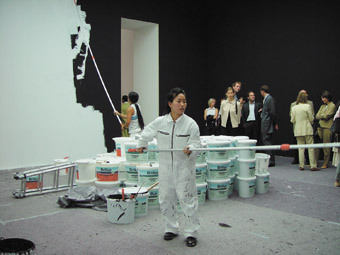
Nedko Solakov, A Life (Black & White), 1998, photo Giorgio Colombo
courtesy of the artist, Arndt & Partner Berlin/Zurich and the collections of Peter Kogler, Vienna; Susan and Lewis Manilow, Chicago; Hauser and Wirth, St. Gallen; Museum fur Moderne Kunst, Frankfurt am Main.
Nedko Solakov, A Life (Black & White), 1998, photo Giorgio Colombo
IT’S BIENNALE TIME AGAIN AND ARTISTIC DIRECTOR CAROLYN CHRISTOV-BAKARGIEV HAS ANNOUNCED THE THEME OF THIS YEAR’S EVENT AS “REVOLUTIONS: FORMS THAT TURN…A CELEBRATION OF THE DEFIANT SPIRIT EXPRESSED IN OVER 180 WORKS INCLUDING NEW AND AVANT-GARDE FROM LAST CENTURY.”
Many works in this year’s exhibition will be participatory, encouraging audiences to take the plunge to discover “new ways of looking and thinking about the lives they’re living.” We have been forewarned that “movement is a strong feature—works turn, spin, reverse, mirror, make noise and even blow up.”
Most interesting among the new media artists on the bill are Janet Cardiff and George Bures Miller who will create at Pier 2/3 a new work entitled The Murder of Crows, a 100 speaker work that envelops the audience. They refer in their works to “the world of film theatre and spectacle, as well as to the ways in which technology affects consciousness.” The installation will be structured like a play or a film but with images created by voice, music and sound effects. Inspired strongly by Goya’s The Sleep of Reason Produces Monsters, the work uses multiple soundscapes as well as composition in a blend devised to “challenge its audience’s view of the world”, and who could ask more of a work of art than that?
There are plenty more puzzling installations of the kind that generally turn up at biennales just to confuse us—rooms full of desks, chairs, whiteboards (someone should compile an inventory of materials sacrificed to art in biennales). Geoffrey Farmer turns aeroplane interiors into Airliner Open Studios. Raquel Ormelia upsets a Wilderness Society office. Lara Favaretto uses one ton of confetti, talcum powder and four hermetic stage ventilators. In A Life (Black & White), Nedko Solakov employs two painters to cover gallery walls in black, then white, then black again. There are ”public social sculptures” by Norwegian artist Anders Kieliesvik whose past work includes Happy Mountain Circus, in which performers in remnants of clown costume appear to be lurking on the edge of a precipice as in some actor’s nightmare.
For the truly adventurous, the Biennale put a call out for volunteers to work with artist Christoph Büchel who plans to create a punk rock band with four members over 80 years old. The band will rehearse God Save the Queen—the Sex Pistols version. Other performances will come from Dora Garcia, Joan Jonas and Ana Prvacki. Garcia will create a Lenny Bruce performance that never happened when the comedian was forced out of Australia in 1962 for performing obscenties (four letter words). Ana Prvacki will produce “a music-derived painkiller from saliva collected while practicing the flute.” Joan Jonas is a pioneering American performance artist working with video and live action and creating myriad exotic personae.
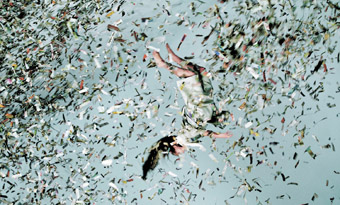
Rosemary Laing, weather #12, 2006
courtesy Galerie Lelong, New York, Galerie Conrads, Dusseldorf and Tolarno Galleries, Melbourne
Rosemary Laing, weather #12, 2006
The online venue work Inanimate Alice (www.inanimatealice.com) by Chris Joseph and Kate Pullinger has been described as “a digitized, interactive and dynamic story for the modern reader… that highlights the need for a new definition of reading and literacy.” It’s built around the story of a young girl growing up in the first half of the 21st century, and her imaginary digital friend, Brad. Over ten episodes, each a self contained story, we see Alice grow from an eight year old living with her parents in a remote region of Northern China to a talented mid-twenties animator and designer with the biggest games company in the world.”
William Kentridge, Dan Graham, Chris Burden are all represented in a number of works (including a lecture/performance within a video installation from Kentridge on Cockatoo Island) as are less familiar names from around the world many of whom are still early in their careers. Australian representation abounds—Stuart Ringholt, TV Moore, Raquel Ormelia, Mike Parr, Rosemary Laing, Tracey Moffatt, Vernon Ah Kee, Gordon Bennett, Richard Bell and Shaun Gladwell.
Held at diverse venues including Cockatoo Island and in the western suburbs of Sydney, the Biennale ‘constellations’ are envisaged as “public conversations involving a wide range of participants on topics related to contemporary art, its place in society, cross-cultural and urban experiences, cultural politics and the making of art exhibitions.”
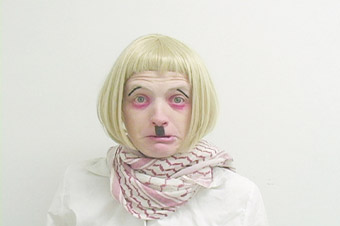
Tamy Ben-Tor, The Dance of the Albino Rat
courtesy of the artist and Zach Feuer Gallery, photo Zach Feuer Gallery
Tamy Ben-Tor, The Dance of the Albino Rat
The youthful Christian pilgrim hordes who will have just vacated the city will be thankfully replaced throughout June-July by another kind of faithful when all manner of artists, curators, academics, poets, philosophers, activists and others will travel to Sydney to take part in the Biennale, to “understand, engage with and challenge” the works and ideas brought together under its banner. RT
2008 Sydney Biennale, June 18-Sept 7, www.bos2008.com
RealTime issue #85 June-July 2008 pg. 6
© Virginia Baxter; for permission to reproduce apply to realtime@realtimearts.net
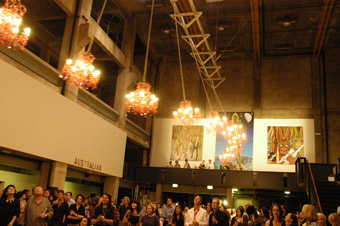
Casula Powerhouse Opening with Suzann Victor’s Contours of a Rich Manoeuvre III
photo Joanne Saad
Casula Powerhouse Opening with Suzann Victor’s Contours of a Rich Manoeuvre III
DESPITE THE FACT THAT ONE FEATURES A SINGLE CHINESE ARTIST, BOTH EXHIBITIONS, AI WEIWEI: UNDER CONSTRUCTION AT CAMPBELLTOWN ARTS CENTRE AND AUSTRALIAN AT CASULA POWERHOUSE, FOREGROUND THEIR SPECIFIC LOCATION IN WESTERN SYDNEY, WITH ITS ASSOCIATIONS OF MULTI-ETHNIC COMMUNITIES, RELATIVE SOCIAL DISADVANTAGE AND REAL VULNERABILITY TO THE ABSTRACT TRANSACTIONS OF GLOBAL CAPITAL. IN HER INTRODUCTION TO THE CATALOGUE FOR UNDER CONSTRUCTION, THE CENTRE’S DIRECTOR LISA HAVILAH DESCRIBES HOW THE PROJECT WAS HATCHED IN THE CONTEXT OF CAMPBELLTOWN’S INTEGRATION INTO SYDNEY’S HEADLINE ACT OF CONTEMPORARY ART, THE BIENNALE, TWO YEARS PRIOR, AND THE CURATOR CHARLES MEREWETHER’S INTEREST IN ENGAGING THE COMMUNITIES OF WESTERN SYDNEY.
Ai Weiwei’s thematic concern with the effects of a rapidly modernising China, including his own role as a collaborator on many significant building projects, is thus woven back into local issues. Not only is Australia’s current prosperity linked largely to China’s demand for raw materials to feed its modernisation, but also the changes such massive development has wrought on the world’s economic balance of power have direct knock on effects for Australian communities, as much as for Australian values, including commitments to heritage, environmental conservation and sustainability.
Over at the recently re-opened and refurbished Casula Powerhouse, ex-Artspace director Nicolas Tsoutas also cites the demographics of the region as a major consideration in putting together the exhibition titled Australian. Along with a number of alumni from the recently dismantled visual arts course at University of Western Sydney (and some current art world stars), the exhibition includes the work of young local artist Sadar Sinjawi, who settled in Casula from Kurdistan. Tsoutas, like Havilah, claims that the particular social and economic pressures in the local area (Liverpool has one of the country’s highest rates of forced mortgagee sales), shadow the work created for the show. While not all the artists consider themselves ‘political’, their work resonates with these broader social phenomena. Commissioned under a curatorial rubric—the complexity of what it means to be Australian today—the work addresses themes such as the environmental impact of exotic species, street culture, the status of national icons, spirituality, migration, Indigenous politics and cross-cultural identity, all permeated by the language of globalisation.
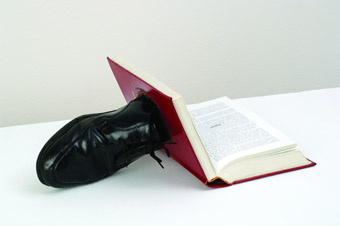
Ai Weiwei, Untitled, 1986, book with shoe,
courtesy the artist and Galerie Urs Meile, Beijing-Lucerne
Ai Weiwei, Untitled, 1986, book with shoe,
Which brings us back to Ai Weiwei’s overarching theme: the price and effect of a China gone global. Ai Weiwei’s work is unnerving in its ability to evoke China’s massive scale, in terms of territory and population, while figuring very few people. The masses are mostly conjured in absentia, through images of traffic, endless housing developments, left luggage or a veritable army of empty chairs. This absence keys in to the predominant aesthetic of the artist’s work in this exhibition: minimalism. Whether in his objects, installations or photographs, Ai Weiwei draws on the language of minimalism, more overtly at times, with his cubes and floor pieces that look to Robert Morris and Carl Andre (such as A Ton of Tea 2006, and Souvenir from Beijing, 2002), more subtly at others. One curious effect of this is that the China he presents is muted, quiet, and formally ordered, not a chaotic and dynamic powerhouse of industry and ideas.
The other effect is that Ai Weiwei’s China appears to be already framed by a Western eye. Certainly his work squarely addresses the history of Western art. One room is dedicated to early pieces from the mid-1980s made while living in New York which pay homage to Marcel Duchamp, Andy Warhol and Joseph Beuys in turn; another work renders Tatlin’s Monument to the Third International as a floating chandelier. His photographic and video documentation of Beijing’s Olympic makeover, and his ‘up yours’ gesture to symbols of global power (such as Study in perspective—White House, 1999), also betray the mediation of a Western eye. It is where this familiarity is less evident, such as in those objects assembled from the detritus of ancient temples destroyed by the forces of modernisation, that the work really bites. The resonance of these ancient relics is very strong; they evoke the irredeemable loss of the past and cultural heritage, and the ruthlessness of progress at any cost. Bed (2004) a floor sculpture made by laying together grooved ironwood recovered from a dismantled Qing dynasty (1644-1911) temple, is particularly poignant. But Ai Weiwei’s hybrid sculptures also exude the spirit of invention and resourcefulness of a nation so spoilt for cultural riches it can afford to squander them. Table with Two Legs on the Wall with Different Angles (2004) and Tables at Right Angles (1998), both made from Qing dynasty furniture, playfully enact cultural contortions while retaining a melancholy air about the indignities of having to perform to a foreign audience.
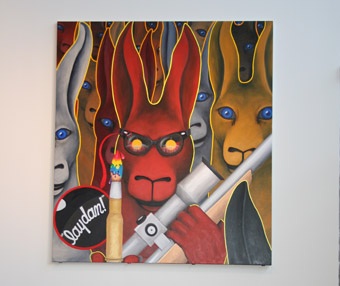
Gordon Hookey, Deneo C The Verry Verry Really Deadly Divine Sublime Bitchewmen Bhharbee Blhhaktjinn 2008
photo Joanne Saad
Gordon Hookey, Deneo C The Verry Verry Really Deadly Divine Sublime Bitchewmen Bhharbee Blhhaktjinn 2008
The documentary style and austere aesthetics of Under Construction stand in stark contrast to the riotous colour and almost Baroque aesthetics of Australian. Such exuberance is still rare in contemporary Australian art, and makes for a welcome change. Gordon Hookey’s gaudy, deliberately cack-handed comic satires of contemporary Australian politics dominate the main exhibition space at either end. David Griggs’ garishly coloured billboard-like paintings of life lived tough in the Philippines, Savanhdary Vongpoothorn’s intricate perforated canvases and Guan Wei’s multi-panel constellation painting all grapple with Judy Watson’s permanent floor installation and the space’s awkward architecture. Tucked away behind the main room, the lush aesthetics continue in Shaun Gladwell’s video installation, Planet and Stars Sequence, Maria Fernanda Cardoso’s wearable sculptures, Emu Wear, and the latest incarnation of Nike Savvas’ vibrating atom installation, Where Painting Begins: Atomic in full sunlight.
Gladwell’s videos record the artist in four different cities, street busking with his aerosol can. He makes small works on cardboard featuring images of stars and planets, using the containers of everyday multinational products for masking, and then erases each with black paint. It is a simple gesture that effortlessly connects the trajectories of global commodities with the art object, and links the artist’s process with an attempt to claim and control a creative space outside those trajectories. The work is greatly enhanced by its installation in a claustrophobic dead-end of the gallery, under a rail-track whose pylons sport readymade graffiti.
Another work whose installation makes great use of the Powerhouse’s industrial scale and readymade environment (including its permanent installations) is arguably the strongest here: Suzann Victor’s Contours of a Rich Manoeuvre III, a kinetic sculpture suspended above the gallery’s main room, comprising 12 red crystal chandeliers attached to a metal rod. From a motionless start, the pendulums begin to swing and gradually form a pattern: alternate chandeliers cut through the air with great pace and precision, resembling the goosestep of Chinese soldiers. As the movement slows, a new pattern emerges: the chandeliers form a sinuous line that recalls the trail of a Chinese dragon. (Its reflection in Judy Watson’s floor work caused Gordon Hookey to remark that the Rainbow Serpent had been woken!) This is a beautiful work in every sense: an elegant design, a memorable image, an affecting conceptual thread about the choreographed movements that those caught between cultures—in this instance Western and Eastern— must perform.
In probably unintended ways, these two exhibitions complement each other, offering alternative perspectives on the place of the artist in a globalised world, and alternative artistic strategies to engage with the effects of that globalisation.
Ai Weiwei, Under Construction, curator Charles Merewether, Campbelltown Arts Centre and Sherman Contemporary Art Foundation, Campbelltown Arts Centre, May 1-July 26; Australian, curator Nick Tsoutas, new work from 12 artists, Maria Fernanda Cardoso collaborating with Ross Harley, Sean Cordeiro/Claire Healy, Shaun Gladwell, David Griggs, Gordon Hookey, Dani Marti, Raquel Ormella, Nike Savvas and Stephen Little, Sadar Sinjawi, Suzann Victor, Savanhdary Vongpoothorn collaborating with Richard Johnson, Casula Powerhouse, Casula, Sydney, April 5-Sept 7
RealTime issue #85 June-July 2008 pg. 4-5
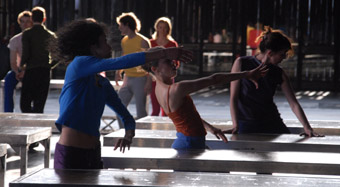
One Flat Thing, Thierry de Mey
The screening programs presented as part of this year’s ReelDance Festival were generally strong and, yet, one of them clearly stood out for me: Contemporary Dance on Screen. A veritable treasure trove for anyone interested in contemporary dance, it brought together three of the art form’s biggest names: William Forsythe, Pina Bausch and Les Ballets C de la B.
The program opened with One Flat Thing, Reproduced (Belgium/Germany, 26mins), a screen adaptation of William Forsythe’s work of the same title, originally created with dancers of the Frankfurt Ballet in 2000. Set in a vast industrial hall with natural light streaming in through large windows, it features 20 metal tables, amid which 17 dancers execute Forsythe’s extremely intricate and complex choreography, ranging from sharp-edged angularity to off-centre languidness.The piece is widely regarded as one of Forsythe’s masterpieces, and acclaimed filmmaker Thierry de Mey has done an excellent job in translating it to the screen. His approach to filming is unashamedly subjective, his camera knows no boundaries and seems to be ubiquitous. It hovers above the tables at one moment and crawls beneath them in the next. It smoothly moves vertically but also frequently circles the action. With a camera of such flexibility, de Mey supports and reinforces the obsessively multi-directional choreography. At the same time, he offers the film's viewers perspectives on the work that audience members at the live performance never would have.
In Pina Bausch (Germany, 45mins), a documentary on the grande dame of dance theatre, German filmmaker Anne Linsel has achieved something of a small miracle, managing to get the notoriously camera-shy Bausch talking candidly about her life and work with Tanztheater Wuppertal, the groundbreaking company she has directed for more than 30 years. Meticulously researched and masterfully edited, this film provides a comprehensive overview of Bausch’s achievements. Excitingly, it brims with excerpts from her shows, including the iconic scene from Nelken in which performer Lutz Foerster, clad in a tuxedo and standing on a stage covered with carnations, interprets the song The Man I Love in sign language. There is also an excerpt from Bandoneon (1982) with Australia’s Meryl Tankard at the height of her performative powers, repeatedly pushing the head of fellow dancer Nazareth Panadero into a bucket of water, all the while screaming, “Smile, Nazareth, smile!!!”
In addition to Bausch herself, the film also includes interviews with some of her longtime collaborators as well as many of her dancers, several of whom have been with the company for more than 25 years.
There is a lot of talk about trust between Bausch and her dancers. She admits to leaving her dancers in the dark as to what exactly she is looking for during a rehearsal process and which bits of the generated material might make it into the show. One of her dancers sums up the relationship between Bausch and the dancers as resembling more a love affair than a work relationship. She then adds: “That causes a lot of pain.”
This film is a thoroughly fascinating document. It confirms Pina Bausch as a passionate artist of great artistic and personal integrity and reveals the depth of the relationship between Bausch and her dancers, which has produced some of the truly stunning contemporary dance creations in the last 30 years. At only 45 minutes, the film is a model of economy and restraint and left this viewer utterly satisfied.
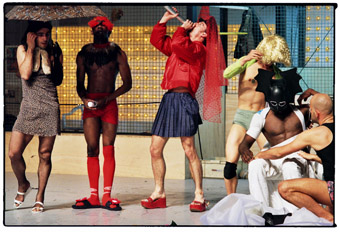
Les Ballets de Ci de La, Alain Platel
The closing film, Les Ballets de Ci de La (Belgium, 55mins), celebrates the history of Belgium’s famous dance and theatre company Les Ballets C de la B on the occasion of their 20th anniversary. It was made by the collective’s founding member and key figure, Alain Platel. Integrating excerpts from shows with filmic portraits of some of the choreographers and dancers affiliated with the company, this insightful documentary sheds light on the socio-political context in which its work is created. In the most interesting sections of the film, Platel accompanies two of the company’s dancers as they return to their respective hometowns, small villages in Burkina Faso and Vietnam. In both cases, video footage of the dancers performing in Wolf (2003), a show directed by Platel, is shown to the dancers’ parents. It’s moving to see how they grapple with their sons having made a career for themselves in Europe, outside of the culture in which they brought them up. Pride is mixed with apprehension, a feeling shared by the sons, as Platel, in turn, shows the men coming to terms with their parents’ comments. Les Ballets de Ci de La powerfully confirms that it is the performers’ personal commitment, their thoughts, opinions and lives, that feed Les Ballets’ work that is internationally acclaimed for being deeply anchored in the everyday world with all its coarseness, imperfection and fragility.
Contemporary Dance on Screen, May 16, ReelDance International Dance on Screen Festival 2008, Performance Space, CarriageWorks, Sydney, May 11-18
RealTime issue #85 June-July 2008 pg. web
© Martin del Amo; for permission to reproduce apply to realtime@realtimearts.net
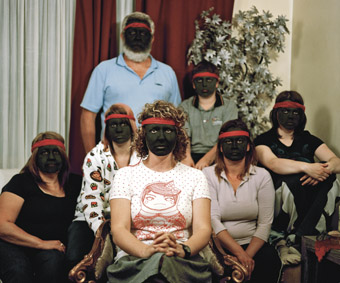
Bindi Cole, Wathaurong Mob (2008) from Not Really Aboriginal
Bindi Cole “explores how black you need to look to be considered Aboriginal and how white Aboriginals cross the cultural divide…Ultimately a celebration of Aboriginality in all its forms.” Part of Next Wave at the Centre for Contemporary Photography, Melbourne till July 5
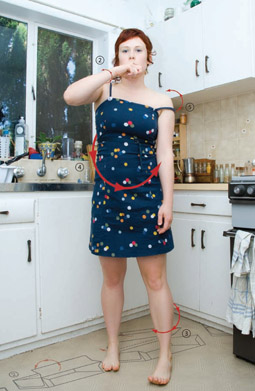
Alison Currie, 42a
photo Edwin Comey
Alison Currie, 42a
performer Alison Currie in 42a, an interactive installation-based work, part of a new triennially funded project to encourage independent artists to create works at the nexus of visual arts, new media and performance at Adelaide’s Experimental Art Foundation, June 26-July.

Tamy Ben-Tor, The Dance of the Albino Rat
courtesy of the artist and Zach Feuer Gallery, photo Zach Feuer Gallery
Tamy Ben-Tor, The Dance of the Albino Rat
Biennale of Sydney artist Tamy Ben-Tor, The Dance of the Albino Rat, documentation of performance at Stux Gallery.
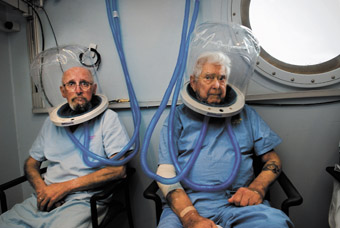
Leonard and William
photo Richard Kendall,
Leonard and William
Richard Kendall’s portrait of Leonard an William was one of 4 winners of the Head-on: Alternative Portraits prize at Australian Centre for Photography until June 7
RealTime issue #85 June-July 2008 pg. 2-3
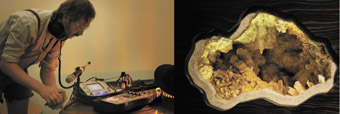
Chris Henschke & Donna Kendrigan, Rocks
courtesy the artists
Chris Henschke & Donna Kendrigan, Rocks
Themes of sound, space, art and science coalesced in discrete instances at two Melbourne art spaces. A performance by Chris Henschke to coincide with the closing of his and Donna Kendrigan’s collaborative exhibition, Rocks, continued earlier explorations of hybrid media, universal creative connectivity and the juncture between arts and sciences. Similar notions were explored in a sound sculptural installation by artist collective Plump, successfully drawing together art and physics in a manner that was cohesive and satisfying for both the artistically and scientifically inclined.
Amongst an assortment of geological sculptural forms at The Narrows, Henschke (who recently undertook a residency at the Australian Synchrotron particle accelerator) developed a dense soundscape with natural objects and live processing. Armed with a microphone, sound processing hardware, safety goggles and a few handfuls of dusty rocks, Henschke began his performance with sparse scrapings and the knocking of stones. Coupled with artificial reverberation effects, the sonic spatialisation that ensued served to transport the listeners’ imaginations out of their immediate acoustic environment; the psychoacoustic associations developed by Henschke’s soundscape creating a disjunction between actual and perceived space. With eyes shut it became difficult to imagine the artist as he was, huddled over rocks and electronics in a small white cube gallery space, rather than standing amongst the vast space of a natural cave formation, recording sounds as an acoustic ecologist.
The work satisfied with a lush palette of frequencies that one would expect in the sizable expanses of nature, from low rumbling reverberated drones to finer close-sounding clatters and ruffles. Subsequently, the piece was sonically dense, an aural pleasure. Henschke paid heed to compositional logic: the improvisation involved a series of cescendos rising to ominous overbearing peaks, then was in turn stripped back to focus on delicate textural sounds. Henschke’s medium was occasionally problematic—rock-on-microphone thuds disrupting the listeners’ experience of the sonically illustrated space. Towards the climax of the performance, microphone feedback hums were incorporated musically, yielding an appreciation of the work’s somewhat synthetic nature.
The organic and electronic, acoustic and synthesised crossed paths in a multi-dimensional and complex installation by Plump (Marc Rogerson, Philip Samartzis and Dave Brown, with projections by Marcia Jane) at the VCA Margaret Lawrence Gallery. In Cluster the causality of chaos theory seemed to be demonstrated on a human scale. Amidst what could be likened to a sonic ether of drones and a wholly immersive emission of sounds produced by Samartzis and Brown, Marc Rogerson’s cluster of suspended organic lightweight sculptural forms was gently fanned, swaying to and fro creating subtle knocks, rattles and creaks. These forms were internally lit, their lamps flickering as the sculptures made contact with one another. Indeed, with so much electricity about, I couldn’t help but sense a physical relation between the glowing cluster, the visible vein-like wires that manifested across the ceiling and the omnipresent clouds of electronically produced sound. As the audience members moved about the space, their correlation to the work was one among numerous physical factors affecting both the flow of air, the interaction between the objects and, subsequently, the sound that was emitted along with their own subjective perceptual experience. As the synthetic and recorded sounds dispersed, the change in air pressure further affected the behaviour of the sculptural cluster.
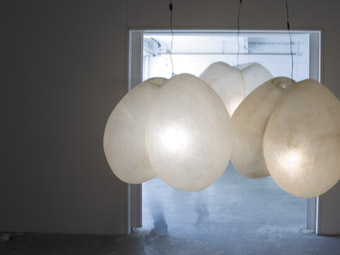
Plump, Cluster
photo Michael Blamey
Plump, Cluster
Fascinating for its multilayered demonstration of a ubiquitous scientific concept, the viewer/listener at Cluster can appreciate macro and micro-structural cause and effect. The work successfully avoided verging into the superficially pseudoscientific, as many attempts at a merger between art and science do. What’s more, Samartzis and Brown’s dense soundscape of drones, sine waves, electrical buzzes and crackles, as well as recorded sounds, rewarded the patient listener with a subtle and well composed musical experience. Marcia Jane’s projections added another slightly synaesthetic element and, like Rogerson’s sculptural cluster, played with the pertinence of light and optics to Plump’s installation, though perhaps lacking the subtlety of the sculptor’s contribution. After experiencing Cluster I contemplate a spiraling column of wind-caught leaves outside the gallery as part of a far greater chain of physical relations.
Chris Henschke/Rock Ensemble, performance, April 24 as part of Rocks, New Works by Chris Henschke and Donna Kendrigan, The Narrows, April 3-26; Cluster by Plump, artists Marc Rogerson, Philip Samartzis, Dave Brown, projections Marcia Jane; VCA Margaret Lawrence Gallery, April 26-May 3
RealTime issue #85 June-July 2008 pg. 30
© Jared Davis; for permission to reproduce apply to realtime@realtimearts.net
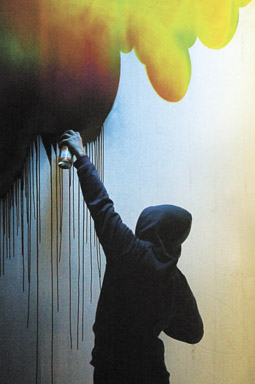
Blazeblue Oneline
photo Byron Perry
Blazeblue Oneline
IN ANTONY HAMILTON’S DEBUT FULL-LENGTH WORK, EVEN THE TITLE, BLAZEBLUE ONELINE, HAS A CHEEKILY OBSCURE BUT RHYTHMICALLY EXACT QUALITY. THE TONE IS VIGOROUS AND BRASH, MASCULINE BUT CHILDLIKE AND WHEN MYSTERIOUSNESS CREEPS IN, IT ISN’T LONG BEFORE THINGS POP BACK INTO MULTICOLOURED JOY.
Hamilton is best known as a key performer in works by Chunky Move and Lucy Guerin Inc. His concept for this piece began with a desire to meld dance with visual art. It was, for him, a natural extension of two art forms that he has pursued side by side for years. Like the action painters of the 1940s and 50s, Hamilton is fascinated by the gestural implications of visual art. But in contrast to the likes of De Kooning, he is also interested in working in the opposite direction, starting with a picture and moving towards an action.
The focal point of the visuals in Blazeblue Oneline is graffiti. But rather than being a show about graffiti, Hamilton uses its aesthetic mainly as a cohesive agent for a panoply of set pieces. As with Shaun Parker’s debut, This Show is About People, there is a sense of directorial excitability in the sheer eclecticism of Hamilton’s work. Offered the gamut of time and space he has responded by creating a piece that flies with exuberance in any number of directions yet retains a tautness that keeps it from becoming indulgent or insubstantial.
The show starts with a remarkable sound and light overture that teams Luke Smiles’ rumbling drum’n’bass with Bluebottle’s perfectly timed splinters of light—revealing the architecture of the Meat Markets with a menacing sense of anticipation. It is an opening with all the thumping import of a call to arms and plants us firmly in an urban culture of jagged beats and solid walls.
Onto the stage steps a lone man. Secreted under a hoodie and facing away from us, he stands still, peering at the white wall in front of him. It is the artist facing a blank canvas, his nature eventually revealed to us only in the blue tags he swiftly marks on the set. Before we can settle in to the sombre oddness of it all, Hamilton’s whimsy emerges with an irreverent pas de deux for two up-turned cardboard boxes. Their movements, expertly steered by concealed dancers, have all the bounce and geometry of graffiti while also seeming to reference everything from Busby Berkeley to a game of Tetris.
Hamilton, it would appear, isn’t going to take things too seriously and the audience giggles with delight when he and Smiles appear in rave-ready fluorescent leisure suits. They stand together, stillness interspersed with flurries of movement that match the off-centre choppiness of the grimy beats playing around them. The boisterous self-effacing mischievousness continues with an inspired segment of one-upmanship involving sheets of aluminium foil. Hamilton even throws in over-sized comic-book cut-outs, a laser sequence and a cardboard-clad Stuart Shugg as a Transformer figurine. It’s a melange that befits a boy’s bedroom: revelling in games and competition, in technology and self-expression.
Through all this playfulness, Blazeblue Oneline maintains the conceptual thread of integrating dance with visual art. Through the course of the show the set moves from a shiny white box to a surface carved up with looping curls and dripping angles. With sprays and markers, the dancers leave behind them a representation of action on the wall. At one point, Smiles and Hamilton sketch an intricately mirrored motif on the floor before teaming up to finish the job like a human inkjet printer.
Working in tandem with these visual manifestations of action, the show also extracts the lines and rhythms of its dance from what we see. Whether it is simply the preparatory shaking of an aerosol can writ large in the body, or the repeated outlining of a gesture, Hamilton’s choreography bears the hallmarks of graffiti. There is also a subtle recurrence of two-dimensional objects, such as cardboard, being given three-dimensional life and movement by the dancers. It is as though the flatness of visual art’s canvas is itself being reconstructed and reconfigured into the dynamic physical nature of dance.
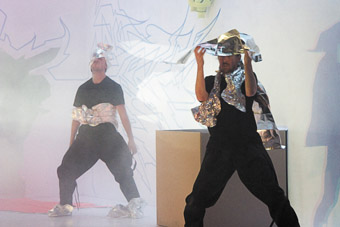
Blazeblue Oneline
photo Byron Perry
Blazeblue Oneline
Blazeblue Oneline offers up an appetising sense of what Hamilton will bring to his future works. It is clear that his personal capacity for expression sits comfortably with the creative forces he has gathered around him. The integration of music, lights and dance is almost seamless, with the distinct character of Hamilton’s vision always remaining clear. It is energetic, witty and charismatic. It is the work of a young choreographer who is clearly happy to play and the audience are more than happy to play along.
Blazeblue Oneline, concept, choreography, design Antony Hamilton, performers Antony Hamilton, Byron Perry, Luke Smiles, costumes Paula Levis, lighting, set realisation Bluebottle, sound design Byron Scullin, additional composition & editing Luke Smiles; Arts House, Meat Market, Melbourne, April 30-May 4
RealTime issue #85 June-July 2008 pg. 35
© Carl Nilsson-Polias; for permission to reproduce apply to realtime@realtimearts.net
RED DAWN. ENTER THE QUINKAN, AN ANCESTRAL SPIRIT. SLEEPERS WAKE WITH UNDULATING GESTURES. FEATURES OF THE LAND ARE FORMING, RIVERS FLOW, LIFE IS BEING CREATED. BIRDS SEEM TO FLUTTER INTO EXISTENCE. SNAKES SINUOUSLY WEAVE. THERE ARE PLUCKING AND GARNERING ACTIONS AS IF THERE IS A FRUITFUL ABUNDANCE. SIGNS ARE POTENT YOGA MUDRAS. SIMPLE ROBELIKE SKIRTS ODDLY EVOKE ANCIENT CRETE BUT THE COLOURS ARE UP COUNTRY, FAR NORTH QUEENSLAND RED, GREENS, OCHRES, DUSKY ROSE. THIS INDIGENOUS CONTEMPORARY DANCE WORK BY MARILYN MILLER IS BASED ON 12 DISTINCTIVE GESTURES PECULIAR TO THE COMMUNITY INHABITING MILLER’S OWN COUNTRY IN THE CAIRNS REGION. LATER THESE GESTURES METAMORPHOSE TO EXPRESS CLASSICAL THEMES OF CONFLICT, LOSS, LOVE AND RESTITUTIVE HARMONY.
Miller simultaneously explores the connections between the physical and spiritual worlds and the struggle between women and men in the creation of a matriarchal order. Her choreographic imagination is fertile and schematically inventive, even raunchy. She is particularly good at distilling dramatic moments which illuminate desire, sorrow and community celebration. The strongest image is of the tribal matriarch ‘gathering in’, healing in her hoop-like gesture the hole in the world. Romano Crivici’s supportive electronic score sensitively incorporates Indigenous elements to fulfill Miller’s requirement of a classically conceived musical composition.
Special guest, Northern Territory dancer Gary Lang endows the Quinkan spirit with a captivatingly vibrant and dangerous masculine edge. Lang is matched by the matriarch, Fiona Doyle, whose austere good looks are strikingly pharaonic in context. Doyle’s self-possessed, immensely grounded female authority anchors this piece. The rest of the ensemble is likewise compelling to look at, with the ability to be individually present in contradistinction to the neutral stance of much modern dance. There is some hesitancy from less experienced cast members in this still developing work. The performers’ energy carries the audience with it. In this respect, as the publicity for Quinkan states, “dance and life are one and the same.” This is a reorientation of the usual audience expectations. The work is, after all, a celebration as much as an art event. The crux of the narrative involves a conflict couched in gender terms between ancestral spirits who seem as pesky as the Greek gods and human beings subject to mortal frailties. The double perspective enables Miller to comment definitively on female strengths while at the same time relishing in her evenhanded presentation of undiluted male energy.
Miller has a wide-ranging background in dance, theatre and film. This proclivity for work in different media accompanies a largeness of vision and her own take on the Indigenous presence in the arts which, as exemplified in Quinkan, I find enticing and exhilarating. Elsewhere she has commented on the diversity of over 200 Indigenous languages and dance styles and makes the point that she sees Indigenous dance “as potentially providing an Australian dance vocabulary.” Quinkan marvelously points in this direction and makes sense of her remarks before the show about why she had wanted a classical dance score. It is as if there was created in this blend—an interpenetration of contemporary dance, classical music and Indigenous content conveyed through specific gestural language—an alternative, Utopian history. Europeans are here welcomed to the land and initiated into a properly timeless respect for the unique nature of the continent and the subtleties of its Indigenous culture. Miller’s artistic intervention is a generous gift to the colonisers, an opportunity to be taken up, a beautifully democratic quid pro quo countering the oftentimes paternalistic overtones of other sorts of interventions at large. To the extent that she has so exuberantly realised her vision, a vision without boundaries, Miller seems, in a broad political context, to be fulfilling Gramsci’s prescription for combining pessimism of the intellect with optimism of the will. In a word, her work is heartening.
The rehearsal room venue for Quinkan was somewhat spacially inhibiting for the scope of the work, so I look forward to seeing a fully realised production at the Festival of The Dreaming at Woodford in June.
Quinkan, choreographer Marilyn Miller, performers Gary Lang, Fiona Doyle, Darren Edwards, Jeanette Fabila, Tamara Forester, Rita Pryce, Hannah Scanlon, Ian Colless, composer Romano Crvici, rehearsal director Gary Lang; Judith Wright Centre for the Performing Arts, May 22
RealTime issue #85 June-July 2008 pg. 35
© Doug Leonard; for permission to reproduce apply to realtime@realtimearts.net
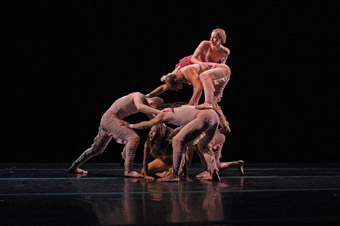
Pilobolus, Aquatica
PILOBOLUS DANCE THEATRE HAVE NEVER BEFORE PERFORMED IN AUSTRALIA, ALTHOUGH YOU MAY RECALL THEIR INTRIGUING SHADOW-PASTICHE OF MOVIE ICONOGRAPHY FOR LAST YEAR’S ACADEMY AWARDS. FOR THEIR AUSTRALIAN DEBUT, PILOBOLUS PRESENTED FIVE WORKS FROM THEIR REPERTOIRE AT ADELAIDE’S HER MAJESTY’S THEATRE, AS PART OF THE ADELAIDE FESTIVAL CENTRE’S PIVOT(AL) PROGRAM OF CONTEMPORARY DANCE.
Pilobolus traces its origins to Dartmouth College in Hanover, New Hampshire, where artistic directors Robby Barnett, Michael Tracy and Jonathan Wolken were students in the early 1970s. The company’s choreography—which, in this showing, included works from each decade since then—bares the traces of a counter-cultural kinaesthetic of collaboration, cooperation and closeness.
The look is quite distinctive. Whereas ballet’s velocity and poise emphasise the dancer’s lift and jazz’s presentational pizazz displays the dancer’s front, Pilobolus’s ensemble kinaesthetic rests upon contact, weight and curve. Cooperative weight-bearing and weight-sharing bind the dancers into evolving, shape-shifting, organic forms. With torsos in close contact, spines enrolled and limbs entwined, the seven dancers slide and morph across each other through each dance.
The effect is smooth as skin-tight lycra, meticulously styled yet evocative of natural forms and life processes. The most recent work, the collaboratively choreographed Aquatica (2005), depicts an underwater world of ebb and flow as delightful in its play of colour, form and movement as a well-stocked tropical aquarium.
The oldest work in the program, Wolken’s Pseudopodia (1973), is a solo study in embodied locomotion, performed with dignity by Jun Kuribayashi. A pseudopod is a temporary foot-like projection which certain amoeboid organisms use to move around. The company itself is named after a certain kind of fungus which Wolken studied as a student.
Tracy’s Symbiosis (2001) uses the biological concept of organisms living together in a mutually dependent, life sustaining relation as a metaphor for heterosexual coupling. Danced with intense physical interest by Jenny Mendez and Manelich Minniefee, the work pivots around conventional gender distinctions—small and large, slight and muscular—but with a consistency that is smooth, sliding and sweet.
Gnomen (1997) is a more unstable work. Ostensibly it’s a lyrical study in homosocial relations, its four male dancers—Andrew Herro, Jun Kuribayashi, Manaelich Minnieffee and Edwin Olvera—wearing nothing but tight black lycra shorts. There is intimacy and care amidst bravura, lifts and balances, but these near-naked male bodies read perhaps too readily as universal signifiers for relations of race.
The fifth work, Day Two (1980), directed by Moses Pendleton, features a striking soundtrack by Brian Eno and Talking Heads. The four male dancers are joined by Jenny Mendez and Annika Sheaff who perform topless and ride upon sticks in this ensemble exploration of the primitive sentiment of group dynamics.
The Pilobolus dancers cruise the soft borders of eroticism. Since the mid 1970s, nudity has been a controversial aspect of their work. But today the sensuality of their work is more akin to the romantic eroticism of greeting cards or the nude photography in fashion magazines.
The free-wheeling, free-flowing movement of the 1970s is perhaps best remembered in the unpredictable practice of contact improvisation. In the Pilobolus of 2008, the ooze and flow of bodies are given corporate form and what might once have been excessive is now channelled and contained. The company’s commercial arm, much in demand after the appearance on the Academy Awards, has since made television advertisements for the likes of Mobil, Ford, Toyota, Hyundai and Volkswagen.
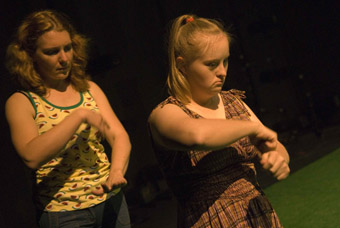
Zoë Barry, Anastasia Retallack, Safe From Harm
photo David Wilson
Zoë Barry, Anastasia Retallack, Safe From Harm
Safe From Harm, from Adelaide-based youth dance company Restless Dance, is also an experiment in form and the containment of excess. With this work, artistic director Ingrid Voorendt launches the company’s new professional ensemble. James Bull, Lorcan Hopper and Anastasia Retallack from the youth ensemble make their professional debut as performers alongside Stephen Noonan, Zoë Barry and Mario Spate. Previously Voorendt’s work with the company entailed harnessing the energies of youthful casts of twelve or more.
This work sits well within the generous breadth of the X Space Theatre at TAFE SA’s Adelaide Centre for the Arts. Gaelle Mellis’ design is spacious: the work is played upon a green expanse of artificial turf. Sounds of crows and planes fly overhead. Golf balls are scattered here and there between a few red flags. It feels as if we’ve woken up in some suburban park.
A wounded man (Noonan), an arm encased in plaster and a brace around his neck, lies sprawled at the bottom of a ramp. He stirs, climbs the ramp, looks around then falls. He does this several times in different ways. On the other side, there is movement inside a bright red tent. A woman (Retallack) crawls out and walks around, doing something intricate with her hands. Another woman (Barry) emerges, trundling an amplifier, saw and bow. Three other men soon follow and a set of games begin.
They run to pick up balls, from tent to flag and back. They play chasings, tag and Blind Man’s Bluf, Noonan plays with a radio-controlled car. Barry plays the saw. Hopper plays leapfrog with soft plasticity. Spate plays at being Marina Abramovic stabbing between his fingers with a knife. There are quiet games with pillows lit sweetly from within. There are also sentimental games with mirror balls, big group hugs and violent games with stabs and screams, gangs and bullying. The work passes through each game with an even rhythmic flow.
According to Voorendt, the work set out to pitch the “dignity of risk” against the “duty of care.” The polarities of ‘safe’ and ‘harm’ are clearly charted, even if their actualities are not explored for real. While duty of care is an age-old concept of the common law, the idea of dignity of risk, like Pilobolus, dates from the early 1970s. The phrase was coined by advocate Robert Perske to describe the right of people with or without disabilities to learn by taking risks and making mistakes. Reflecting on Pilobolus and Restless Dance, the phrase recalls for me the dignity of risking the excesses of collaborative encounters.
Adelaide Festival Centre’s Pivot(al), Pilobolus; Her Majesty’s Theatre, May 6-10; Restless Dance Co Professional Ensemble, Safe From Harm, director Ingrid Voorendt, performers James Bull, Lorcan Hopper, Anastasia Retallack, Stephen Noonan, Zoë Barry, Mario Spate, designer Gaelle Mellis, sound Zoë Barry, Catherine Oates, lighting Govin Ruben; X Space Theatre, Adelaide, April 18-24
RealTime issue #85 June-July 2008 pg.
© Jonathan Bollen; for permission to reproduce apply to realtime@realtimearts.net
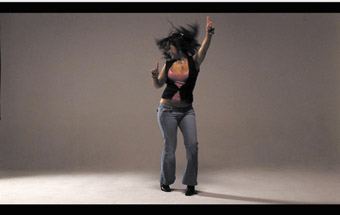
Meaghan McHenry, Dance Like Your Old Man
IN GIDEON OBAZANEK AND EDWINA THROSBY’S DOCUMENTARY DANCE FILM, DANCE LIKE YOUR OLD MAN, WE HEAR THE VOICES OF SIX WOMEN PRERECORDED IN INTERVIEW STYLE, BUT WITHOUT THE QUESTIONS, PLAYED OVER FOOTAGE OF THEM DANCING LIKE THEIR FATHERS. THE STORIES TOLD AND THE ‘OLD MAN DANCES’ ARE CAREFULLY POSITIONED IN A 10 MINUTE STUDY THAT ASKS WHAT WE UNDERSTAND OF OUR FATHERS AND OUR RELATIONSHIP WITH THEM. IT’S A QUESTION APPROACHED THROUGH MEMORY, BOTH SPOKEN AND EMBODIED. THE FILM PRESENTS AN INTERESTING CHASM BETWEEN THESE TWO MODES: A BODILY IMPERSONATION OF A FATHER’S DANCING AND A SPOKEN REVERIE OF THE RELATIONSHIP WITH HIM. EACH INTERVIEW HAS BEEN SHAPED WITH ATTENTION TO THE DIFFERENCES WHILE FILM EDITING IS RICHLY UTILISED TO SOLDER THE DISPARITY INTO A SINGLE TELLING.
The arrangement of the interviews develops and deepens this modal incongruency from first to last through editing style and pacing. The first dancer, Meaghan McHenry, presents an example of contiguity between the light and seemingly coquettish description of her father with the energy of the dance. The editing is quick, the range of shots bouncing playfully between close-ups of face, chest and midriff. A close-up of the young woman’s finger pointing (a favourite move of her Dad’s) punctuates the rapid vacillation between close, mid and long shots. From here the shape of the film begins to bifurcate between the tone of the telling which grows somewhat darker, and constancy in the joy of the dancing.
With the fourth dancer, Bec Reid, we are taken from the sweet reminiscence of daddy’s little girl, juxtaposed with the playful absurdity of a father who struts about “like a rooster with a fire cracker up his bum”, into slow motion treatment of a daughter’s disappointment and sadness at her hero’s love affair. The change is observed firstly on the dancer’s face followed by a close-up of her upper chest, and then in the softened texture of the reduced film speed. This is in stark contrast to the comic stiffness of the father’s jig. Now the slowing of the shooting underlines the gravity of the dancer’s words.
The final dancer, Ros Warby, walks into frame. She is composed, seeming to take a moment to reflect before moving. Positioned mid-frame and against the telling of a sad, affectionate story, Warby breaks into a fitful dance: upper arms closed tight on the torso, bent at the elbows, lower arms and hands moving vigorously, asymmetrical to the contained verticality of a body that seems to resist propulsion. The whole head engages appositely with the motion of the arms, shaking violently from the neck. The dance suggests a body constrained, inside, a ‘wild fella’ ready to erupt. We learn of addiction, demise and recovery, the memory however no longer bearing disappointment.
The film’s documentary inquiry deepens in this last episode with the reverent stillness of the camera and the absence of editing. It also reinforces a sense of the differences between embodied and spoken modes of memory expressed throughout the film. The finale completes a coherent and carefully constructed picture of six women’s stories, moving from many edits to none, from innocent fathers to the fallible and the forgiveness required. By using dance, Obazanek and Throsby avoid the pitfalls of storytelling that simply invites psychological analysis, asking us to recall in both word and body who our fathers are, or were.
–
Dance Like Your Old Man, directors, Gideon Obarzanek, Edwina Throsby, performers Meaghan McHenry, Sara Black, Alexandra Dillon, Bec Reid, Penelope Bartlau, Ros Warby, cinematographer Cordelia Beresford, editor Simon Njoo, online editor Oliver Clifton, sound editor, producer Chunky Move in association with Chequerboard Productions. 10 mins, 2007
Dance Like Your Old Man has won the following awards: 2008 Flickerfest International Short Film Festival, Best Documentary; 2008 ReelDance Awards, Best Documentary; 2007 Melbourne International Film Festival Nova Cinemas Award for Creative Excellence in an Australian Short Film, and Best Documentary—Short Film.
RealTime issue #85 June-July 2008 pg. 33
© Jodie McNeilly; for permission to reproduce apply to realtime@realtimearts.net
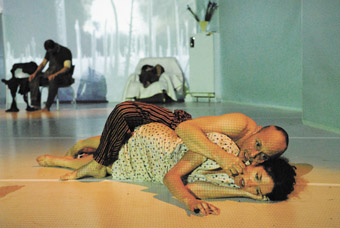
Rowan Marchingo, Elizabeth Ryan, Back From Front
photo Heidrun Löhr
Rowan Marchingo, Elizabeth Ryan, Back From Front
A SANDBAGGED TRENCH SEPARATES THE AUDIENCE FROM THE PERFORMING SPACE, BUT WHAT WE SEE THERE IS NOT FIRST A FIELD OF WAR BUT STARK WHITE WALLS THAT ARE SOON RECONFIGURED BY PROJECTIONS INTO ARMY BARRACKS, HOSPITALS AND THE HOMES OF AILING SOLDIERS—OR THEIR GHOSTS—AND THEIR LOVED ONES. DIRECTOR-CHOREOGRAPHER DEAN WALSH’S BACK FROM FRONT IS A DARK, RESTLESS DREAM WORLD WHERE NO ONE STORY IS TOLD BUT THE AGONIES OF MANY ARE IMPRESSIONISTICALLY SUGGESTED THROUGH FIVE PERFORMERS.
The recurrent figures are two male soldiers, one possibly a sergeant (“You will be a weapon”, he roars at his charge), a nurse and a housewife, all appearing to belong to earlier generations of Australians, presumably from World Wars I and II through to Korea and Vietnam. And there’s an apparently modern female soldier. As the performance commences she plays innocently with a black balloon against an ominous hum, sonar pings and, suddenly, the roar of a rocket tearing through airspace. Fear-inducing images soon grow in scale. Later a red laser dot ranges across the stage until it finds its target; he’s hit, he falls, projected blood pours out filling floors and walls. A giant red cross, again projected, slides up the floor onto the back wall transmuting from the caring symbol of the Red Cross agency into the threatening profile of a martial eagle.
Less dramatic but more ominously surreal are four refrigerators built into the walls. At once images of domesticity (constantly approached by the sleepless soldiers for milk) and bizarre entry and exit points to other worlds, the refrigerators suggest war-induced neurosis turning to psychosis, enveloping not only the soldiers but also their carers. It’s never clear precisely whose nightmare visions these are, but they will become ours.
Amidst these material and virtual transformations, certain actions are played out—a training routine that turns horribly compulsive, attempts to cradle and comfort, Rowan Marchingo and Matt Young turning on each other in an ugly robotic fight and a tense inconclusive battle scene.A wife sets the table with candle and wine; the soldier husband joins her but is consumed by a shaking which soon infects her. In the most sustained and palpably choreographed scene in Back from Front, Marchingo and Elizabeth Ryan come together in a frail, awkward shuffling dance ending in collapse. Pathos turns to fear, his body heavy over hers, locking her down while the nearby refrigerator is suddenly ‘alight’ with fire. Alone, the woman is possessed by a strange, swirling luminous blue light. Slowly removing her clothes down to her underwear, she appears to be in a reverie alternating between a sense of profound absence—of a body that she once felt as part of herself—and erotic presence, of feeling herself where once he was.
There’s a lot more to Back from Front—the hysterical release of the carers in bad jokes about wounding and death, a flood of letters announcing soldier deaths pouring out of a refrigerator, the female soldier fantasising a normal life in a blue dress and, finally, projections of unidentified photographs old and recent of those who died in or suffered the aftermath of war. The soldiers push three of the refrigerators forward and stand to attention on them in salutes to the victims of war. There’s no little irony in this gesture, a salute from the very military that kills and maims. It reminded me of the double bind that emerged in the wake of the treatment of veterans of the Vietnam War—we might disapprove of the war against Iraq but we must support our soldiers.
Dean Walsh has created a large scale, complex work, which on its first outing is occasionally affecting if often opaque and, in terms of multimedia, over-determined. There are powerful visual moments but they are sometimes either too illustrative or symbolically obvious and, in their endless variety, lack thematic cohesion. A sparer palette that allows a greater correspondence between performer and image and which lets us see the performers more clearly would benefit the work enormously. Similarly, the compilation of musical works, both popular and classical, veered from apt to melodramatic and again lacked cohesion, obscuring the work of the production’s composer. As well, an imbalance in performing and choreographic demands favoured Ryan, Marchingo and Young, leaving roles played by Lizzie Thompson and Marnie Palomares, although ever present, lacking impact. If Walsh can work from the directorial, dramaturgical and multimedia strengths of Back From Front, evident in his most sustained, physically and choreographically inventive scenes, he’ll create a more consistently powerful and moving work.
Back From Front, concept, direction, choreography Dean Walsh, performers Rowan Marchingo, Marnie Palomares, Elizabeth Ryan, Lizzie Thompson, Matt Young, medi artists Rolando Ramos, lighting & software design Simon Wise, dramaturg Nikki Heywood, set design John Levy, costume design Claire Britton, composer, sound designer Rosalind Page; Performance Space, CarriageWorks, Sydney, May 1-10
RealTime issue #85 June-July 2008 pg. 33
© Keith Gallasch; for permission to reproduce apply to realtime@realtimearts.net
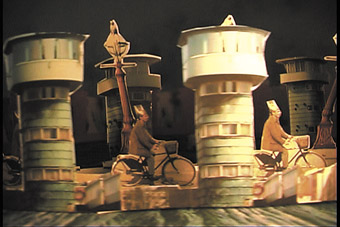
Copenhagen Cycles
IN LESS THAN A YEAR, MOVES, THE MANCHESTER-BASED DANCE ON SCREEN FESTIVAL, HAS UNDERGONE SIGNIFICANT FORMAT EXPANSION, INVOLVING PARTNER VENUES WITHIN THE REGION, A TOURING PROGRAM BROADCAST ON PUBLIC SCREENS THROUGHOUT THE NORTH OF ENGLAND, AND DEVELOPMENT OF A STRAND OF WORK MORE USUALLY ASSOCIATED WITH THE FIELD OF NEW MEDIA.
Now in its second year as an independent entity, Moves has nurtured a strong participatory element. Over and above the traditional baseline of screenings, a week-long filmmaking lab and networking and discussion forums provided the opportunity for artists from sound, animation, digital arts, short film and screendance to come together, exploring areas of commonality in their creative processes.
A three-day conference focused on this year’s festival theme—the interaction between sound and image. A series of eight, wide ranging, stand alone forums connected back to examples of individual practice, from Elinor Pearson’s examination of the gestural content of Maya Deren’s output, as situated within a “space beneath sound”, to Birgitta Hosea’s experimentation with synaesthetically oriented digital media. Billy Cowie’s deconstruction in Motion Control, co-created with Liz Aggiss in 2002, foregrounded the complex layering of aural input within the piece, while Donald Glowinski’s outlining of the EyesWeb application, analysing the affective content of movement patterning, elicited comparisons with the work of pre-cinematic moving image pioneers Eadweard Muybridge and Jules-Etienne Marey, their creations traceable as antecedents common to aspects of screendance, digital art and new media practice.
In addition, work proliferated in a number of non-traditional screening spaces throughout the city, with Manchester’s central rail station host to a series of luminously colourfilled lightboxes, and Claudia Kappenberg’s Moebius installation (2008) combining arrestingly abstracted stills with archive and newly-generated footage, projected in triptych form within a glass-fronted public building, viewable to passing foot traffic from street level.
In the first of a series of eight individually themed screening programs, work selected from the archives of Canada’s Bravo!FACT foundation included Larry Weinstein’s conceptually dissonant marriage of formal aria to domestic suburban banality in The Argument (2005). This contrasted with Marlene Millar and Philip Szporer’s rigourously claustrophobic framing in The Greater The Weight (2008), which captured the fiercely embodied performative intensity of a lone female, flamenco-gowned within the confines of a boxing ring. Ola Simonsson’s Music for One Apartment and Six Drummers (2002), from a selection of work screened in association with the Clermont-Ferrand International Short Film Festival, also conjured an ingenious rhythmic symphony from a series of incongruously domestic settings, offset by the epic sweep of visually sumptuous, butoh-inspired imagery in Alain Escaile’s Le Conte Du Monde Flottant (2003).
In the Subtle Architectures program, animation techniques used in the motion-based manipulation of footage presented a dizzyingly zoetropic challenge to the eye in both Bert Gottschalk’s Bildfenster (2007) and Eric Dyer’s Copenhagen Cycles (2006). Within the former, architectural detail, juxtaposed with materially-based referents, appeared as a constantly shifting matrix of vertical patterning. Here, filmstrip-like skyscraper windows framed viewing access to a series of creatively engaged human hands, while Copenhagen Cycles’ layering of cut-out imagery was reminiscent of a turn-of-the-century toy theatre, as oblivious oarsmen rowed through a kaleidoscopically colour-filled sea of flowers.
Imogen Sidworthy’s 7AM (2006), screened as part of the Visions D’Ailleurs programme, utilised ambient sound to suggest the presence of unseen movement merged with natural surroundings. Here, the careful arrangement of a close framed knee or torso, masked by the trunk of a tree, gradually offers access to fragmented increments of visual and aural material, building towards a slow panoramic sweep of early morning park-based Tai Chi practice. Mariel McEwan mixed animation, live action and faux-naif voice over in Niu Niu’s Story (2007) to slyly subvert traditional narrative tropes, charting through simple, front-on framing a Chinese dancer’s progression from freely skipping child to the infinitely refracted uniformity of the chorus line.
Elsewhere, an evening of work by British-based artist Alex Rueben drew together a number of short pieces, including the gently curving elegance of an animated line, swaying to the rhythm of the title track in Que Pasa (2001), interspersed with episodes from his music-driven road movie Routes (2007). Here, Rueben’s traverse through a constantly evolving landscape of indigenous culture within southern US states threaded together encounters with ferociously dynamic crumping cheerleaders and the whirling ceilidh-like melange of a social ‘contra-dance.’
Differing perspectives on the issue of narrativity were presented as part of the Discovery program where Damien Manivel’s Viril (2007) drew the viewer into an intriguingly paced world of masculine archetypes, allowing narrative threads to emerge from a seemingly unconnected range of otherwise unexplained episodes. A variety of male protagonists, whose mute concentration is punctuated by a bare minimum of ambient sounds, trade encounters in bedrooms and locker rooms, with female representation rendered as a dishwashing, back-facing presence, blankly impervious to the underwear-clad, pole dance of a male partner. Lutz Gregor’s Maps of Emotion (2008) explored territory reminiscent of Mike Figgis’ experimentation with simultaneity and subjectivity in his feature film Time Code (2000). Here, Gregor sets in motion a narrative premise by means of a divided screen. Played out against the nocturnal backdrop of an urban apartment and city streets, outer sections of the screen space are used to track the real-time journey of separation and reunion experienced by a male and female figure, each visible within a single square of personal space. This shared interior region of memory and emotionality, signalled by a range of devices including monochrome footage, night vision photographic stills and luminously graphic motion tracking, occupies the screen’s central section. The interrelation of visual imagery provides a choreographic scaffolding for the work with sporadic movement ‘echoes’ travelling between frames, while precise placement of overlapping footage heralds the couple’s final reconnection, as a photograph, handed across the darkness of the central region, completing the emotional journey.
Maya Deren wrote that the cinematic medium “consists of the eye for magic”, and this indefinable property was explored in a range of work presented in the festival’s final program. The movement patterning of birds in flight, flocking and diminishing in relation to guitar cadences, formed the basis of Marcel Prins’ The Gathering (2006), while Susanna Wallin’s highly original Night Practice (2006, an IMZ winner in the 2007 competition) made reference to aspects of documentary and narrative form, with a near-abstraction of movement content achieved by means of a deftly handled mix of shots. Music, sound and movement are balanced with the formal beauty of clock workings, as a group of teenage boys in an otherwise deserted athletic track inhabit a borderline zone of enigmatically harnessed energy, fluctuating between the exercising of specialist skill and out of hours larking around. A lone runner metronomically keeps pace around the periphery as a central group tumble onto crash mats. Meanwhile, a subtle interplay of gazes, exploring the implicitly heightened emotional territory of watching and being watched, is woven as a choreographic thread throughout the work.
Stan Brakhage has written of art-making as an exteriorisation of internal physiological rhythms, arising from the artist “hearing himself sing and feeling his heart beat.” The thematic highlighting of sonic input added to the relational mix of choreographically relevant raw materials comprising Moves’ signature programming style, with the festival this year consolidating its identity as an imaginative and inclusive platform set within the greater landscape of cross-genre work.
Moves08 Festival of Movement on Screen; Royal Northern College of Music, Manchester, April 22-26
RealTime issue #85 June-July 2008 pg. 32
© Chirstinn Whyte; for permission to reproduce apply to realtime@realtimearts.net
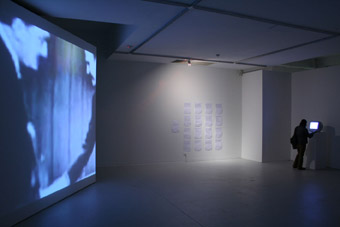
Mark Amerika, Mobile Phone Video Art Classics
courtesy of the artist
Mark Amerika, Mobile Phone Video Art Classics
TAKE AN AIMLESS RUN LOLA RUN THROUGH ONLINE SPACE TO THE SOUNDTRACK OF A POP SONG; INVITE SALVADORE DALI, MARILYN MANSON AND MADONNA ALONG FOR THE RIDE. TAKE SCI-FI AND LO-FI, TAKE CULTURAL THEORY AND TAKE WAY TOO MUCH OF IT ALL (MORE THAN YOU CAN TAKE IN). REMIX IT, MASH IT UP, THROW IT AT HOLLYWOOD (ENJOY THE PROCESS—GET DIRTY) AND YOU MIGHT HAVE A NICELY MESSY ANALOGY FOR MARK AMERIKA’S MOBILE PHONE VIDEO ART CLASSICS AT THE EXPERIMENTAL ART FOUNDATION (EAF) IN ADELAIDE.
Using the tiny frame of the mobile phone camera, US media artist and writer Amerika [RT80, p36] provides glimpses that contain only the loosest memory of subjects. The viewer is given small samples that suggest the presence of something greater; Amerika is not quite looking (but sideways sampling) the tirading torrents of online culture. Using pace and rhythm to convey to the viewer the feeling of diving into an information rich world, the experience of his work is of a chaotic journey across mash-up media popland. Wide eyed in a digital candy store, Amerika snatches the bits he wants with a refreshing (if disrespectful) disregard for intellectual property.
Utilising everyday consumer programs like PowerPoint and iMovie, Amerika gives his works an ‘anyone can do it’ flavour and highlights that his is a one man show, made from an unashamedly personal, subjective position. Much like a Duchamp of the digital age, Amerika has a knack for grabbing strangely right and slightly ludicrous stuff, ripe for re-contextualisation. Mobile Phone Video Art Classics is just one of the three video works included in the show. Presented as a large scale looped projection, it comprises a series of shorts that regurgitate media constructed personas. Recorded from existing media sources and filmed on a very lo-res mobile phone camera, characters including Madonna, Manson and Dali star as washed out, pixelated ghosts. These characters are re-introduced to the screens and copied to the point of abstraction. Amerika creates an awareness of the artificiality of celebrity on the blurring screen surface—a skin that he skims with relish.
The last chapter in Mobile Phone Video Art Classics is a quiet recording in a museum café. We can only make out the backs of heads as viewers settle into their coffee at that halfway stop point between the art and the street. Nothing much happens. The pixels sway with blurry uncertainty and the screen occasionally refreshes. This work comes from the border at the end of art viewing and is documentary in nature. Similarly, Amerika’s work itself seems restless in the gallery; it’s a loosely captured grab from a deluge of data that resists the permanence implied by art institutions.
Also in the space, Amerika writes (makes) his Postproduction Mantra; printed excerpts of his blog (Professor VJ) plaster the wall while a PowerPoint inhabits one corner and a computer, awaiting quiet exploration. Amerika throws a lot of language at his work; he theorises the work of postproduction artists with manifesto-like fervour. Stamping out his ground, he traces trends among artists who hybridise art forms, remix culture and use media with openness to changing the nature and sites of audience engagement. In Amerika’s hands postproduction artists are wizards of remixology: hackers of traditional media discourse.
“The virtual is the most powerful narcotic to have ever struck the scintillating nerve scales of the protoplasmic replicants…”
This is one statement from the tirade flowing below the large scale projection Society of the Spectacle (digital remix). Amerika’s language reveals a dream slippage between subjects that range from personal to pop to cultural theory. You can be pleasurably lost in the flickering mash-up of video and animation running above the text, however being ‘spoken at’ by the subtitles can prove overwhelming. With such relentless shifting of meaning and context it is not hard to see why Amerika cites the coining of the term “the information superhighway” by Nam June Paik as inspiration for the work.
My immediate response was enjoyment of the lush abandon of the work. Amerika throws things together with admirable lightness, making art that is cheeky, a little bit brave, even sacrilegious. However, as the torrent of information washes past me and subsides I am left with only the memory of the storm; loosely held subjects fading quickly in the weak sunlight outside.
Mark Amerika, Mobile Phone Video Art Classics; Experimental Art Foundation, Adelaide, April 18-May 17
RealTime issue #85 June-July 2008 pg.
© Sasha Grbich; for permission to reproduce apply to realtime@realtimearts.net
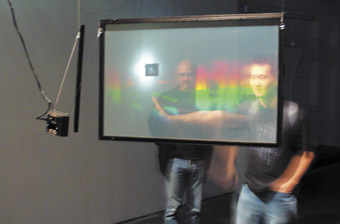
Martina Mrongovius, The Crossing
courtesy the artist
Martina Mrongovius, The Crossing
IMAGES CAN STIMULATE BODILY AWARENESS AND EVOKE, AT LEAST MOMENTARILY, SOME OF THE COMPLEXITY OF ACTUAL EXPERIENCE. THE GROUP EXHIBITION BEYOND THE WINDOW STROVE TO MAKE THIS PHYSICAL CONNECTION MORE EXPLICIT. CURATOR MARTINA MRONGOVIUS WRITES OF ENGAGING “THE VIEWER’S EMBODIED PALETTE OF SENSE TO EXPRESS SOMETHING BEYOND THE IMAGE.” CENTRED ON PHOTOMEDIA, THIS AMBITIOUS SHOW HAD THE POTENTIAL TO CREATE A SUBTLE AND EXPANDED UNDERSTANDING OF PICTORIAL IMMERSION.
The core of the exhibition comprises a suite of holographic images by Mrongovius. With their bursts of neon greens and oranges the holograms look like defunct technology for gimmicky toys rather than invoking sophisticated industrial uses. Yet, the sense of the mysterious technical complexity of etching an image with dimensional fidelity on a durable surface is nonetheless present.
The Crossing (2007), a suspended hologram diptych of numerous overlayed architectural details, was accompanied by a responsive soundscape by Philippe Pasquier. Against the difficult-to-pin-down holographic imagery, Pasquier’s shards of urban sounds seem too dense, consistent and coherent, failing to connect with the necessarily subtle movements of eyes, head and body with which the curious viewer has to navigate The Crossing’s chimerical visuals. Mrongovius’ holography makes intrinsic demands on the viewer to sway about to gain access to the imagery. If the sound component of The Crossing had likewise articulated the limits of perceptual mediation it may have connected with the tantalising dexterity of the holography.
Mrongovius inserts three dimensionality into the picture plane, yet the illusory nature is technologically restricted allowing for only partial, momentary articulation. This strained interaction highlights gaps between normal perception and what the pictorial holograph, and by association the mechanical expansion of vision in all photomedia, can provoke. Importantly, with these works we don’t so much move ‘beyond the window’ as bob about in front of it.
This was evident in the wonderfully awkward activity required to view Mrongovius’ We’re all looking series (2007). To find the images, viewers rolled back and forth with legs akimbo, for balance, on excessively low, cheap office chairs. The sliding illuminated photographic sequences of a group performing choreographed movements, iterating the artist’s focus on the perception of bodily motion.
In one hologram the movements involved the group simultaneously bobbing down, then standing and taking a photo, as if capturing the viewer. In this witty reversal the audience, instead of being positioned as transported witnesses, became the spectacle themselves, focused on by synchronised camera-wielders.
These holographic works took up the central gallery, with adjoining galleries each housing another work. Overly defined by the structural flow of the space, this seemed a self-conscious installation strategy. Mrongovius’ work dominated and surrounding works acted as weaker satellites. This lack of fluidity in exhibition layout was exacerbated by the use of elaborate custom made lightboxes to label each work. This appeared a stultifying attempt to re-emphasise curatorial coherence.
Another three-dimensional work (Erin Veronica Ender, Rachel Hanrahan and Max Hem) comprised two vintage stereo viewers. Peering through binocular lenses and then twisting a handle caused three dimensional photographs to flip forward, the images including Ender and Hanrahan wearing faux pilot costumes with glitter leggings. The stereo viewers as artefacts were wonderful, yet the artists’ intervention failed to reinvigorate them or expand the curatorial premise—the work seemed pointlessly flippant.
A similar over reliance on technical proficiency was evident in Yandell Walton and Clare Hassett’s Emergency (2008). A large photograph of a grief stricken woman sitting in a hospital was overlayed with a projection of an ethereal male figure slowly moving about her. This opposition failed to draw inspiration from the strong artistic tradition of exploring the nexus between photography and the moving image—the relationship remained uninterrogated.
The works in Beyond the Window were like dominoes, each highlighting the problematic strategies used in the next, the exhibition toppling into a survey of coy assaults against the still image. The experiential conditions to immersively ‘stretch the notion of the image’ were not realised. While the ingrained sensorial tension between the experience of the actual and the pictorial and their overlap was successfully articulated by Mrongovius’ The Crossing (if not in the sound collaboration), as a program about perception, Beyond the Window became paradoxically a catalogue of clunky, thwarted escapes.
Beyond the Window, curator Martina Mrongovius; Bus Gallery, Melbourne, March 18-April 5
RealTime issue #85 June-July 2008 pg. 30-31
© Amy Marjoram; for permission to reproduce apply to realtime@realtimearts.net
Under the previous John Howard government and some state governments of the last decade, the threat of censorship was every present. It escalated to an unprecedented level in 2005 when Howard sought to increase the extent of elderly anti-sedition legislation in line with the Federal Government’s Anti-Terrorism Bill. Despite considerable protest and Senate Committee recommendations to the contrary, Attorney General Phillip Ruddock pressed ahead, promising to review the laws once they were instituted. He didn’t. Howard’s line was ‘trust me’, assuring artists and satirists that they were safe to speak their minds. No one believed him. With the arrival of a Kevin Rudd Government it was assumed that the law and order drive, neo-liberal political correctness, ministerial interference in funding decisions and media-driven censorship frenzies would fade or, better, be firmly repudiated. While the Goverment is addressing a wide range of rights issues (which we hope will lead to a charter) and has allocated $2.8m in the current budget for such, Prime Minister Rudd and Arts Minister Peter Garrett’s responses to the NSW Police seizure of work by Bill Henson from the Roslyn Oxley Gallery were deeply disturbing. A virtue of Rudd’s election campaign in 2007 was his and his team’s refusal to be rattled or wedged. Other than having to strategically buy into some of Howard’s bigger spending promises, Rudd played it cool and casual. Now, like his predecessor, he’s playing it fast and loose—gut reactions on the fly, an opinion on whatever’s put to him. All very presidential. Instead of deferring the Henson matter to the appropriate ministers, he chose to speak publicly, what’s more condemning the work and thereby Henson—a pronouncement of guilt that brands a man forever. Rudd can only appear impatient, imperious and unjust, and worse, opportunist, given heightened public concern about sexual exploitation and abuse of the young. The censorious pall of the last decade hangs over us still, and now grows more toxic, sucking the air out of difference, stifling nuance. Australian art may well be poisoned by this episode, made cautious and more self-censoring in every way from creation to marketing to funding. We hope that the defenders of Henson’s art, including the 2020 Summit Creative Australia participants [see their Open Letter, p15], many other artists, arts critics and a wide range of commentators, not to mention the Member for Wentworth Malcolm Turnbull, will clear the air, allowing for clear thinking, uncluttered by prejudice and those ever ambivalent attitudes to art in this country.
RealTime issue #85 June-July 2008 pg. 1
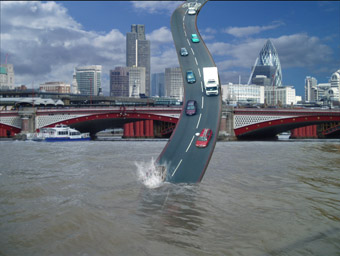
onedotzero, Graphic Cities
SOME FASCINATING QUESTIONS ABOUT ‘THE CITY’ AND ‘TECHNOLOGY’ WERE RAISED BY THE SOUND POLAROIDS RE-IMAGINING THE CITY FESTIVAL AT THE POWERHOUSE IN MARCH—THOUGH MAYBE NOT EXACTLY THE ONES EXPECTED AT THE OUTSET.
Sound Polaroids explored ‘performance, design, sound and vision’ in six sessions including screenings, live audiovisuals and a panel discussion. Screenings included a compilation of moving image work curated by the British hybrid media organisation onedotzero, which depicted a series of metropolitan landscapes, and AirplayUK, a collection of hot music videos produced in Britain. The live performance, titled Surface, was presented by a London-based creative unit, D-FUSE, who worked with artists in other cities to produce this ongoing, collaborative audiovisual work. In Brisbane they presented a compilation of their impressions of cities, including Melbourne, Kuala Lumpur, Seoul and Bangkok. After shooting high definition digital video and recording location sound, the group processes these impressions of the city’s sounds, textures, forms and rhythms in a live multi-screen audiovisual presentation.
It’s the conception of the work that raises some of the most interesting—and problematic—questions about this event. There is something a little eyebrow-raising in the idea of intrepid British explorers, armed with the latest high-end gadgets, venturing into the cities of the global South to capture and record their impressions—for the entertainment of those citizens later in the week. Of course, the fact that they work with local artists offsets this concern considerably, but nonetheless, I couldn’t help being struck by the sense of some kind of neo-imperialism going on, girded with the latest in panoptical sound and imaging technologies and delivered to expectant subjects in the ‘emerging’ world. This is maybe not fair to D-FUSE, who in Brisbane were probably exhausted after a hectic touring schedule, and whose genuine interest in positive social change—evident in other works—is undoubted.
I loved their earlier exploration, Small Global (not part of the Brisbane Re-Imagining the City), a multichannel video/motion graphics installation which collocates various texts and images of the planet to highlight normally overlooked relationships of exploitation. D-FUSE’s commentary, in this work on the bloodstained Congolese mining origins of coltan, the metal used in mobile phone chips, yielded highly intelligent, considered and imaginative insights. This nuanced commentary on ‘technology’ and ‘place’ was missing from the Brisbane performance presented by the group. As the title Surface warned, what audiences experienced was a surface-deep investigation of the more evident highlights and byways of bustling, growing cities in our region.
The use of pre-prepared files means that the performance in this case is of the customary laptop spectacle of the sound art world: earnest young men with blue-lit faces absorbed in the serious business of real-time file manipulation. In this kind of essentially VJing work there seems to be little of the urgency, emotion, hesitancy, rawness or self-revelation so critical to performance. Even artists working in the most technologised forms (like Robin Fox with his lasers) still manage to infuse their works, through the human-machine interface, with something of their persona. Though many of the individual video segments in Surface are doubtless extremely beautiful and their soundscapes inoffensively evocative, the sense of the person behind those images, or the people in the images, is somehow evacuated by the superabundant technological perfection. A colleague who witnessed the Melbourne performance thought the aesthetics were eerily like those of contemporary credit card advertisements, and an architect friend at the Brisbane performance thought there was something “big budget and really televisually familiar…like a segment from an ad for a new luxury car or Finnish mobile phone”, which for her, defused the performance’s radical or innovative possibilities, turning “the whole thing [into] a kind of superficial, high-tech love letter to traffic, highways, turnpikes, roundabouts and speed.”
In contrast to D-FUSE’s “aesthetics of overresourcing” (to cite animation theorist Esther Leslie), Amos Poe’s Empire II (2007), a video screened as part of Sound Polaroids, was a strictly low-end, consumer-level affair. At three hours long and ‘about’ the Empire State Building, there are no prizes for guessing which key film of avant-garde history it’s in conversation with. However, although it shares Warhol’s extreme durational approach (many think of the 1964 Empire as ‘an expanded cinema film’) and profilmic subject, Empire II is a much more constructed film, closer to the great city symphonies like Francis Thompson’s NY, NY (1957) and, particularly, the fractured cubist re-imaginings of Manhatta (Paul Strand & Charles Sheeler, 1921). Poe’s densely-layered, vibrantly coloured edit departs from Warhol’s static, black and white, silent minimalism with a dazzling, if chaotic, sound mix in which one can hear—and practically feel—all the jumbling voices, musics and poetics of contemporary New York City. The essence is the same: the use of a long duration (even if it is a year resolved into three hours, the screening time is still beyond the norm for most viewers) to query the psychogeographic relations of the impressive monument to its very human surrounds. The result is a surprisingly affectionate paean to this iconic building through the accretion of various layers and tiny details. In a work that gave you ample opportunity to appreciate nuances in time within a space, it was hard not to fall in love with the way it depicted the subtleties of shifting seasons, from the differing hues of afternoon sunlight glinting off the building’s windows to the various seasonal blooms gracing windowsills.
The central question, ‘how should we think about a city?’, occupied the discussion session held on the Saturday after Poe’s film, and it is clear from the lively response that the topic is one Brisbane audiences hold dear. Architecture’s highly informed and aesthetically attuned community turned out in force, with several well-known architects making intelligent contributions to a debate in which, in Brisbane at least, their voices have clearly not been adequately heard. Fired up with what many felt was the lionisation of progress at all costs, without examination of the consequences of the development boom, the debate became thrillingly heated. UQ architecture associate professor Peter Skinner helped bring the conversation about art and technocracy into the particular and the local by leading a fiery discussion on the ill-fated North Bank development. In March it consisted of a proposal for enormous concrete platforms jutting out over the Brisbane river (that proposal was scrapped in April after an extensive critical mauling). The critics’ slogan,“It’s a river, stupid”, was extended to “It’s a city, stupid”, when thinking about how careful attention needs to be paid to the integrity of the space, its masses and volumes, histories, spirits, feelings and aesthetics. In other words, what is specifically local within the global that makes each city a one-of-a-kind ‘thing-place’? For an event that was centrally concerned with the project of re-imagining the city, this session in particular brought home the most important aspect of looking at the city—that it is an organism in and of itself, mutually authored every day by its inhabitants, to whose voices and visions we need to look if we really are interested in the genius loci.
Sound Polaroids Festival, presented by Brisbane Powerhouse, Room 40 and The British Council; Brisbane Powerhouse, New Farm, March 28-29
RealTime issue #85 June-July 2008 pg. 29
© Danni Zuvela; for permission to reproduce apply to realtime@realtimearts.net
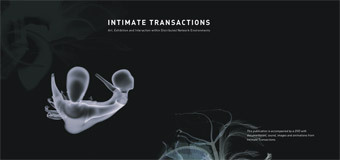
Intimate Transactions book cover by Stuart Lawson
YOU MAY HAVE READ ABOUT THE INTERACTIVE MULTIMEDIA PROJECT INTIMATE TRANSACTIONS IN THE PAGES OF REAL TIME [RT59, P20; RT67, P26]. SOME OF YOU MAY ALSO HAVE HAD THE OPPORTUNITY TO EXPERIENCE IT, RUBBING SHOULDERS AND EXCHANGING MUSCLE TONE WITH SOMEONE SIMULTANEOUSLY LOCATED IN A TOTALLY DIFFERENT GEOGRAPHICAL SPACE. NOW A NEW BOOK AND ACCOMPANYING DVD PROVIDES THE OPPORTUNITY TO RE-IMAGINE THE WORK.
Intimate Transactions is a collaborative project led by new media artist Keith Armstrong in collaboration with choreographer Lisa O’Neill and sound artist Guy Webster. Initially developed out of the Australian Creative Industries Network at Queensland University of Technology (QUT), this project has mutated and spread beyond its homeground, picking up researchers and partners across Australia. Pia Ednie-Brown and Inger Mewburn from the Spatial information Architecture Laboratory at RMIT brought their research interests in haptic technology to the project, while the collaboration with ACMI (Australian Centre for the Moving Image) in Melbourne enabled the group to test out the ability of the distributed technology to work at vast distances.
Intimate Transactions: Art, Exhibition and Interaction with Distributed Network Environment is a handsomely presented and richly illustrated volume which on first glance looks like a typical exhibition catalogue or even coffee table book. However, check the contents pages and a different picture emerges. With its research questions, essays by the key collaborators, interviews, its talk of prototypes and pilot studies and analytical texts from a diverse range of interlocutors, Intimate Transactions takes on the form of a hybrid text, somewhere between research, philosophy and documentation.
Edited by QUT academic, Jillian Hamilton, the publication positions the project not merely as an ‘art’ experience, but as a research project that has broad ranging implications for how we conceive and design our world in the 21st century. In particular the project questions our experience of the world through a reconfiguration of understandings of space and touch. It examines how this translates into what has come to be known as “experience design.” For example, Hamilton writes about how the rapid expansion of global networks has led to a compression of space that reignites conversations about ‘flat space’; Keith Armstrong articulates the ecosophical understanding that emerges in and through engagement with the work; while Ednie-Brown and Mewburn emphasise the project’s capacity to introduce a sense of embodiment through haptic feedback devices.
In her introduction to Intimate Transactions, Hamilton asks whether it is possible to create a sense of embodied communication or an intimate transaction between people who are separated by vast distances but joined by interfaces and distributed networks. I must confess that my own induction into the world of Intimate Transactions was anything but intimate. I was one of the pilot audience who ‘tested’ the first long-distance dual-site installation of the work between The Block in Brisbane and ACMI in Melbourne in 2005. Rather than establishing an intimate connection with another body, I recall that I felt very much like a subject in a scientific experiment and my rather clumsy engagement with the technology made me more aware of my inadequacies in the face of something unfamiliar. I became so lost in my own bodily struggles to negotiate a visual scenario that operated according to a logic (gaming logic) I was unfamiliar with, that I was only ever minimally aware of the ‘touch’ of my fellow traveller.
Johannes Birringer’s recollections of Intimate Transactions in his essay, “Transactivity”, paints a more nuanced response to the experience of the body shelf and interface design. He recognises that while the “erotics of transactivity may lie entirely in the realm of fantasy”, the work’s challenging synaesthetic qualities call into question conventional analytical ways of interpreting which privilege the linguistic over the corporeal. He suggests that the work calls for phenomenological investigations into the sensing body so that we can more fully understand the complex transactive media environments that increasingly form our world experience. For Birringer, as for many of the other writers, the critical element in Intimate Transactions is its capacity to raise questions to do with the ways we think about and intervene in the world through our (design) practices.
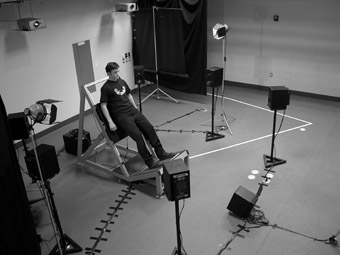
Intimate Transactions
photo Keith Armstrong
Intimate Transactions
The essays and interviews in the book play out this complex interaction between thought and action as it has occurred in the realisation of Intimate Transactions. In addition to addressing the pragmatics of the project—how for example it drew together the unique skills of individual artists and designers (new media artist, choreographer, furniture designer and artist, sound artist, programmer and architect designers) to create an interdisplinary collaboration—the book provides insights from other participants who have in some way been ‘touched’ by the project—technical staff and curators who worked with the creators to exhibit the work as well as those who experienced it in development. While there was a danger that a homogenous viewpoint might emerge, Hamilton has been careful to create a multi-faceted and richly layered conversation that draws out the diversity and inconsistency that has arisen through Intimate Transactions.
Intimate Transactions has been awarded a Visions of Australia Touring grant (2008-09) and will represent Australia in Beijing during the 2008 Olympics as part of China International New Media Arts 2008 at the National Art Museum of China; www.mediartchina.org;
www.maap.org.au;
transmute collective: www.embodiedmedia.com
Jillian Hamilton ed, Intimate Transactions: Art, Exhibition and Interaction with Distributed Network Environment, ACID—Australasian CRC for Interaction Design, 2007
RealTime issue #85 June-July 2008 pg. 28
© Barbara Bolt; for permission to reproduce apply to realtime@realtimearts.net
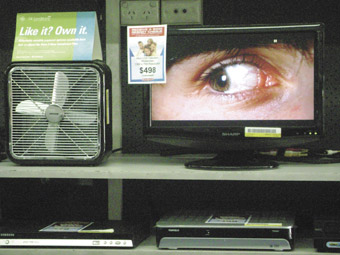
Big Square Eye, Brisbane
IN A MAJOR MEDIA ARTS VENTURE, THE 2008 BRISBANE FESTIVAL HAS COMMISSIONED BIG SQUARE EYE WHICH WILL DEVELOP AND THEN TRANSMIT THE WORK OF 15 YOUNG SCREEN ARTISTS ACROSS QUEENSLAND, MAKING THE MOST OF THE BROADCAST POTENTIAL OF NEW MEDIA TECHNOLGIES.
The young artists from urban and regional Queensland have been selected from 140 to collaborate with five mentoring media artists (Kate Geck, Andrew Gibbs, Ross Manning, Archie Moore and Alan Nguyen) on works for Big Square Eye.
The venture has been initiated by concept designer Vivian Hogg. Big Square Eye has included workshops, technical support and industry networking opportunities with an eye to not only each artist creating a work but generating careers.
Big Square Eye will appear as a multi-screen work at the QUT Creative Industries Precinct, in 16 RetraVision stores around the state and will be streamed online.
Big Square Eye, Brisbane multi-screen showings at The Block, Creative Industries Precinct, Queensland University of Technology, Kelvin Grove campus, July 19-Aug 3; www.brisbanefestival.com.au
RealTime issue #85 June-July 2008 pg. 27
© RealTime ; for permission to reproduce apply to realtime@realtimearts.net
NOT ONLY DOES THE SUBJECT MATTER OF ROLF DE HEER’S FILMS VARY WIDELY, THEIR SOUNDTRACKS ARE ALSO ALWAYS DIFFERENT AND UNEXPECTED, AND ARE AT TIMES RAISED TO A LEVEL OF DOMINANCE AMONGST THE NUMEROUS INTERACTIONS INFORMING THE NARRATIVE. MUSIC SCHOLAR CAT HOPE COMMENTS: “EACH OF DE HEER’S FILMS MERITS A DETAILED TREATISE ON THE WAY THEY FEATURE INNOVATIVE SOUND IDEAS IN THE SCRIPTING AND PRODUCTION STAGES, RESULTING IN SOME OF THE MOST CHALLENGING AND EXCITING CINEMA MADE IN AUSTRALIA TODAY” (WWW.SENSESOFCINEMA.COM). THIS AUTEUR’S ATTENTION TO THE AURAL IS PERHAPS EXEMPLIFIED BY HIS LONG TERM COLLABORATION WITH COMPOSER GRAHAM TARDIF, WHOM I INTERVIEWED IN MAY OF THIS YEAR. TARDIF HAS CREATED THE MUSIC FOR 10 OF DE HEER’S 12 FEATURE FILMS, THE EXCEPTIONS BEING A CONCESSION TO THE JAZZ ARTISTRY OF THE LEGENDARY MILES DAVIS AND MICHEL LEGRAND IN DINGO (1991) AND THE INDIGENOUS AUSTRALIAN PERFORMERS OF THEIR OWN MUSIC IN TEN CANOES (2006).
Since meeting de Heer when the budding writer/director/producer was still at the Australian Film, Television and Radio School, and composing the music for his diploma short, The Audition, Tardif’s subsequent career highs include The Tracker (2002) which he says “was built around the idea of these paintings [by Peter Coad] and these ten or eleven songs going through the film. To a large extent, the music informs [de Heer’s] thinking.” Certainly, de Heer is a director attuned to sound designer Randy Thom’s demand that directors should be “Designing a movie for sound” (www.filmsound.org), not simply leaving it to the end in the hope it may be somehow improved by the hasty addition of some great music.
Tardif explains how early he is usually involved by de Heer in the process: “We’d have a lot of discussions and we’d sit down and talk about what it should be like and we’d plot the film out together and then I’d come up with the music based on that discussion […] but I’d actually start serious thinking when there’s a finished script.” I asked Tardif how he communicates melodic ideas to someone without musical training: “We speak in terms of the feeling of the scene or the underlying emotion that he’s trying to convey rather than discussing diminished sevenths or anything like that. We can talk musical styles, I mean he’s not musically illiterate to the extent that we can’t talk about whether it would be a western style or a percussive, or, you know, he’ll understand that, or whether it’s classical or orchestral or rock.” Thus, Tardif and de Heer decided early in pre-production for The Tracker that they wanted the feel of a live band fronted by an Indigenous male singer. The result was Archie Roach later performing the songs—which de Heer had penned and Tardif had composed—live at a screening of the film in the Melbourne Concert Hall. Awards were received for best score from the Film Critics Circle and the IF Awards. The songs serve as an extra character, expressing the sorrow of a subjugated people, and Tardif’s music positively charges the text of the screen’s image.
But Tardif’s scores are not guilty of simply retelling the story or redundantly repeating what the dialogue or visuals have already made clear. He illustrates his occasional intention to juxtapose conflicting emotions by referring to a scene in The Old Man Who Read Love Stories (2000), a film characterised by a lush, epic score performed by the Adelaide Symphony Orchestra and a 40-voice choir: “Where they were rowing back across the river after the leopard had been killed, now that was something where I think I used music against what was going on in the action to give a lot more depth to the scene, rather than just replicate what’s going on in the action, to juxtapose the visuals which were quite fast paced, but the music was quite slow and glorious in a way. Rather than give a sense of the pace of the boats and the rowing it was more a sense of what the homecoming actually meant: it was an achievement and a victory but at the same time, because the death of the leopard was not something the old man had wanted to happen, it was a tragedy as well.”
Alexandra’s Project (2003) had an entirely different kind of score. Within a minimalist, synthesised soundscape, the non-diegetic music evokes a sense of tense foreboding that maps the deterioration of suburban family life. Tardif identifies this as one of his favourite works because “unlike other films in which I had multiple tones and dynamics and instruments to work with, I wanted to push the tension with the minimum tonal range that would actually work with the minimum palette possible, so it was probably my most experimental film.” With such a spare, unobtrusive, electronic score, ambient sounds like the turn of a key in a deadlock take on an almost menacing aspect and the hyper-reality of these sounds, amidst the relative silence, informs the audience that Steve, the beleaguered husband, is very isolated and disconnected from any outside help. The sound scenarios in Alexandra’s Project transcend the traditional role of the soundtrack of merely supporting the onscreen image. The auditory elements of the film’s metallic timbre highlight not just Steve’s mental terror but also further the depiction of the suburban brick veneer house as family prison. The integration of all the aural ingredients communicates these ideas effectively, and rather than following the eye, they lead it.
In 2007, de Heer returned to Tardif to compose for his slapstick silent comedy, Dr. Plonk, which Tardif identifies as another film score he is proud of “because it was 90 minutes of wall-to-wall music.” Performed by Melbourne band The Stiletto Sisters, the combination of violin, piano accordion, double bass and piano is beautifully lively, and one senses this black and white homage to Buster Keaton and Charlie Chaplin would not have worked as well with de Heer’s original idea of accompaniment by a single Wurlitzer organ, regardless of any period authenticity it may have lent. But Tardif acknowledges the expense involved in composing and recording original music for films rather than pre-recorded songs, “Whenever you go into a studio you have to be really prepared because of the cost of time—$50,000 a day for the Adelaide Symphony Orchestra. If you’re not ‘there’ when you go into the studio you’re just spending studio time rewriting and that’s really counterproductive. With The Stiletto Sisters I worked with them for a week after the score had been written…we got the score right and then went into the studio for three days to do the recording.”
De Heer’s reliance on original music is in stark contrast to the Australian film industry’s tendencies, as identified by Rebecca Coyle: “In the period from the so-called renaissance of Australian film that occurred in the 1970s, there have been two identifiable ‘eras’ in film music. In the first period, orchestral arrangements were frequently used [… as opposed to] the subsequent era, when Australian film followed an international tendency to include popular music in soundtracks” (“Introduction: Tuning up”, Screen Scores, AFTRS, Sydney, 1997). But de Heer’s bucking of the trend is not surprising, for as Tardif puts it: “With his combination of the sound and the music, he is an aural auteur.”
RealTime issue #85 June-July 2008 pg. 27
© bruno starrs; for permission to reproduce apply to realtime@realtimearts.net
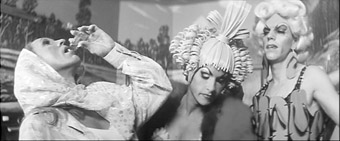
The Adventures of Priscilla Queen of the Desert
Stills courtesy Latent Image/Specific Films
The Adventures of Priscilla Queen of the Desert
I WATCHED THE ADVENTURES OF PRISCILLA QUEEN OF THE DESERT ONLY RECENTLY, SURPRISED TO FIND THAT FOR ALL ITS POPULAR SUCCESS, IT’S A CURIOUSLY TENSE, BICKERING, OFTEN GRIM FABLE OF IRRESOLUTE AUSTRALIAN MANHOOD—WHETHER STRAIGHT, TRANSVESTITE OR TRANSSEXUAL. IT ALSO TREATS ITS WOMEN VERY BADLY. IN AN EARLY EDITION OF REALTIME (RT 4, P4), IN A THREE-WAY DIALOGUE, JACQUIE LO, MERLINDA BOBIS AND HELEN GILBERT TARGETED THE FILM’S APPALLING ACCOUNT OF A VERBALLY AGGRESSIVE FILIPINO WOMAN, ISOLATED IN THE OUTBACK, ENTERTAINING THE PUB LOCALS BY SHOOTING PING PONG BALLS OUT OF HER VAGINA AND UPSTAGING PRISCILLA’S TRANSVESTITE SHOWGIRL TRIO. PHILIP BROPHY ADDRESSES THIS MOMENT AND MANY MORE IN A WICKEDLY ENGAGING NON-LINEAR ANALYSIS OF THE FILM THAT PULSES WITH ODD JUXTAPOSITIONS AND UNEXPECTED ASSOCIATIONS CONNECTING UP DISPARATE ELEMENTS INTO A ‘MAP’ OF THE FILM AND THE CULTURE IT CONJURES AND FROM WHICH IT HAS GROWN.
Roland Barthes wrote somewhere that denotation is the last of the connotations—we come at meaning not directly but through a host of associations. Philip Brophy is a whizz at the art of the semiotic reading of a cultural object, attentive to every aspect of its surface (its “tonality; the weight and porosity of its audiovisual texture”), its edges and layers (its “semiotic verticality and iconic stratification”) and, above all, a network of associations branching out into the greater cultural tanglewood. His is a poetic and highly rhetorical approach, relying often on the power of suggestiveness and he’s a dab hand at sly allusion and irony. Not every assertion convinces, especially when Brophy’s at his most polemic in this brisk 82 page read; dismissiveness comes too easily and some will read it as a clever dick assault on a sacred cultural object, and Australian film with it.
Writing about Priscilla provides Brophy with the opportunity to challenge the “dumb semiotics” of Australian culture and film in particular where the “pre-labelled and self-proclaimed…enforce cultural associations, rather than nurture discovery or allow repulsion.” Familiar tropes and icons are clung to in the name of uniqueness. But they are not meaningful for Brophy: “to me, Priscilla, is as alien as the landscape that greeted the first convicts, prospectors and settlers.” His map of the film, he declares, will be “less an analysis of the film’s dramatic script and its visual narrative, and more an assessment of the signs circulating within the movie.” And he knows he’ll be seen as getting it wrong: “This reading…is irrefutably un-Australian”, but not, he emphasises, Aussie-bashing, though some readers might regard that as spin: “[My] reading celebrates the great nothingness of white Australia and all the heady delusions and spindly neuroses which atmospherically circulate around its engorged mass.”
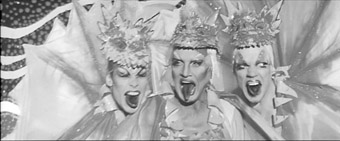
The Adventures of Priscilla Queen of the Desert
Stills courtesy Latent Image/Specific Films
The Adventures of Priscilla Queen of the Desert
In a culture in which so little film analysis is characterful, let alone brave enough to locate film in the big cultural picture, Brophy is very much a felt presence in his little book. He announces up front that “in the spirit of Genet’s self-degrading recoding of the obvious my reading ‘drags’ Priscilla’s appropriation of drag…” He imagines a Genet “time-warped and sent to a penal colony in Australia then jettisoned to a far future on the eve of Priscilla’s lauding at the 1994 Cannes Film Festival…he may have written a book like this one…” For Brophy, ever the outlaw, imprisoned in Australian culture but always breaking out, this is no occasion for cringing humility. The writing is rich in image and metaphor, often pushing into excess to make its mark, but replete with all kinds of drollery in the tradition of the queer outsider—from Oscar Wilde to Quentin Crisp and on to Sandra Bernhard. The smart arse quips—like Roland Barthes as jokester—situates the writer in the history of queer wit rather than with Genet, but the point is taken. As well as unravelling the tangle of visual and aural associations in the film, we need to step right back from the screen to see what’s really going on.
Like his role models Brophy is constantly quotable—“the reminder of the penis is the eternal lump in the throat of the drag body”; Isadora Duncan’s scarf “brand[s] her body as a machine for movement.” There are similes and metaphors that do the job (I’ve cited some of the best and wildest below), and some that don’t: “In a prolixed manner, I am reading Priscilla here as a layer of skin covering the cartilage of the Snowy Mountain Hydro-electric Scheme’s historical formation and logistical machination.” There are moments of wonderful excess like this on the joys of sinking the piss: “Harvested like a primary crop, processed like a pandemic yeast infection, distilled into a simulated urinary liquid, prone to foaming into frothy ejaculate, the sexual aura of beer can only be avoided when one is too drunk to fuck…Its gluttonous intake gears the body into a living pissoir…one might as well piss beer while drinking urine.” There are sentences containing barely submerged song titles and passages where the semiotician lingo fogs meaning. Mostly, the book is a wonderfully grumpy entertainment that makes you think more than twice about the film and the culture of which it is a part.
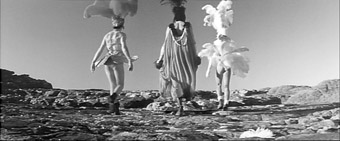
The Adventures of Priscilla Queen of the Desert
Stills courtesy Latent Image/Specific Films
The Adventures of Priscilla Queen of the Desert
Brophy doesn’t read Priscilla for us linearly; he identifies key signs and then joins the dots to cultural associations that might not have occurred to us, mapping signs into a comprehensible guide to the film’s dynamics. The map’s mostly legible and rich in sidetracks and diversions that mostly take you back to the main road. Occasionally you feel you’ve run into a dead end or fallen off the map, trying to hang onto the fit of, say, the pheromonal meaning of women’s scarves. Brophy otherwise puts the scarf to good use, getting Isadora Duncan and her strangulation into the act in his cumulative account of the film’s persistent silencing of women. Its relationship to larger sign posts points to the significance of breath and the trace of the voice. It all happens very fast, and a re-reading helps make better sense.
Above all Brophy is attentive to the sound of film (in his own films and performance, in his Cinesonic column for RealTime in the 1990s, his international conferences with the same title, and his British Film Institute book, 100 Modern Soundtracks). It’s not surprising that breath, voice, accent, popular song, opera and the didjeridu figure potently in his response to Priscilla, looping into a disturbing totality. He starts out with Shirl, a woman, alone amongst a bunch of tough but reticent blokes in an outback pub, who verbally attacks the transvestite trio:
Shirl’s open mouth is the black hole of the white void at the red centre of Australia. Her oral gape is the glassy eye of the film’s sociological hurricane: a raging whorl of misogynist energy that spins around this charade of a butch dyke…Shirl is like all nagging wives: a bitch to be shut up. And to be shut up by a British trans-sexual [Terence Stamp as Bernadette]—now that’s Australian comedy.
Brophy’s writing here, as elsewhere, is itself “a raging whorl”, sucking a host of associations into its vortex and swirling towards its destructive, knockout punch line. Then the storm starts up again slowly building to a series of coups de grâce, via discussion of the inflatable doll atop the bus, the opera soprano and the film’s breathing (the central characters “develop less through a series of trials and tribulations and more through an arrhythmic concatenation of inflated and deflated moments”). He writes, “all [the women] are defined by the means by which air fills their being. The doll is blown up, the drag queen is puffed out, and the female corpse is pumped within.” The film’s use of the opera aria allows Brophy to drive home the governing “necrotic” (his compounding of necrophilic and erotic) dimension of Priscilla while giving him room to comment on opera as drag. He sees opera “as a form of drag in the first place—a woman performing a man’s creation…Controlled by the Promethean impulse of the composer she bears his breath.” The result, Brophy thinks, is “the anodyne resonance of pure tone”, at a remove from real emotion and deadly: “For when Verdi’s aria is smelted from the hovering inflatable sex doll, death is in the air.”
It’s a short trip from opera to musical, since in Priscilla there are ‘live’ songs as well as mime. Again Brophy joins the dots between breath, voice, drag and death: “Ultimately, all Musicals are drag revues” because they use lip-synching, just as in drag mime “which creates the ghostly aura of a human presence.” Shortly, in the same terms, he addresses the drag queen’s narcissistic appropriation of the torch singer. The argument is dark and arresting but just when you suspect you’ve been lead into some semiotic back block, Brophy guides you back to the film’s central trio—and their voices.
By now, Brophy has detected that for all the film’s inflation (its uplifting horizons and aerial views) there is a prevalent depressive and necrotic deflation. On the matter of voice, he observes of the trio that “they flip between displays of tartiness and blokiness, the former with physiological ineptitude and the latter with theatrical inexactitude.” He connects the limited binary being of these men with John Mellion’s VB beer television advertisements, tourist industry images of Australia (and of much Australian film) and a persistent national ailment: “contrary to its gay portraiture, Priscilla captures the sexual confusion that foams around the churning waters of gender divisions which so desperately chart Australia’s ongoing frontier roughness and the brute ways in which male and female are cleaved from the other.” Never mind the clunky metaphor mix, Brophy’s point is clear—while the film might throw up a mass of complex associations, it’s still represents a “dumb semiotics”, un-nuanced, un-gay and deeply prejudiced.
Priscilla, like many an Australian film for Brophy, has ignored alternative voices, appropriated and transformed them into standardised Australian signs, sucking the breath out of difference. But gay culture itself is also problematic: “Post-70s, gay culture’s officiated alignment with notions of ‘pride’ and ‘community’ effectively closed off the perversity of a pre-gay epoch. In the process it partially normalised the aberrant power born—no matter how problematically—from exploring identity potentiality beyond the barriers set by heterosexual identity.” This culture is now progressively de-queering a unique heritage: “Far from being oppressed, hamstrung or constricted, sexual identity in early to mid-20th century gay subculture was utilised as a proto-totemic signifier ripe for subversion, inversion and conversion.”
Up to now Brophy has written little if anything about Australian film composition and sound design. Now with apt perversity, he’s taken on a film he dislikes in itself and for what it represents about Australian film and culture and does it bizarrely great service, if nonetheless condemning it for the crude binarism of its dumb semiotics. He has discovered that “[t]he film is a labyrinthine text, honeycombed with signifying pathways fragmented by multiple modes of performance and characterisation…” He is taken with Priscilla’s music: “I find that the innate novelty, studio trickery, sonic complexion and lurid narratives of nearly all the 70s songs dragged in and throughout Priscilla create a lasting aural depth within the film’s audiovisual assemblage…as if the cinematic veneer of its construction cannot contain the energy of the songs and their original performance.” In the end Brophy wonders, “maybe the phenomenon of Priscilla has little to do with cinema.” Its appeal resides everywhere else in the cultural map of which it’s part but not in the film itself.
For Brophy, The Adventures of Priscilla Queen of the Desert turns out to be a treasure trove of songs and other cultural signage—the good, the bad and mostly the ugly. The bottled turd of Agnetha (of ABBA fame) epitomises gay and straight male misogyny, the treatment of the Filipino, Cynthia, is “one big gang bang”, the attitude to Aboriginal people is assimilationist and the musical finale with the trio dressed as Australian native fauna is a performance which “remains nothing but inhuman, as they shift representation of Woman to a series of animalistic, reptilian and monsterised figures.”
But the film has worth, it seems, if only as a mirror image of our culture—one which has to be read with the Brophy map in hand: “Priscilla’s straight eye on a queer world grants us the most potent symbolic condensation of this uniquely Australian self-distorted portraiture…this dark jewel of popular culture is a mystical stone which especially grants male Australia the power to see itself for what it really is.”
Brophy’s book is a challenging read, in the best sense, and good fun, witty and instructively gross by turns. My major reservation is that the only other Australian feature film mentioned (also disparagingly) is Muriel’s Wedding and there’s a passing reference to several outsider films: Wake in Fright, The Coca Cola Kid and Where The Green Ants Dream. Brophy’s blanket reading of all Australian feature film as locked into the nationalist syndrome is wearyingly absolutist for a writer who otherwise reads film and the world complexly, but don’t let this deter you from a scintillatingly good read.
Jane Mills, the series editor of Australian Film Classics, made one of her best choices in assigning The Adventures of Priscilla Queen of the Desert to Philip Brophy. As with most of the series to date she has wisely avoided predictable choices, reaching beyond the industry itself, the academy and reviewers. I’m looking forward to the latest instalment, Henry Reynolds on Fred Schepisi’s The Chant of Jimmie Blacksmith.
Philip Brophy, The Adventures of Priscilla Queen of the Desert, Australian Screen Classics, series editor Jane Mills, Currency Press, Australian Film Commission, Sydney, 2008
RealTime issue #85 June-July 2008 pg. 26
© Keith Gallasch; for permission to reproduce apply to realtime@realtimearts.net
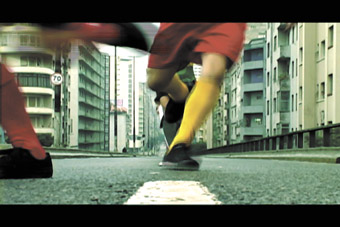
Varzea
CHOPSTICKS WITH EMBEDDED CAMERAS? OIL PRICES AS DATA SOURCE FOR ABSTRACT VISUAL GENERATION? DISPOSABLE SURVEILLANCE CAMERAS? TIMELAPSE SCREENSHOTS UPLOADED FROM YOUR RECENTLY STOLEN COMPUTER? ANIMATED TALKSHOWS SET INSIDE COMPUTER GAMES? YOUTUBE? NICHE DVD LABEL CREATION WITH A WEBSITE AND $100 BURNER? LIVE MOBILE-PHONE-VIDEO-TO-WEB-TO-MOBILE-PHONE? THE POSSIBILITIES FOR CREATING, DISTRIBUTING AND VIEWING VIDEO CONTINUE TO EXPAND, NECESSARILY MAKING IT MORE COMPLICATED TO DEFINE VIDEO ART, OR DISTINGUISH WHAT PARTS OF IT OVERLAP OR INTERSECT WITH CINEMA, TV, VJING, VIDEO BLOGS AND THE CONTINUOUS SPRAWL OF CONTEMPORARY ART-MAKING THAT CAN INCLUDE THE MOVING IMAGE. THAT BOUNDARY BLUR BETWEEN CINEMA AND VIDEO ART IS THE FOCUS OF A D/LUX/MEDIA/ARTS’ PROGRAM OF SCREENINGS, EXHIBITIONS AND FORUMS IN JUNE. ALL OF THIS IS A LONG-WINDED WAY OF SAYING, A PAIR OF PREVIEW DISCS ARRIVED IN THE MAIL TITLED VIDEOBRASIL.
In October last year Sao Paulo, a city with more breathing humans than all of Australia, hosted the 16th annual Videobrasil Video Art Festival [RT82, p26]. Its theme? Exploring the convergences of “video, cinema and the visual arts.” Downtown Sao Paulo obviously made an impression on d/Lux, as they’ve decided to import two sets of those screenings along with the director of Videobrasil, Solange Farkas. The Videobrasil website still gives off ghostly echoes of what seems like a vibrant festival (in which many Australian artists have featured over the years), a great range of forums, plenty of exhibitions, provocative international guests (eg Peter Greenaway, Kenneth Anger, Dutch curator Tom van Vliet talking about 360º projection panoramas etc) and a vast collection of video art screenings, including the following prizewinners from the Videobrasil 2008 Jury Selection:
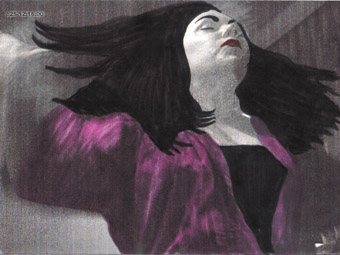
Revolving Door
Revolving Door, David and Alexandra Beesley [Australia]
Nice to see a pair of Melbourne animators collect a prize on the international stage, and quite deservingly too, for their painstakingly animated (14,000 frames of rotoscoping anyone?) and well nuanced documentary about prostitution in St Kilda. Amazingly, they started working on the documentary in 1989, albeit in a more conventional video documentary style, so the recent spate of awards must be gratifying. The animation technique employed perhaps facilitates easier empathy with the various characters, and the well structured script ensures the social impacts of prostitution are provocatively presented. More at the companion website: www.beeworld.net.au/rdoor.
Rawane’s Song, Mounira Al Solh [Lebanon/The Netherlands]
“I got jealous of those artists who were able to do an artwork related to identity matters and I was particularly pissed off by the ones who came from a war background and knew how to talk about it”, Mounira reveals via on-screen text before juxtaposing her own handicam footage of her bright red shoes walking around her studio. This is interpolated with more text of her personal history and art projects, and her attempts to reconcile the differences between personal and national identity. Cute video, from the three chords and a guitar school, getting its wings from the more insightful text commentary.
Juksa, Mauricia Dias & Walter Reidweg [Brazil/Switzerland]
Because of the screening context, or because video art might have an emphasis on ideas and provocations or on exploration of form, we accept or even expect lower production values than we might within cinema. On the other hand, while Dias and Reidweg’s premise had merit, revisiting characters in a remote Norwegian village who had been interviewed on video 30 years before, a combination of bad editing, badly overexposed footage, badly fitting motion graphics and a pretentious scene of an opera singer framing the film on the beach, killed for me material that deserved better.
Varzea, Estudio Bijari & Ricardo Lazzetta [Brazil]
With South American vigour, a sports commentator as narrator asks us, “Victory against who? Will nostalgia be able to remind us of our life’s finitude?” and continues a blistering pace, while aerial shots display incredible urban density, then ground shots reveal characters in a range of colourful soccer jerseys running through the concrete spaghetti highways below. Abruptly the commentary stops and, against melancholic violin, each of the runners slides about on a muddy, grassless soccer field (Varzea=’muck’), in smooth slow motion cinematic style.
half-time, change sides
Brazil has won the soccer World Cup more times than any other country, but how would they fare in a World Cup of video-art-meets-cinema compilations based on this selection? In trying to gauge the merits of Videobrasil, you necessarily run up against comparisons with large traditional film festival compilations (which offer higher production values), or digital media festivals such as onedotzero, Resfest (both offering much higher technical innovation). Inevitably, you are judged against abundant web video channels and, inevitably, short films recently popularised online and as provocative as anything on this compilation (eg from neighbouring Argentina’s blublu.org). It’s partly that context question though. Some of these works would seem better in an installation, where higher cinematic expectations mightn’t be placed on them. Hey Brazil, you can’t win them all. But eat your oranges up and see what you can do in the second half—the Videobrasil 2008/2009 Residency Program which offers support to selected artists who have competed in the festival competition screenings.
Canto Doce Pepequeno Labirinto, Caetano Dias [Brazil]
No idea why this is international festival prizewinning video art. It seems worthwhile enough, building a large edible sugar sculpture in a public place, a railway station, but is a very basic video documentation of a small public art project.
Canto de Aves Pampeanas 1, Nicolás Testoni [Argentina]
File under ‘better off as an installation’, a series of fixed camera long shots of landscapes; industry as always encroaching on the traditional terrain; not particularly enthralling shots.
Untitled (Zimbabean Queen of Rave), Dan Halter [Zimbabwe/South Africa]
A cheesy diva rave anthem (everybody’s freeeeee, feels good…) serves as a backdrop to show white crowds dancing at raves juxtaposed with black crowds on the streets demonstrating. Anything that can illuminate disparity seems useful, but there’s not much going on here.
Abismo Virtual, Eustáquio Neves [Brazil]
Grainy mobile phone video in which a scattering of illustrations and text explore the strange, disembodied communications we have available today, connected and disconnected.
Weekend, Federico Lamas [Argentina]
Innovative on a number of levels, this video uses a series of voice bubble post-it notes to provide English subtitles for some domestic scenes played out in vertical strips, each sliding the previous scene further to the left of the screen. There it continues to play out, eventually providing around four or five overlapping slices of time simultaneously, complete with previous post-it note dialogue intact. The sense of playfulness continues over time, adding variations to its novel multi-layered looping universe.
Videobrasil 2008-09 tour, d/Lux/Media/Arts; for program and dates go to www.dlux.org.au/artcinema.
RealTime issue #85 June-July 2008 pg. 25
© Jean Poole; for permission to reproduce apply to realtime@realtimearts.net
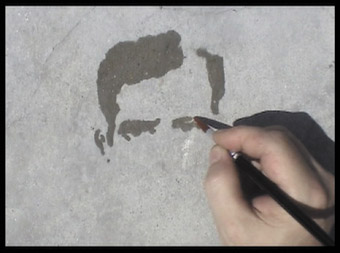
Óscar Muñoz, still from Proyecto para un memorial (Project for a Memorial) 2003-05
courtesy of the artist and Sicardi Gallery
Óscar Muñoz, still from Proyecto para un memorial (Project for a Memorial) 2003-05
HIRAKI SAWA’S SIX GOOD REASONS TO STAY AT HOME, WHICH THE NATIONAL GALLERY OF VICTORIA EXHIBITED CLOSE TO EIGHTEEN MONTHS AGO, REMAINS THE SINGLE MOST IMPRESSIVE EXHIBITION OF VIDEO WORKS I HAVE SEEN IN MELBOURNE. LIKE THE LATE JEREMY BLAKE’S DIGITAL PAINTINGS, SAWA’S DREAM-LIKE EXPLORATIONS OF THE DOMESTIC SPHERE ARE PRECISELY THE SORT OF VIDEO ART THAT IS WORTHY OF THE TITLE. LIKE AN EXCELLENT PAINTING OR PRINT, THESE VIDEOS DEMAND TO BE PROJECTED ONTO A WALL, ADMIRED FOR THE BEAUTY OF THEIR FORM AND THE INTELLIGENCE OF THEIR REALISATION. MUCH VIDEO ART, ADMIRED EITHER FOR SHOCK VALUE OR FOR OUTRIGHT UNWATCHABILITY, DEMANDS TO BE TURNED AWAY FROM.
The NGV’s current exhibition, Resonant Visions: Contemporary Video from Latin America, is less successful than some of the gallery’s previous events. As an overview with only three works, it is obviously incomplete, perhaps serving as the most threadbare of introductions.
Óscar Muñoz’s Proyecto para un memorial (Project for a Memorial), 2003-05, is the strongest of the three pieces, primarily for the manner in which it manages to operate across multiple levels of meaning. Controlled by an unseen hand, a paintbrush dipped in water dashes off a portrait on a canvas of cold, grey concrete. The face is dark and serious, its features detailed enough to be legible without our seeing into its eyes. The portrait finished, the brush moves on to another of the installation’s five screens, where it promptly begins work on another face. But as soon as it does so, the first image begins to evaporate. By the time the paintbrush has started work on its third or fifth portraits, the original face has faded to the point where only two small splashes of water remain, where the eyes used to be. It’s a bit like watching Henri-Georges Clouzot’s Le Mystère Picasso (1956) in reverse. An ostensible lament for the disappeared persons of Latin America, the work might also be seen as a profound meditation on the ephemerality— perhaps even the essential hopelessness—of art.
By contrast, Sebastian Diaz Morales’ Lucharemos hasta anular la ley (We shall fight until the law is cancelled), 2004, has only its political meaning to bet on: everything else comes second to the expression of the political sentiment. However, Diaz Morales aestheticises his source footage of political violence in Buenos Aires to such an extent that both his political and aesthetic points are unnecessarily blunted. On the one hand, the various filters and slow-motion effects applied to the video’s documentary source footage render the concrete struggles it depicts suddenly abstract and unreal. On the other hand, the knowledge that this violence is real renders the aesthetic effects merely and intrusively decorative, detracting from any affective charge they may have carried in and of themselves.
While Diaz Morale’s work highlights the problems with video art as a medium for political expression, the manner in which the three works have been forced to share the exhibition space with one another highlights the inherent problems with the art gallery as a site of exhibition.
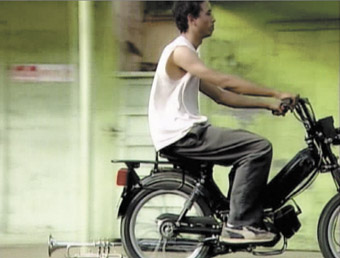
Jennifer Allora and Guillermo Calzadilla, still from Returning As Sound (2004)
courtesy of the artists and Galerie Chantal Crousel, Paris
Jennifer Allora and Guillermo Calzadilla, still from Returning As Sound (2004)
This is particularly true of the weakest of the three works, Jennifer Allora and Guillermo Calzadilla’s Returning a sound, 2004. A perfect example of how contemporary art has a tendency to rely too heavily on the discourse of the artist for its meaning, the work is a six-minute video showing a young man riding through luscious countryside on a motorcycle fixed with a trumpet for a muffler. It makes the bike sound a little like an agitated wasp.
Reading the room notes a little later, the work’s political import becomes fully apparent: the young man is in fact a symbol of civil disobedience; the luscious countryside is that of Vieques, an island off Puerto Rico used by the US Navy as a weapons-testing range from 1941 to 2003; and the trumpet is a symbol of US military might, re-appropriated by the people of the island (and, one assumes, their motorbikes). This is all very well and good, except that, on its own, the work expresses none of this and in fact comes across as little more than a novelty. Shot and cut in conventional chronological order, the video’s only formal interest is in the varying pitch of the buzzing trumpet-exhaust, though the aural possibilities of this device are not explored in any systematic manner. What’s more, the works with which Returning As Sound shares gallery space are almost completely silent, and the motorcycle’s six-minute solo permeates one’s experience of these pieces in a manner not entirely at one with their intended effects.
Indeed, one leaves the exhibition with a niggling suspicion that a gallery space was not the right place for it. A cinema might have been more appropriate. The point of difference between video art and experimental film is left looking all forlorn.
Resonant Visions: Contemporary Video from Latin America, UBS Contemporary Art Galleries, NGV International, Melbourne,
Feb 16-Aug 17
RealTime issue #85 June-July 2008 pg. 24
© Matthew Clayfield; for permission to reproduce apply to realtime@realtimearts.net
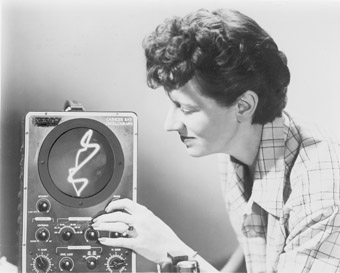
Mary Ellen Bute (USA), pioneer of visual music and electronic art
courtesy of GoMA
Mary Ellen Bute (USA), pioneer of visual music and electronic art
WITH CENTURIES OF NEAR-CONTINUOUS PRACTICE, THE ART OF VISUAL MUSIC HAS FASCINATED AND OBSESSED COUNTLESS ARTISTS AND SPECTATORS. THE 24 SESSIONS OF THE AUSTRALIAN CINEMATHEQUE AT THE GALLERY OF MODERN ART’S VISUAL MUSIC PROGRAM ARE BOTH AN IDEAL ENTREE FOR THE UNINITIATED AND A KIND OF ABSTRACTIONIST CRACK FOR THE LEGION OF FANS OF THIS HYBRID GENRE. EXCITEMENT GREETED THE COMMENCEMENT OF THIS PROGRAM, WHICH IS SHAPED BY THE MAJOR 2005 SURVEY SHOW AT THE LOS ANGELES MUSEUM OF CONTEMPORARY ART AND THE HIRSHHORN MUSEUM AND SCULPTURE GARDEN IN WASHINGTON DC IN THE SAME YEAR. AS THE INTRODUCTION TO THAT SHOW’S CATALOGUE STATES, THE HISTORY OF VISUAL MUSIC IS THE HISTORY “OF A REVOLUTIONARY IDEA: THAT FINE ART SHOULD ATTAIN THE NON-REPRESENTATIONAL ASPECTS OF MUSIC.”
The GoMA Visual Music program explored ways in which film and fine art have historically conversed, through the lens of what is variously referred to as colour music, motion painting, lumia, and non-objective film. What transpired was more a survey of the international cinematic practice of visual music, with all the criticisms to do with the limitations of scope, alongside accolades of significant achievement, that such a survey was inevitably going to attract.
One of the show’s most noteworthy events was the extensive Silly Symphonies program featuring the lively animated audio-visual choreographies of folk tales and nursery rhymes produced by Walt Disney between 1929 and 1939. The 35 Silly Symphonies films, not part of the Hirshhorn show, were framed with an introduction by Russell Merritt, co-author of a recent book on these early musical animations. Beautiful 35mm prints gave audiences an opportunity to re-live (or experience for the first time) the dynamism of classics such as The Ugly Duckling (1939) and the still creepy Babes in the Woods (1932). Silly Symphonies highlighted what the young Cinematheque, so far, does best: marshall its formidable resources to produce an eye-popping assemblage of historically important works. Securing the prints alone for this, the most comprehensive collection of its kind ever to be presented internationally, is doubtless a serious achievement. While I couldn’t help remembering, as The Big Bad Wolf (1934) screened, the stories of strike actions by un-screen-credited, unhappy and exploited Disney animators (allegedly ‘compensated’ for chronic underpayment with ‘Disney family cameraderie’), and was nagged by the other persistent dark rumours about Uncle Walt’s red-baitin’ habits, this program was nonetheless an unqualified, blue-ribbon triumph.
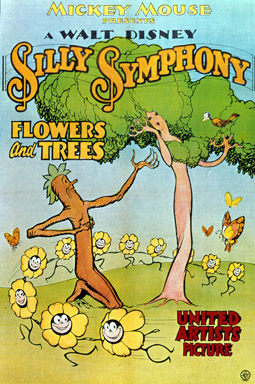
poster Silly Symphonies
courtesy of GoMA
poster Silly Symphonies
Other invaluable linkages between the art of visual music and the mainstream motion picture industry are made in the Saul Bass program. Regarded as the father of the modern film title sequence, Bass’s acid-bright Lissajous spirals in the opening credits and subjective vertigo sequences of Hitchcock’s 1958 gem are a reminder of the cooler, more mathematical modality of psychedelic art. Of course, the program essentially belongs to the hotter, pansensual, consciousness-expanding variety of psychedelia and its various cinematic and machinic iterations by generations of artists, filmmakers and scientists. The incredible Rare Classics program, curated by GoMA guest Cindy Keefer of the Center for Visual Music in LA, was a prime example of the kaleidoscopic approach to moving abstraction by numerous artists in the early-to-mid 20th century.
The Rare Classics program abounded with priceless opportunities to witness the genre’s often-referred-to-but-rarely-seen works, such as John Stehura’s pioneering (1960-1965) computer animation, Cibernetik 5.3, Jud Yalkut’s decidedly brown-acid Turn, Turn, Turn (1966) and some mind-blowing footage from early expanded cinema performances. Along with the unforgettable experience of witnessing the ‘recreation’ film of Oskar Fischinger’s R-1 ein Formspiel (c1926-1933), from his 1920s (!) multiple-projector performances (restaged by William Moritz/Fischinger Archive), there was extraordinary conservation footage of Charles Dockum’s 1952 MobilColor Performance at the Guggenheim Museum (still the Museum of Non-Objective Painting at that time). Watching the latter was, for me, an inescapably dual experience: on the one hand, the sensuously deliquescing rainbow fields emanating from this seminal colour organ were among the purest of visual highs, on the other, the knowledge that Dockum spent so much of his life on work which had (at most) a couple of outings generated wracking sympathy pains. In a move that resonates unpleasantly with the position of fine art film in art institutions in general, the Guggenheim, angered that the machine (which had been part of the inventor’s visual music exploration for nearly 20 years) didn’t play endlessly on a loop and required operators, trashed the MobilColor projector for parts.
No less heart-breaking was the extensive screenings of films from the distinguished career of Stan Brakhage, featuring the characteristic jewel-hued swirls of translucent aniline dyes which, applied with fingers to film stock, gave the avant-garde godfather the cancer which killed him in 2003. Brakhage’s very embodied visual music, often analogised to Abstract Expressionism, epitomises what Amelia Jones has called the “Pollockian impulse” to register the ‘presence’ of the artist in the traces of gestural marks; here not on canvas laid on the floor, but filmstrips stretched over a lightbox—in Jones’ words, “’proof’ of the vigorous act of making.” Brakhage’s reference to his work as “visual music” and “moving visual thinking” definitely justifies the inclusion of this work in the program. However, a cavernous distance between his and other work in the direct animation mode also on show, such as the always awesome Harry Smith (1949’s Early Abstractions) or Len Lye’s work, highlighted some of the missed opportunities for reflecting on the field’s nuances. The dead-set, high church, silent purism (‘visual’ music) of avant-garde film’s high priest couldn’t be further from Lye’s joyous contortions to sexy swing songs or Barbell Neubauer’s synaesthetic, in-your-face techno assault (some of the only contemporary work to make it into the show).
Other ideas of what comprises visual music—that made by colour organs and played as analogous to music, the history of correspondences between musical notes and colours of the spectrum, silent abstract films which ‘aspire to the condition of music’, synaesthetic seeing-sound experiences—were glossed over, probably necessarily, given the inevitable limitations of scope. This forced conflation may be important in consolidating the history and the acceptance of a distinctive artform.
A more worrying omission is the Australian history of this work. The show’s impressive coverage of other international works unfortunately provides the concomitant, and wrong, impression that no such similar work has been attempted here. On the contrary, there is a fascinating, if more difficult to tap, history of visual music in Australia for which a high profile show such as this could have provided much needed exposure. Considering what a fantastic opportunity this was to explore the commensurability and possibilities of exchange between the worlds of fine art, avant-garde film and popular practices, the work of Australia’s experimental filmmakers and video artists could have been slipped into even a single program session at tremendous benefit to that history, its artists, our audiences and the institution. All the canonical Australian avant-garde filmmakers have made films which are either abstract (a ‘visual’ music a la Brakhage) or impressions/interpretations of sound—Arthur & Corinne Cantrill (and their son, Ivor), the Ubu group (specifically Albie Thoms and David Perry; all their handmade work qualifies under the terms GoMA sets), Dirk de Bruyn, Paul Winkler, Michael Lee, George Gittoes and Jonas Balsaitis. Among contemporary film and video artists are Lee Smith, Eric Roberts, Lloyd Barrett, Andrew Lyons, Jonathon Duckworth, Ernest Edwards and others.
Even considering the immense pressures the staff must be under, and the tight time frames for the production of the show, surely the difficulty of curating this work should not relieve the institution of the task of attempting to incorporate an Australian dimension. If it’s not the province of a premium screen organisation such as the Australian Cinematheque to seek out and present this work then it’s hard to see whose it could be. Unsurprisingly, Australian avant-garde filmmakers who attended sessions suggested to me that the kinship they felt with Dockum extended beyond an interest in resplendent abstract aesthetics.
When we weren’t being unceremoniously evicted from post-screening afterglow foyer discussions, wandering the beautifully polished concrete halls left an impression of a workplace still reeling a bit from the mammoth summer Warhol blockbuster. It’s very understandable that Australian work, invisible and championed mainly by artists and collectives from the shabbier reaches of film culture, should continue to fly (somewhat wonkily) under the radar. But to me it’s ineffably sad. None of these criticisms can detract, however, from the fact that the Visual Music program represents a remarkable achievement, which would have provided even the most casual of its hundreds of visitors with an intoxicating whiff of one of our planet’s most appealing and enduring artforms.
Visual Music screening program, Australian Cinematheque, Gallery of Modern Art, South Bank, Brisbane, March 28-June 1
RealTime issue #85 June-July 2008 pg. 23
© Danni Zuvela; for permission to reproduce apply to realtime@realtimearts.net






























![Lindzee & Steve [Wilkinson] under the Brooklyn Bridge](https://www.realtime.org.au/wp-content/uploads/art/19/1971_reck_underbrooklynbridge81.jpg)


















![En La Ciudad de Sylvia [In the City of Sylvia]](https://www.realtime.org.au/wp-content/uploads/art/19/1942_city_of_sylvia.jpg)















































